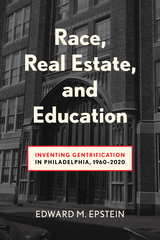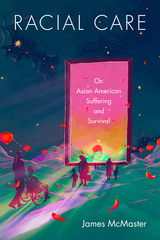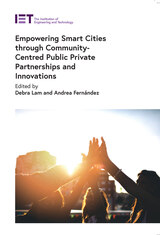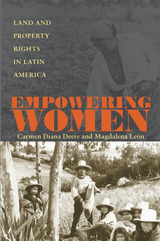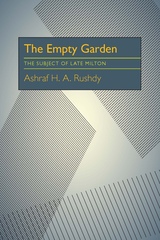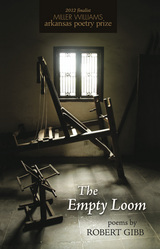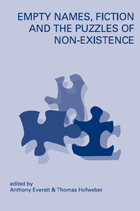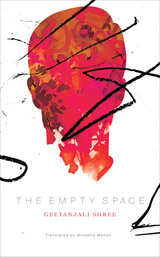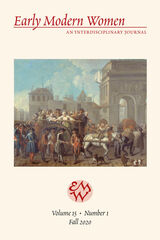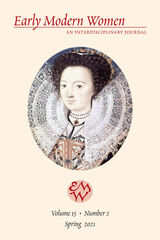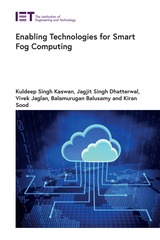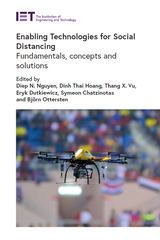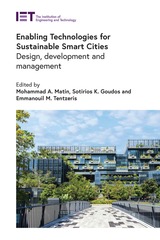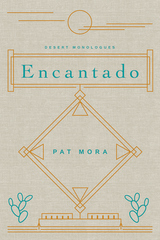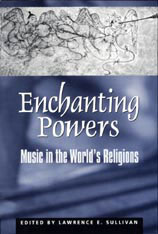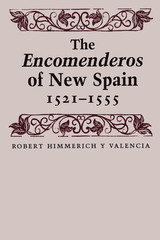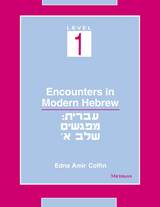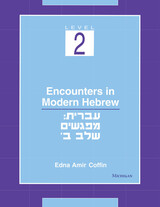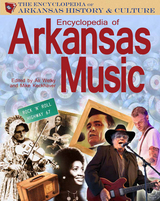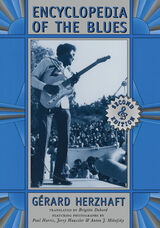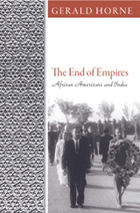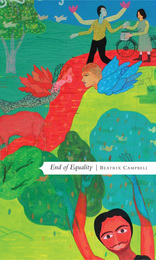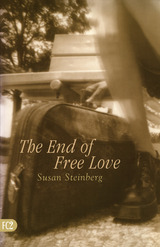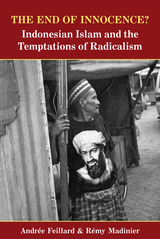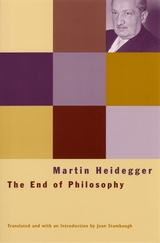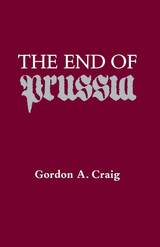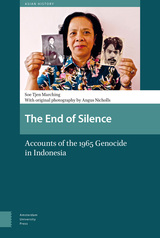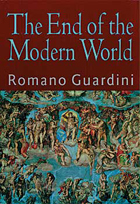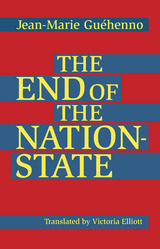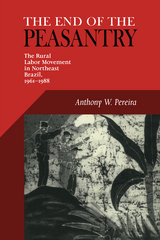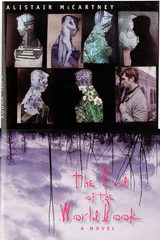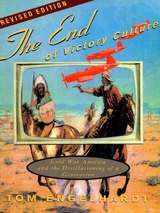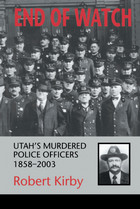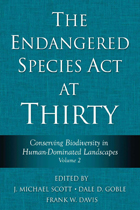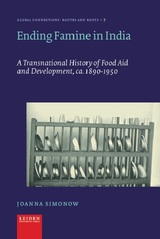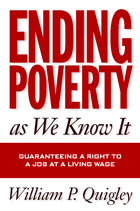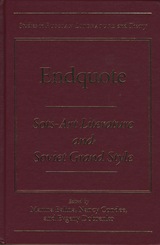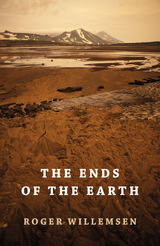Empowering Smart Cities through Community-Centred Public Private Partnerships and Innovations
Debra Lam
The Institution of Engineering and Technology, 2024 Cities are at the heart of the biggest challenges facing humanity - from the cost-of-living crisis to the COVID-19 pandemic, to climate change to inequality and social injustice. Local governments around the world are facing increased expectations to support the transition to a more just and sustainable society and are under pressure to do more with fewer resources. Rapid urbanization is creating significant pressure on cities to expand and improve housing and infrastructure, and improve social equity, health and quality of life, all while fostering a robust economy that can provide good jobs for all. Nonetheless, cities are also our best hope for the future and remain at the heart of economic growth, innovation and job creation.
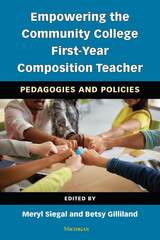 Empowering the Community College First-Year Composition Teacher: Pedagogies and Policies
Meryl Siegal and Betsy Gilliland
University of Michigan Press, 2021 Community colleges in the United States are the first point of entry for many students to a higher education, a career, and a new start. They continue to be a place of personal and, ultimately, societal transformation. And first-year composition courses have become sites of contestation.
This volume is an inquiry into community college first-year pedagogy and policy at a time when change has not only been called for but also mandated by state lawmakers who financially control public education. It also acknowledges new policies that are eliminating developmental and remedial writing courses while keeping mind that, for most community college students, first-year composition serves as the last course they will take in the English department toward their associate’s degree.
Chapters focusing on pedagogy and policy are integrated within cohesively themed parts: (1) refining pedagogy; (2) teaching toward acceleration; (3) considering programmatic change; and (4) exploring curriculum through research and policy. The volume concludes with the editors’ reflections regarding future work; a glossary and reflection questions are included.
This volume also serves as a call to action to change the way community colleges attend to faculty concerns. Only by listening to teachers can the concerns discussed in the volume be addressed; it is the teachers who see how societal changes intersect with campus policies and students’ lives on a daily basis.
 Empowering the Public-Private Partnership: The Future of America’s Local Government
George V. Voinovich
Ohio University Press, 2017 America’s cities are increasingly acknowledged as sites of renewal and economic opportunity—but how can city leaders facing physical and financial constraints harness this positive energy to create sustainable development? The story of Cleveland in the early 1980s provides the necessary roadmap. Mayor George V. Voinovich, by drawing on the combined strengths of the public and private sectors, took Cleveland from financial default to becoming “America’s Comeback City,” and he later used the best practices he developed there to tackle state-level challenges as governor of Ohio. The public-private partnership model that Voinovich pioneered has since become the gold standard for cities seeking to maximize resources. Using lessons from Cleveland, Voinovich developed this handbook for governments and private entities seeking a mutually enriching partnership. It is his legacy to those who will guide America’s cities to new growth and vitality.
Empowering Women: Land And Property Rights In Latin America
Carmen Diana Deere
University of Pittsburgh Press, 2001 The expansion of married women’s property rights was a main achievement of the first wave of feminism in Latin America. As Carmen Diana Deeere and Magdalena Leon reveal, however, the disjuncture between rights and actual ownership remains vast. This is particularly true in rural areas, where the distribution of land between men and women is highly unequal. In their pioneering, twelve-country comparative study, the authors argue that property ownership is directly related to women’s bargaining power within the household and community, point out changes resulting from recent gender-progressive legislation, and identify additional areas for future reform, including inheritance rights of wives.
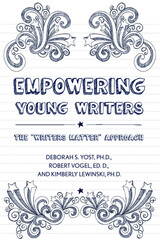 Empowering Young Writers: The "Writers Matter" Approach
Deborah S Yost
Temple University Press, 2014 Launched in middle schools in the fall of 2005, the "Writers Matter" approach was designed to discover ways to improve the fit between actual English curricula, district/state standards and, more recently, the Common Core Curriculum Standards for writing instruction. Adapted from Erin Gruwell's successful Freedom Writers Program, "Writers Matter" develops students' skills in the context of personal growth, understanding others, and making broader connections to the world. Empowering Young Writers explains and expands on the practical aspects of the "Writers Matter" approach, emphasizing a focus on free expression and establishing connections between the curriculum and students' personal lives. Program creator Robert Vogel, and his co-authors offer proven ways to motivate adolescents to write, work diligently to improve their writing skills, and think more critically about the world. This comprehensive book will help teachers, administrators, and education students apply and reproduce the "Writers Matter" approach more broadly, which can have a profound impact on their students' lives and social development.
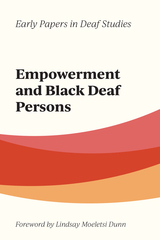 Empowerment and Black Deaf Persons
Lindsay Moeletsi Dunn
Gallaudet University Press, 2024 Empowerment and Black Deaf Persons is a collection of papers from a 1990 conference that brought together an audience of mostly Black Deaf and hearing people to address three themes: leadership and advocacy, the dynamics and dilemmas of being multiply marginalized, and issues related to language and community. Scholars, students, and community members will find this volume invaluable for understanding the origins and evolution of Black Deaf Studies. Lindsay Dunn, co-chair of the original conference, contributes a new foreword, offering contemporary insights and reflections.
This is the inaugural volume in the Early Papers in Deaf Studies series, which will consist of reissued works originally published by the Gallaudet University College for Continuing Education but long out of print. The aim of this series is to restore these foundational papers to the scholarly community. Empowerment and Black Deaf Persons is available in both print and open digital formats, ensuring broad access to this important contribution to the literature.
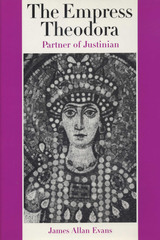 The Empress Theodora: Partner of Justinian
By James Allan Evans
University of Texas Press, 2002 Even by modern standards, the Empress Theodora (?-548) had a remarkable rise to power. Born into the lowest class of Byzantine society, she worked as an actress in burlesque theater. Yet she attracted the love of the future emperor Justinian, who, to the astonishment of proper society, made her not only his wife but also his partner in government. Justinian's respect for and trust in Theodora gave her power in her own right unmatched by almost any other Roman or Byzantine empress. In this book, James Allan Evans provides a scholarly, yet highly accessible account of the life and times of the Empress Theodora. He follows her from her childhood as a Hippodrome bearkeeper's daughter to her imperial roles as Justinian's most trusted counselor and as an effective and powerful advocate for the downtrodden. In particular, he focuses on the ways in which Theodora worked to improve the lives of women. He also explores the pivotal role Theodora played in the great religious controversy of her time, involving a breach between sects in the Christian church.
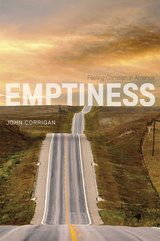 Emptiness: Feeling Christian in America
John Corrigan
University of Chicago Press, 2015 For many Christians in America, becoming filled with Christ first requires being empty of themselves—a quality often overlooked in religious histories. In Emptiness, John Corrigan highlights for the first time the various ways that American Christianity has systematically promoted the cultivation of this feeling.
Corrigan examines different kinds of emptiness essential to American Christianity, such as the emptiness of deep longing, the emptying of the body through fasting or weeping, the emptiness of the wilderness, and the emptiness of historical time itself. He argues, furthermore, that emptiness is closely connected to the ways Christian groups differentiate themselves: many groups foster a sense of belonging not through affirmation, but rather avowal of what they and their doctrines are not. Through emptiness, American Christians are able to assert their identities as members of a religious community.
Drawing much-needed attention to a crucial aspect of American Christianity, Emptiness expands our understanding of historical and contemporary Christian practices.
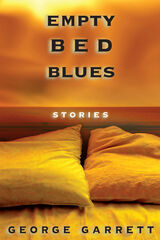 Empty Bed Blues: Stories
Stories by George Garrett
University of Missouri Press, 2006 The fifteen stories of George Garrett’s Empty Bed Blues (his eighth book-length collection) are vintage Garrett—no two alike—with each moving, one way and another, in new and daring directions. His stories are deeply concerned with the old verities of love and death and filled with the joys and woes of characters who come to life and command our attention. Diversity is the key word for Garrett’s short fiction. He works in every known form and invents a few himself. In “A Story Goes with It,” Garrett fondly remembers an old friend while retelling a story the man once told him. Most of it is probably not accurate, as Garrett is quick to admit, but the mixture of fact with fiction makes for an entertaining read. His stories turn like the sharp curves of a mountain road, abruptly changing from a fond trip down memory lane to a sleazy reporter’s quest along the backroads for the ultimate crime story in “Pornographers.”He tops off his collection with “A Short History of the Civil War,” a series of poems written by two participants: one a Confederate, the other a Yankee. In the marriage of fact and fiction, of comedy and pathos, and the music of many voices, the stories of Empty Bed Blues reconfirm the judgment of novelist and story writer Richard Bausch, who said in 1998: “There is no writer on the American scene with a more versatile, more eclectic, or more restless talent than George Garrett.”
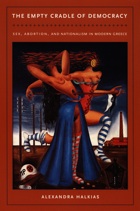 The Empty Cradle of Democracy: Sex, Abortion, and Nationalism in Modern Greece
Alexandra Halkias
Duke University Press, 2004 During the 1990s, Greece had a very high rate of abortion at the same time that its low birth rate was considered a national crisis. The Empty Cradle of Democracy explores this paradox. Alexandra Halkias shows that despite Greek Orthodox beliefs that abortion is murder, many Greek women view it as “natural” and consider birth control methods invasive. The formal public-sphere view is that women destroy the body of the nation by aborting future citizens. Scrutiny of these conflicting cultural beliefs enables Halkias’s incisive critique of the cornerstones of modern liberal democracy, including the autonomous “individual” subject and a polity external to the private sphere. The Empty Cradle of Democracy examines the complex relationship between nationalism and gender and re-theorizes late modernity and violence by exploring Greek representations of human agency, the fetus, national identity, eroticism, and the divine. Halkias’s analysis combines telling fragments of contemporary Athenian culture, Greek history, media coverage of abortion and the declining birth rate, and fieldwork in Athens at an obstetrics/gynecology clinic and a family-planning center. Halkias conducted in-depth interviews with one hundred and twenty women who had had two or more abortions and observed more than four hundred gynecological exams at a state family-planning center. She reveals how intimate decisions and the public preoccupation with the low birth rate connect to nationalist ideas of race, religion, freedom, resistance, and the fraught encounter between modernity and tradition. The Empty Cradle of Democracy is a startling examination of how assumptions underlying liberal democracy are betrayed while the nation permeates the body and understandings of gender and sexuality complicate the nation-building projects of late modernity.
The Empty Garden: The Subject of Late Milton
Ashraf H. Rushdy
University of Pittsburgh Press, 1992
The Empty Garden draws a portrait of Milton as a cultural and religious critic who, in his latest and greatest poems, wrote narratives that illustrate the proper relationships among the individual, the community, and God. Rushdy argues that the political theory implicit in these relationships arises from Milton’s own drive for self-knowledge, a kind of knowledge that gives the individual freedom to act in accordance with his or her own understanding of God’s will rather than the state’s. Rushdy redefines Milton’s creative spirit in a way that encompasses his poetic, political, and religious careers.
 An Empty Grave: An Andy Hayes Mystery
Andrew Welsh-Huggins
Ohio University Press, 2021 Private investigator Andy Hayes takes the assignment against his better judgment. In 1979, a high-profile burglar shot a cop, was apprehended, and then disappeared without ever being prosecuted. Forty years later, after the wounded cop’s suicide, his son, Preston Campbell, is convinced there’s been a cover-up that allowed his father’s attacker to go free. At first, Hayes dismisses Campbell’s outlandish conspiracy theories. But when a mysterious Cold War connection to the burglar emerges, the investigation heats up, and Hayes discovers a series of deaths that seem to be connected, one way or another, to the missing criminal. Nothing seems to add up, though, and Hayes finds himself hurtling headlong down a decades-old path of deadly secrets. In the midst of cracking the cold case, Hayes has another mystery to solve closer to home: What’s been troubling his younger son, Joe, and why is his ex-wife so eager to have the boy out of her house? Further complicating matters, Hayes learns that another private eye, the captivating but inscrutable Hillary Quinne, is also on the trail of the vanished burglar and needs Hayes’s help. As their professional and personal lives blur, Hayes wonders what he’s gotten himself into, and whether he really wants out.
The Empty Loom: Poems
Robert Gibb
University of Arkansas Press, 2012 The poems in The Empty Loom weave together a figure--lover, wife, mother, muse--which takes shape before us, fully present in what Samuel Beckett calls "the time of the body." Set firmly within the resonance of the natural world and glimpsed in paintings, fabrics, snatches of song, the poems revolve around her, fulfilling their "injunction to savor / The folds of light which fall / On the perishable world." Now joyful, now elegiac in tone, Gibb's love and its loss are rendered in the quiet elegance of image and line characteristic of his poems, their focus shifting like the sun as it tracks its passage across a room, a life.
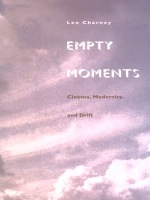 Empty Moments: Cinema, Modernity, and Drift
Leo Charney
Duke University Press, 1998 In Empty Moments, Leo Charney describes the defining quality of modernity as “drift”—the experience of being unable to locate a stable sense of the present. Through an exploration of artistic, philosophical, and scientific interrogations of the experience of time, Charney presents cinema as the emblem of modern culture’s preoccupation with the reproduction of the present. Empty Moments creates a catalytic dialogue among those who, at the time of the invention of film, attempted to define the experience of the fleeting present. Interspersing philosophical discussions with stylistically innovative prose, Charney mingles Proust’s conception of time/memory with Cubism’s attempt to interpret time through perspective and Surrealism’s exploration of subliminal representations of the present. Other topics include Husserl’s insistence that the present can only be fantasy or fabrication and the focus on impossibility, imperfection, and loss in Kelvin’s laws of thermodynamics. Ultimately, Charney’s work hints at parallels among such examples, the advent and popularity of cinema, and early film theory. A book with a structural modernity of its own, Empty Moments will appeal to those interested in cinema and its history, as well as to other historians, philosophers, literary, and cultural scholars of modernity.
Empty Names, Fiction and the Puzzles of Non-Existence
Edited by Anthony Everett and Thomas Hofweber
CSLI, 2000 Philosophers and theorists have long been puzzled by humans' ability to talk about things that do not exist, or to talk about things that they think exist but, in fact, do not. Empty Names, Fiction, and the Puzzles of Non-Existence is a collection of 13 new works concerning the semantic and metaphysical issues arising from empty names, non-existence, and the nature of fiction. The contributors include some of the most important researchers working in these fields. Some of the papers develop and defend new positions on these matters, while others offer important new perspectives and criticisms of the existing approaches. The volume contains a comprehensive introductory essay by the editors, which provides a survey of the philosophical issues concerning empty names, the various responses to these issues, and the literature on the subject to date.
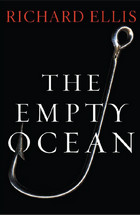 The Empty Ocean
Richard Ellis
Island Press, 2003 In The Empty Ocean, acclaimed author and artist Richard Ellis tells the story of our continued plunder of life in the sea and weighs the chances for its recovery. Through fascinating portraits of a wide array of creatures, he introduces us to the many forms of sea life that humans have fished, hunted, and collected over the centuries, from charismatic whales and dolphins to the lowly menhaden, from sea turtles to cod, tuna, and coral. Rich in history, anecdote, and surprising fact, Richard Ellis’s descriptions bring to life the natural history of the various species, the threats they face, and the losses they have suffered. Killing has occurred on a truly stunning scale, with extinction all too often the result, leaving a once-teeming ocean greatly depleted. But the author also finds instances of hope and resilience, of species that have begun to make remarkable comebacks when given the opportunity. Written with passion and grace, and illustrated with Richard Ellis’s own drawings, The Empty Ocean brings to a wide audience a compelling view of the damage we have caused to life in the sea and what we can do about it. "
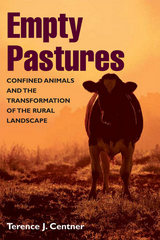 Empty Pastures: Confined Animals and the Transformation of the Rural Landscape
Terence J. Centner
University of Illinois Press, 2004 Over the past century American agriculture has shifted dramatically with small, commercial farms finding it increasingly difficult to compete with large-scale (mostly indoor) animal feeding operations (AFOs). In this book, Terence J. Centner investigates the environmental, social, economic, and political impact of the rise of the so-called factory farm, exposing the ramifications of the contemporary trend toward industrial-scale food production.
Just as Rachel Carson's landmark Silent Spring used the disappearance of songbirds as a jumping-off point for a work that raised public awareness of pesticides' devastating environmental impact, Empty Pastures sees the dwindling numbers of livestock in the American countryside as a symptom of a broader transformation, one with serious consequences for the rural landscape and its inhabitants--animal as well as human.
After outlining the rise of the AFO, Centner examines the troubling consequences of consolidation in animal farming and suggests a number of remedies. The issues he tackles include groundwater contamination, the loss of biodiversity, animal welfare, concentrated odors and other nuisances, soil erosion, and the economic effects of the disappearance of the small family farm.
Inspired by largely abandoned traditional practices rather than a radical and unrealistic vision of a return to an idealized past, Centner proposes a series of pragmatic reforms for regulating factory farms to halt ecological degradation and revitalize rural communities.
 Empty Plinths: Monuments, Memorials, and Public Sculpture in Mexico
José Esparza Chong Cuy
Harvard University Press Empty Plinths: Monuments, Memorials, and Public Sculpture in Mexico responds to the unfolding political debate around one of the most contentious public monuments in North America, Mexico City’s monument of Christopher Columbus on Avenida Paseo de la Reforma. In convening a diverse collective of voices around the question of the monument’s future, editors José Esparza Chong Cuy and Guillermo Ruiz de Teresa probe the unstable narratives behind a selection of monuments, memorials, and public sculptures in Mexico City, and propose a new charter that informs future public art commissions in Mexico and beyond. At a moment when many such structures have become highly visible sites of protest throughout the world, this new compilation of essays, interviews, artistic contributions, and public policy proposals reveals and reframes the histories embedded within contested public spaces in Mexico.
Empty Plinths is published alongside a series of artist commissions organized together with several major cultural institutions in Mexico City, including the Museo Tamayo, the Museo de Arte Moderno, and the Museo Experimental el Eco.
 The Empty Showcase Syndrome: Tough Questions about Cultural Heritage from Colonial Regions
Jos van Beurden
Amsterdam University Press, 2024 European countries, including the Netherlands, are increasingly more willing to return looted art to their former colonies. In doing so, however, they are confronted with hard choices. In The Empty Showcase Syndrome, Jos van Beurden explores three of the toughest questions that countries and governments face. First, former colonial powers often hesitate to relinquish control over the provenance research into the looted items to their former colonies. Secondly, most private owners keep quiet about their collections, while these collections should also be included in the restitution debates. Finally, many former colonies struggle with the question of where exactly the returned collections should go: to their national museums or to the old royal houses or indigenous communities from which these collections were stolen. In this book, Jos van Beurden uses many examples from the Netherlands, which has recently returned stolen art to Indonesia and Sri Lanka.
The Empty Space
Geetanjali Shree
Seagull Books, 2016 When a bomb explodes in a university cafe, nineteen students are killed. The Empty Space begins with the identification of these slain students. Slowly, each individual is claimed and taken away for a proper burial by their mourning family members. The final mother to enter the cafe identifies the nineteenth body as her eighteen-year-old son and brings him home in a casket. She not only brings home her dead son, though, but also the sole survivor of the blast, a three-year-old boy. By a strange quirk of fate, after the explosion he is found lying in a small empty space, alive and breathing. The Empty Space chronicles the memories of the boy dead, the story of the boy brought home, and the cataclysmic crossing of life and death.
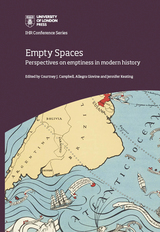 Empty Spaces: perspectives on emptiness in modern history
Edited by Courtney J. Campbell, Allegra Giovine, and Jennifer Keating
University of London Press, 2019 How is emptiness made and what historical purpose does it serve? What cultural, material and natural work goes into maintaining ‘nothingness’? Why have a variety of historical actors, from colonial powers to artists and urban dwellers, sought to construct, control and maintain (physically and discursively) empty space, and by which processes is emptiness discovered, visualised and reimagined? This volume draws together contributions from authors working on landscapes and rurality, along with national and imperial narratives, from Brazil to Russia and Ireland. It considers the visual, including the art of Edward Hopper and the work of the British Empire Marketing Board, while concluding with a section that examines constructions of emptiness in relation to capitalism, development and the (re)appropriation of urban space. In doing so, it foregrounds the importance of emptiness as a productive prism through which to interrogate a variety of imperial, national, cultural and urban history.
EMWJ v15.1
Edited by Bernadette Andrea, Julie D. Campbell, and Allyson M. Poska
Arizona Center for Medieval and Renaissance Studies, 2020
EMWJ v15.2
Edited by Bernadette Andrea, Julie D. Campbell, and Allyson M. Poska
Arizona Center for Medieval and Renaissance Studies, 2021
 En otras palabras: Perfeccionamiento del español por medio de la traducción, segunda edición
Patricia V. Lunn and Ernest J. Lunsford
Georgetown University Press Students of advanced Spanish share a desire to use and understand the language, even as their backgrounds and goals for the language may vary widely. En otras palabras provides advanced learners of Spanish with hands-on manipulation of grammatical, lexical, and cultural detail through the practice of translation (traducción). This challenging and enjoyable textbook—now in its second edition with up-to-date texts on current events, new exercises, and new and expanded instructions—presents students with incisive grammar explanation, relevant lexical information, and a wide variety of translation texts and exercises in order to increase their mastery of the Spanish language. En otras palabras contains Spanish texts to be translated into English as well as English texts for translation into Spanish. Translating into English requires students to understand every detail of the Spanish text and decide how these details might best be expressed in English. Translating into Spanish requires students to recognize how Spanish structures and words do—and do not—parallel those of English. Both activities provide advanced students of Spanish with an invigorating linguistic workout and serve as an effective introduction to the practice of translation. Translation is a cultural as well as a linguistic activity; for students, learning how to translate provides invaluable experience of the inseparability of language and culture. En otras palabras addresses the errors made by advanced learners of Spanish while involving students in the pleasurable, problem-solving process of translation. This second edition contains a wide variety of usage-based exercises for both individual and group work. Concise and complete texts feature narrative and description, marketing and publicity materials, medical and legal topics, sports journalism, and internet posts. En otras palabras is designed for a three-credit semester class; an online Instructor's Manual is provided at no charge to professors who adopt the text in their classrooms.
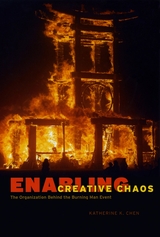 Enabling Creative Chaos: The Organization Behind the Burning Man Event
Katherine K. Chen
University of Chicago Press, 2009 In the summer of 2008, nearly fifty thousand people traveled to Nevada’s Black Rock Desert to participate in the countercultural arts event Burning Man. Founded on a commitment to expression and community, the annual weeklong festival presents unique challenges to its organizers. Over four years Katherine K. Chen regularly participated in organizing efforts to safely and successfully create a temporary community in the middle of the desert under the hot August sun. Enabling Creative Chaos tracks how a small, underfunded group of organizers transformed into an unconventional corporation with a ten-million-dollar budget and two thousand volunteers. Over the years, Burning Man’s organizers have experimented with different management models; learned how to recruit, motivate, and retain volunteers; and developed strategies to handle regulatory agencies and respond to media coverage. This remarkable evolution, Chen reveals, offers important lessons for managers in any organization, particularly in uncertain times.
Enabling Technologies for Smart Fog Computing
Kuldeep Singh Kaswan
The Institution of Engineering and Technology, 2024 Fog computing is a decentralized computing infrastructure in which computing resources are located between the data source and the cloud or any other data centers. The word "fog" refers to its cloud-like properties, which are closer to the "ground", using edge devices that carry out locally computation, storage and communication tasks. An additional benefit is that the processed data is likely to be needed by the same devices that generated the data. By processing locally rather than remotely, the latency between input and response are minimized. This technology has countless application domains such as industrial process control, smart cities, transportation, healthcare and agriculture.
Enabling Technologies for Social Distancing: Fundamentals, concepts and solutions
Diep N. Nguyen
The Institution of Engineering and Technology, 2022 The latest advances in several emerging technologies such as AI, blockchain, privacy-preserving algorithms used in localization and positioning systems, cloud computing and computer vision all have great potential in facilitating social distancing. Benefits range from supporting people to work from home to monitoring micro- and macro- movements such as contact tracing apps using Bluetooth, tracking the movement and transportation level of a city and wireless positioning systems to help people keep a safe distance by alerting them when they are too close to each other or to avoid congestion. However, implementing such technologies in practical scenarios still faces various challenges.
Enabling Technologies for Sustainable Smart Cities: Design, development and management
Mohammad A. Matin
The Institution of Engineering and Technology, 2025 As populations rise and cities draw ever-larger populations, smart cities are emerging around the world to cater for the need for sustainable urban development. The exploration of recent advances in information and communication technology (ICT), sensing and energy engineering offers promising enablers for creating, implementing, and promoting sustainable development strategies to address the challenges of this expanding urbanization.
 ENACTing Change: A Handbook for Teaching Advocacy and Civic Engagement
Kathleen Cole, Robert W. Glover, Richard J. Meagher, and Katharine A. Owens
Brandeis University Press, 2025 Explains the ENACT model of student civic engagement, empowers instructors to implement it, and shows them how to assess its impact.
ENACT: The Educational Network for Active Civic Transformation aims to teach college students about democracy through engagement with the state legislative process. Built on the values of knowledge, cooperation, justice, and integrity, ENACT is a national, intercollegiate nonpartisan network. The program empowers students to be active participants in democratic processes by connecting with policymakers and community organizations, conducting research and analysis, and informing public policy with evidence and expertise.
ENACTing Change introduces teachers to the philosophy and practice of the ENACT model—which includes workshops, courses, an online network, as well as pilot projects and other initiatives—while providing detailed guidance on how to incorporate the model into their courses, regardless of discipline or educational settings. The book offers instructors recommendations for developing and teaching courses that engage in state-level policy advocacy with a focus on learning outcomes. ENACTing Change takes instructors through each step of the course design process, from how to build the relationships needed to teach the class to the next steps for students to work in the community after ENACT.
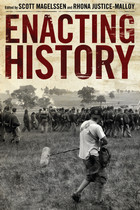 Enacting History
Edited by Scott Magelssen and Rhona Justice-Malloy
University of Alabama Press, 2011 Where performance meets the past: exploring how we stage, shape, and experience history. Enacting History is a collection of new essays exploring the world of historical performances. The volume focuses on performances outside the traditional sphere of theatre, among them living history museums, battle reenactments, pageants, renaissance festivals, and adventure-tourism destinations. This volume argues that the recent surge in such performances have raised significant questions about the need for, interest in, and value of such nontraditional theater. Many of these performances claim a greater or lesser degree of historical "accuracy" or "authenticity," and the authors tease out the representational and historiographic issues related to these arguments. How, for instance, are issues of race, ethnicity, and gender dealt with at museums that purport to be accurate windows into the past? How are politics and labor issues handled in local- or state-funded institutions that rely on volunteer performers? How do tourists' expectations shape the choices made by would-be purveyors of the past? Where do matters of taste or censorship enter in when reconciling the archival evidence with a family-friendly mission? Essays in the collection address, among other subjects, reenactments of period cookery and cuisine at a Maryland renaissance festival; the roles of women as represented at Minnesota's premiere living history museum, Historic Fort Snelling; and the Lewis and Clark bicentennial play as cultural commemoration. The editors argue that historical performances like these-regardless of their truth-telling claims-are an important means to communicate, document, and even shape history, and allow for a level of participation and accessibility that is unique to performance. Enacting History is an entertaining and informative account of the public's fascination with acting out and watching history and of the diverse methods of fulfilling this need.
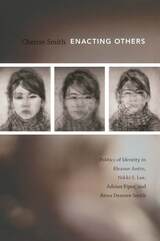 Enacting Others: Politics of Identity in Eleanor Antin, Nikki S. Lee, Adrian Piper, and Anna Deavere Smith
Cherise Smith
Duke University Press, 2011 The artists Adrian Piper, Eleanor Antin, Anna Deavere Smith, and Nikki S. Lee have all crossed racial, ethnic, gender, and class boundaries in works that they have conceived and performed. Cherise Smith analyzes their complex engagements with issues of identity through close readings of a significant performance, or series of performances, by each artist. She examines Piper’s public embodiment of the Mythic Being, a working-class black man, during the early 1970s; Antin’s full-time existence as the fictitious black ballerina Eleanora Antinova for several weeks in 1981; and Smith’s shifting among more than twenty characters of different ages and racial, ethnic, gender, and class backgrounds in Twilight: Los Angeles. She also considers Lee’s performances of membership in cultural groups—including swing dancers, hip-hop devotees, skateboarders, drag queens, and yuppies—in her Projects series (1997–2001). The author historicizes the politics of identity by exploring each performance in relation to the discourses prevalent in the United States at the time of its development. She is attentive to how the artists manipulated clothing, mannerisms, voice, and other signs to negotiate their assumed identities. Cherise Smith argues that by drawing on conventions such as passing, blackface, minstrelsy, cross-dressing, and drag, they highlighted the constructedness and fluidity of identity and identifications. Enacting Others provides a provocative account of how race informs contemporary art and feminist performance practices.
Encantado: Desert Monologues
Pat Mora
University of Arizona Press, 2018 Inspired by Edgar Lee Masters’s Spoon River Anthology and Thornton Wilder’s Our Town, Pat Mora brings us the poetic monologues of Encantado, an imagined southwestern town.
Each poem forms a story that reveals the complex and emotional journeys we take through life. Mora meanders through the thoughts of Encantado’s residents—the mothers and sisters, brothers and fathers in whom we see slivers of ourselves and our loved ones—and paints a portrait of a community through its inhabitants’ own diverse voices. Even the river has a voice we understand.
Inspired by both the real and imagined stories around her, Mora transports us to the heart of what it means to join in a chorus of voices. A community. A town. Encantado.
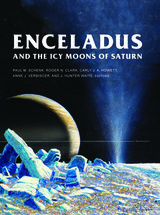 Enceladus and the Icy Moons of Saturn
Edited by Paul M. Schenk, Roger N. Clark, Carly J. A. Howett, Anne J. Verbiscer, and J. Hunter Waite
University of Arizona Press, 2018 With active geysers coating its surface with dazzlingly bright ice crystals, Saturn’s large moon Enceladus is one of the most enigmatic worlds in our solar system. Underlying this activity are numerous further discoveries by the Cassini spacecraft, tantalizing us with evidence that Enceladus harbors a subsurface ocean of liquid water. Enceladus is thus newly realized as a forefront candidate among potentially habitable ocean worlds in our own solar system, although it is only one of a family of icy moons orbiting the giant ringed planet, each with its own story.
As a new volume in the Space Science Series, Enceladus and the Icy Moons of Saturn brings together nearly eighty of the world’s top experts writing more than twenty chapters to set the foundation for what we currently understand, while building the framework for the highest-priority questions to be addressed through ongoing spacecraft exploration. Topics include the physics and processes driving the geologic and geophysical phenomena of icy worlds, including, but not limited to, ring-moon interactions, interior melting due to tidal heating, ejection and reaccretion of vapor and particulates, ice tectonics, and cryovolcanism.
By contextualizing each topic within the profusion of puzzles beckoning from among Saturn’s many dozen moons, Enceladus and the Icy Moons of Saturn synthesizes planetary processes on a broad scale to inform and propel both seasoned researchers and students toward achieving new advances in the coming decade and beyond.
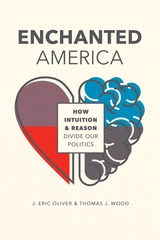 Enchanted America: How Intuition and Reason Divide Our Politics
J. Eric Oliver and Thomas J. Wood
University of Chicago Press, 2018 America is in civic chaos, its politics rife with conspiracy theories and false information. Nationalism and authoritarianism are on the rise, while scientists, universities, and news organizations are viewed with increasing mistrust. Its citizens reject scientific evidence on climate change and vaccinations while embracing myths of impending apocalypse. And then there is Donald Trump, a presidential candidate who won the support of millions of conservative Christians despite having no moral or political convictions. What is going on?
The answer, according to J. Eric Oliver and Thomas J. Wood, can be found in the most important force shaping American politics today: human intuition. Much of what seems to be irrational in American politics arises from the growing divide in how its citizens make sense of the world. On one side are rationalists. They use science and reason to understand reality. On the other side are intuitionists. They rely on gut feelings and instincts as their guide to the world. Intuitionists believe in ghosts and End Times prophecies. They embrace conspiracy theories, disbelieve experts, and distrust the media. They are stridently nationalistic and deeply authoritarian in their outlook. And they are the most enthusiastic supporters of Donald Trump. The primary reason why Trump captured the presidency was that he spoke about politics in a way that resonated with how Intuitionists perceive the world. The Intuitionist divide has also become a threat to the American way of life. A generation ago, intuitionists were dispersed across the political spectrum, when most Americans believed in both God and science. Today, intuitionism is ideologically tilted toward the political right. Modern conservatism has become an Intuitionist movement, defined by conspiracy theories, strident nationalism, and hostility to basic civic norms.
Enchanted America is a clarion call to rationalists of all political persuasions to reach beyond the minority and speak to intuitionists in a way they understand. The values and principles that define American democracy are at stake.
 Enchanted by Prairie
Bill Witt
University of Iowa Press, 2009 June grass at sunset, Indian grass at sunrise, hawk moths and monarch butterflies nectaring on purple fringed orchids and rough blazing star, little bluestem and saw-tooth sunflowers and butterfly milkweed in hill prairies and sand prairies, and blue skies and one bright rainbow arching over them all. Bill Witt has been photographing Iowa’s wild places for more than thirty years, and the result is this collection of splendid images that reveal the glorious beauty and diversity of the state’s prairie remnants.
Witt gives us close-ups of pasque flower shoots covered with ice in spring, coneflowers dancing in a summer breeze, and prairie dropseed in its autumn colors as well as such prairie companions as sandhill cranes, northern harriers, and bison. His panoramic visions of prairie landscapes in all seasons focus on the personal pleasure and spiritual sustenance that connecting with prairies, even small and neglected ones, can bring us. Osha Davidson’s essay compares today’s prairie remnants with yesterday’s expanses and calls for us to restore balance to this damaged landscape. Altogether, Enchanted by Prairie celebrates today’s prairie landscape and encourages us, in Davidson’s words, to restore its “beauty and scents and textures and sounds.”
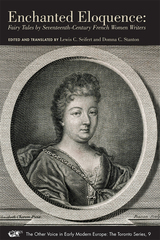 Enchanted Eloquence: Fairy Tales by Seventeenth–Century French Women Writers
Edited and Translated by Lewis C. Seifert and Domna C. Stanton
Iter Press, 2010 This is a superb book on all levels. The translations of the tales are excellent. The research is impeccable. The introduction and notes are highly informative. Most important, Lewis Seifert and Domna Stanton have focused on unusual fairy tales that have never been translated before and are seminal for understanding the development of the literary fairy tale as genre. French women writers played a central role in the institutionalization of a literary genre in the French civilizing process that had huge ramifications in opera, theater, vaudeville, music, and film. Moreover, their tales influenced other writers of fairy tales in Europe. This book does an honor to their creative efforts and provides the basis for further research on the development of European fairy tales.
—Jack Zipes
Professor of German, Emeritus, University of Minnesota
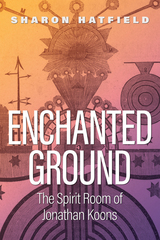 Enchanted Ground: The Spirit Room of Jonathan Koons
Sharon Hatfield
Ohio University Press, 2018 In Enchanted Ground, Sharon Hatfield brings to life the true story of a nineteenth-century farmer-turned-medium, Jonathan Koons, one of thousands of mediums throughout the antebellum United States. In the hills outside Athens, Ohio, Koons built a house where it was said the dead spoke to the living, and where ancient spirits communicated the wisdom of the ages. Curious believers, in homespun and in city attire, traveled from as far as New Orleans to a remote Appalachian cabin whose marvels would rival any of P. T. Barnum’s attractions. Yet Koons’s story is much more than showmanship and sleight of hand. His enterprise, not written about in full until now, embodied the excitement and optimism of citizens breaking free from societal norms. Reform-minded dreamers were drawn to Koons’s seances as his progressive brand of religion displaced the gloomy Calvinism of previous generations. As heirs to the Second Great Awakening, which stretched from New York State to the far reaches of the Northwest Territory, the curious, the faithful, and Koons himself were part of a larger, uniquely American moment that still marks the cultural landscape today.
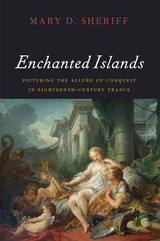 Enchanted Islands: Picturing the Allure of Conquest in Eighteenth-Century France
Mary D. Sheriff
University of Chicago Press, 2018 In Enchanted Islands, renowned art historian Mary D. Sheriff explores the legendary, fictional, and real islands that filled the French imagination during the ancien regime as they appeared in royal ballets and festivals, epic literature, paintings, engravings, book illustrations, and other objects. Some of the islands were mythical and found in the most popular literary texts of the day—islands featured prominently, for instance, in Ariosto’s Orlando furioso,Tasso’s Gerusalemme liberata, and Fénelon’s, Telemachus. Other islands—real ones, such as Tahiti and St. Domingue—the French learned about from the writings of travelers and colonists. All of them were imagined to be the home of enchantresses who used magic to conquer heroes by promising sensual and sexual pleasure. As Sheriff shows, the theme of the enchanted island was put to many uses. Kings deployed enchanted-island mythology to strengthen monarchical authority, as Louis XIV did in his famous Versailles festival Les Plaisirs de l’île enchantée. Writers such as Fénelon used it to tell morality tales that taught virtue, duty, and the need for male strength to triumph over female weakness and seduction. Yet at the same time, artists like Boucher painted enchanted islands to portray art’s purpose as the giving of pleasure. In all these ways and more, Sheriff demonstrates for the first time the centrality of enchanted islands to ancient regime culture in a book that will enchant all readers interested in the art, literature, and history of the time.
 Enchanted Modernities: Ancestral Vitalizations in the Upper Mekong
Micah F. Morton
University of Wisconsin Press, 2025 Enchanted Modernities tells the story of an Indigenous community’s work to decolonize and reclaim its collective ancestral identity. In this rich, theoretically informed ethnography, Micah F. Morton follows a transregional network of Indigenous Akha people from Thailand, Myanmar (Burma), China, and Laos as they spearhead a new movement for a pan-Akha identity. In the face of enormous historical and present-day colonialist pressures, this neo-traditionalist movement has focused on revitalizing (or “vitalizing,” in Morton’s suggestive term) Akha ancestral ways, preventing ongoing conversion to Christianity, and facilitating return conversion to the ways of the Ancestors. Morton focuses especially on the community’s work to ensure their Ancestors live on and thus remain a dynamic part of their, and their descendants’, lives.
Although modernity and its colonial legacies are often portrayed as severing or at least attenuating people’s ancestral ties, Enchanted Modernities shows that those ties persist and, in fact, are on the rise. Akha and other Indigenous ancestral and animist resurgences are blossoming despite the paradigmatic Western framing of modernity as fundamentally at odds with Ancestors and, for that matter, kinship and even religion. Morton demonstrates that modernity and modernization proceed alongside the reproduction of new and old forms of enchantment.
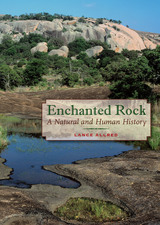 Enchanted Rock: A Natural and Human History
By Lance Allred
University of Texas Press, 2009 With intriguing domes of pinkish granite surrounded by a sea of Hill Country limestone, Enchanted Rock State Natural Area attracts over 300,000 visitors every year who come to the park to hike, rock climb, spelunk, camp, picnic, and observe birds and wildflowers. Geologists from around the world come to Enchanted Rock to examine landforms that were shaped by forces on ancient continents of Earth more than one billion years ago! All of these visitors, however, are only the latest comers in a line of human history that stretches back 13,000 years to early Native Americans and includes Spanish explorers, Mexican and German settlers, and thirteen private and public owners up to the current owner, the state of Texas. Surprisingly, given the area's wealth of unusual geology, native plants and animals, and human history, no comprehensive guide to Enchanted Rock has been published before now. In Enchanted Rock, you'll find everything you need to fully appreciate this unique place. Lance Allred draws on the work of specialists in many fields to offer a popular account of the park's history, geology, weather, flora, and fauna. Whether you want to know more about how Enchanted Rock was formed, identify a wildflower or butterfly, or learn more about plant communities along the hiking trails, you'll find accurate information here, presented in an inviting style. Over a thousand color photographs illustrate the enjoyable text.
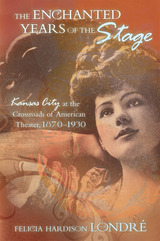 The Enchanted Years of the Stage: Kansas City at the Crossroads of American Theater, 1870-1930
Felicia Hardison Londré
University of Missouri Press, 2007 Sarah Bernhardt, Sir Henry Irving, Edwin Booth . . . there was a time when they all played Kansas City. From star-studded engagements at ornate opera houses to risqué shows in Fourth Street honky-tonks, Kansas City was a cow town that wanted to civilize itself through the performing arts. And because it was a railway hub in the heyday of trouping, it opened its doors to America’s traveling performers. This book chronicles the “first golden age” of Kansas City theater, from the opening of the Coates Opera House in 1870 through the gradual decline of touring productions after World War I. Drawing on the recollections of renowned theater critic David Austin Latchaw and on newspaper archives of the era, Felicia Londré has gleaned long-lost nuggets of theater life—both the legitimate stage and popular fare—to create a fascinating account of a city and its theater culture. The Enchanted Years of the Stage is brimming with forgotten stories and historical illustrations that offer a new perspective on both the history of American theater and the humor and pathos of performers’ lives. It tells how James O’Neill once chased a messenger boy for ruining a big scene, while Louis James played practical jokes on fellow actors in the middle of Shakespeare performances; how police kept watch over the burlesque girls at the Folly to make sure their act wouldn’t reach the level of indecency allowed in St. Louis; how Orth Stein shot the manager of the Theatre Comique; and how Eddie Foy played his death scene in Kansas City—by dying there. Throughout the book, sidebars of Latchaw’s writing reflect the style and spirit of this bygone era. Offering a richer view of American theater than have accounts centered on New York, Londré’s book also yields a wealth of new insights into the social and political fabric of an emerging metropolis and testifies to the importance of the arts in the growth and reputation of a great city. By conveying the richness and complexity of road shows in Kansas City—a microcosm of the burgeoning national stage—she gives us a key piece in the mosaic that was American theater in a neglected but unforgettable era.
Enchanting Powers: Music in the World’s Religions
Lawrence E. Sullivan
Harvard University Press, 1997 The Confucian Sacrificial Ceremony, the Choctaw ball game, the "drum history" of the Dagbamba, the chanting of the Qur'an--these are some of the topics addressed in this collection of essays by eminent musicologists, anthropologists, historians, and religionists as they consider the intersection of musics and religions in different world cultures.
 Enchantment Lake: A Northwoods Mystery
Margi Preus
University of Minnesota Press, 2017 Midwest Book Award Winner — Young Adult Fiction A disturbing call from her great aunts Astrid and Jeannette sends seventeen-year-old Francie far from her new home in New York into a tangle of mysteries. Ditching an audition in a Manhattan theater, Francie travels to a remote lake in the northwoods where her aunts’ neighbors are “dropping like flies” from strange accidents. But are they accidents? On the shores of Enchantment Lake in the woods of northern Minnesota, something ominous is afoot, and as Francie begins to investigate, the mysteries multiply: a poisoned hotdish, a puzzling confession, eerie noises in the bog, and a legendary treasure said to be under enchantment—or is that under Enchantment, as in under the lake? At the center of everything is a suddenly booming business in cabin sales and a road not everyone wants built. To a somewhat reluctant northwoods Nancy Drew, the intrigue proves irresistible, especially when it draws her closer to the mysteries at the heart of her own life. What happened to her father? Who and where is her mother? Who is she, and where does her heart lie—in the bustle of New York City or the deep woods of Minnesota? With its gripping story, romantic spirit, and a sly dash of modern-day trouble (including evil realtors and other invasive species), Enchantment Lake will fascinate readers, providing precisely the charm that Margi Preus’s fans have come to expect.
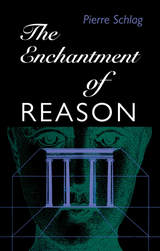 The Enchantment Of Reason
Pierre Schlag
Duke University Press, 1998 The Enchantment of Reason is a lively critique of American legal thought and the American legal system’s deification of reason. In an attempt to understand the current malaise of American law and the depressed condition of American intellectual life in general, Pierre Schlag diagnoses what he believes is an epidemic of pathological reliance on the principle of reason. Contending that legal thinkers continually fail to recognize the aesthetic and ethical prejudices of rationalism, Schlag creates a genealogy that shows how the call to reason has become a manipulative vehicle of power, faith, and prejudice. In examining the fierce resistance to questioning reason’s primacy, this renowned critic and professor of American law demonstrates how those who use and study the law perpetuate their own methodological blind spots. Claiming that reason has been endowed with a virtually mystical power to organize social life, Schlag unravels the seemingly rational world of judicial opinions, statutes, doctrines, and legal principles. In the process, he paints a shocking—and sure to be controversial—picture of the chaos and, indeed, violence of the American legal tradition. This bold commentary on the irrationality of reason in American law and legal studies will interest not only legal scholars and philosophers but also serious thinkers across a broad disciplinary spectrum.
 The Enchantments of Mammon: How Capitalism Became the Religion of Modernity
Eugene McCarraher
Harvard University Press, 2019 “An extraordinary work of intellectual history as well as a scholarly tour de force, a bracing polemic, and a work of Christian prophecy…McCarraher challenges more than 200 years of post-Enlightenment assumptions about the way we live and work.”
—The Observer
At least since Max Weber, capitalism has been understood as part of the “disenchantment” of the world, stripping material objects and social relations of their mystery and magic. In this magisterial work, Eugene McCarraher challenges this conventional view. Capitalism, he argues, is full of sacrament, whether one is prepared to acknowledge it or not. First flowering in the fields and factories of England and brought to America by Puritans and evangelicals, whose doctrine made ample room for industry and profit, capitalism has become so thoroughly enmeshed in the fabric of our society that our faith in “the market” has become sacrosanct.
Informed by cultural history and theology as well as management theory, The Enchantments of Mammon looks to nineteenth-century Romantics, whose vision of labor combined reason, creativity, and mutual aid, for salvation. In this impassioned challenge to some of our most firmly held assumptions, McCarraher argues that capitalism has hijacked our intrinsic longing for divinity—and urges us to break its hold on our souls.
“A majestic achievement…It is a work of great moral and spiritual intelligence, and one that invites contemplation about things we can’t afford not to care about deeply.”
—Commonweal
“More brilliant, more capacious, and more entertaining, page by page, than his most ardent fans dared hope. The magnitude of his accomplishment—an account of American capitalism as a religion…will stun even skeptical readers.”
—Christian Century
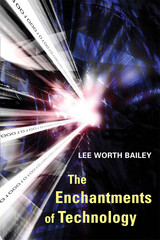 The Enchantments of Technology
Lee Worth Bailey
University of Illinois Press, 2005 In The Enchantments of Technology, Lee Worth Bailey erases the conventional distinction between myth and machine in order to explore the passionate foundations concealed in technological culture and address its complex ethical, moral and social implications.
Bailey argues that technological society does not simply disenchant the world with its reductive methods and mechanical metaphors, then shape machines with political motives, but is also borne by a deeper, subversive undertow of enchantment. Addressing examples to explore the complexities of these enchantments, his thought is full of illuminating examinations of seductively engaging technologies ranging from the old camera obscura to new automobiles, robots, airplanes, and spaceships.
This volume builds on the work of numerous scholars, including Jacques Ellul and Jean Brun on the phenomenological and spiritual aspects of technology, Carl Jung on the archetypal collective unconscious approach to myth, and Martin Heidegger on Being itself. Bailey creates a dynamic, interdisciplinary, postmodern examination of how our machines and their environments embody not only reason, but also desires.
 Enclosure Architect: A Novel
Douglas W. Milliken
West Virginia University Press, 2024 It seems like a sign of liberation—of adulthood’s indefinite postponement—when partisans bomb the university and every student’s personal records, from transcripts to debts, are consumed in erasing fire. If nothing else, it lends Margaux the freedom to continue her preferred art form of list-making unfettered by the authority of academia--until she encounters the breakdowns and disappearances and deaths of the people she admires and cherishes most. A monochromatic painter. A BDSM documentary photographer. A transgendered Aphrodite. A mathematician with an invisible cat. Yet as the concrete details of her world dissolve into the abstraction of loss, they also become more rarefied, more essential. Something small enough to be contained. Small enough to be protected.
Set in a semi-fictional, post-industrial American warzone, this novel explores multiple facets related to the recent nonfictional decades of constant civil unrest, with a particular focus on the complicated nature of holding a personal creative life amidst a time of constant violence and change. Despite its heavy themes, the narrative is threaded throughout with veins of absurdist humor that invite and welcome us into the familial warmth of the narrator’s memories of friendship.
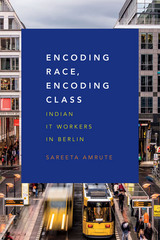 Encoding Race, Encoding Class: Indian IT Workers in Berlin
Sareeta Amrute
Duke University Press, 2016 In Encoding Race, Encoding Class Sareeta Amrute explores the work and private lives of highly skilled Indian IT coders in Berlin to reveal the oft-obscured realities of the embodied, raced, and classed nature of cognitive labor. In addition to conducting fieldwork and interviews in IT offices as well as analyzing political cartoons, advertisements, and reports on white-collar work, Amrute spent time with a core of twenty programmers before, during, and after their shifts. She shows how they occupy a contradictory position, as they are racialized in Germany as temporary and migrant grunt workers, yet their middle-class aspirations reflect efforts to build a new, global, and economically dominant India. The ways they accept and resist the premises and conditions of their work offer new potentials for alternative visions of living and working in neoliberal economies. Demonstrating how these coders' cognitive labor realigns and reimagines race and class, Amrute conceptualizes personhood and migration within global capitalism in new ways.
The Encomenderos of New Spain, 1521-1555
By Robert Himmerich y Valencia
University of Texas Press, 1991 While the Spanish conquistadors have been stereotyped as rapacious treasure seekers, many firstcomers to the New World realized that its greatest wealth lay in the native populations whose labor could be harnessed to build a new Spain. Hence, the early arrivals in Mexico sought encomiendas—"a grant of the Indians of a prescribed indigenous polity, who were to provide the grantee (the encomendero) tribute in the form of commoditiesand service in return for protection and religious instruction." This study profiles the 506 known encomenderos in New Spain (present-day Mexico) during the years 1521-1555, using their life histories to chart the rise, florescence, and decline of the encomienda system. The first part draws general conclusions about the actual workings of the encomienda system. The second part provides concise biographies of the encomenderos themselves.
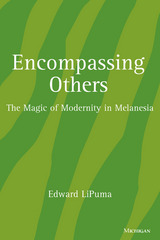 Encompassing Others: The Magic of Modernity in Melanesia
Edward LiPuma
University of Michigan Press, 2001 An engaging, beautifully written account by an ethnographer who lived in the mountains of Papua New Guinea, Encompassing Others is at once a history of the encounter of two cultures and an attempt to challenge theoretically the main concepts that have informed the study of modernity. Going beyond accounts that grasp modernity solely in terms of domination, imperialism, and local resistance, it explores how capitalism, Christianity, and mass commercial culture enchant the senses, create a carnival of new goods, and open up new possibilities for thought and action.
Focusing on the Maring people of Highland New Guinea and on the Westerners who interacted with them, Edward LiPuma presents issues from the perspectives of both sides. We hear the voice of the Anglican priest from San Francisco as well as the most powerful Maring shamans. Further, the book seeks to develop a theory of generations that helps explain how change accelerates and societies take on new directions across generations.
Theoretical, descriptive, but almost entirely free of jargon, this book is intended for all those who are interested in how the West's encompassment of other peoples influences how these others conceive of their past, imagine their future, and experience the present. It will have wide appeal for anthropologists and others concerned with colonialism, globalization, and the formation of the nation-state.
Edward LiPuma is Professor and Chair, Department of Anthropology, University of Miami.
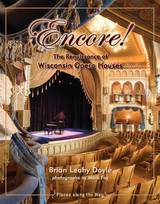 Encore!: The Renaissance of Wisconsin Opera Houses
Brian Leahy Doyle
Wisconsin Historical Society Press, 2009
A remarkable number of Wisconsin towns and cities were home to an opera house in the late 1800s and early 1900s. Some were freestanding structures built by local benefactors, industrialists, and capitalists. Others were located within a city hall building and financed by local tax dollars with the support of government officials who believed in the value of the arts for their community
In Encore! The Renaissance of Wisconsin Opera Houses, Brian Leahy Doyle chronicles the histories of ten Wisconsin opera houses and theaters, from their construction to their heydays as live performance spaces and through the periods when many of these stages went dark. But what makes these stories so compelling is that all but one of the featured theaters has been restored to its original splendor. Just as the beginnings of these theaters were often the result of the efforts of local citizens, Doyle discovers that their restoration is due to the commitment of dedicated and passionate people. More than one of these revived theaters has spurred the revitalization of its surrounding downtown business district as well.
Encore! is the second book in the Places along the Way series. Richly illustrated with historic and contemporary photos, the Places along the Way series links Wisconsin's past with its present, exploring the state's history through its architecture.
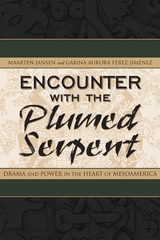 Encounter with the Plumed Serpent: Drama and Power in the Heart of Mesoamerica
Maarten Jansen
University Press of Colorado, 2007 The Mixtec, or the people of Ñuu Savi ('Nation of the Rain God'), one of the major civilizations of ancient Mesoamerica, made their home in the highlands of Oaxaca, where they resisted both Aztec military expansion and the Spanish conquest. In Encounter with the Plumed Serpent, two leading scholars present and interpret the sacred histories narrated in the Mixtec codices, the largest surviving collection of pre-Columbian manuscripts in existence. In these screenfold books, ancient painter-historians chronicled the politics of the Mixtec from approximately a.d. 900 to 1521, portraying the royal families, rituals, wars, alliances, and ideology of the times.
By analyzing and cross-referencing the codices, which have been fragmented and dispersed in far-flung archives, the authors attempt to reconstruct Mixtec history. Their synthesis here builds on long examination of the ancient manuscripts. Adding useful interpretation and commentary, Jansen and Pérez Jiménez synthesize the large body of surviving documents into the first unified narrative of Mixtec sacred history.
Archaeologists and other scholars as well as readers with an interest in Mesoamerican cultures will find this lavishly illustrated volume a compelling and fascinating history and a major step forward in knowledge of the Mixtec.
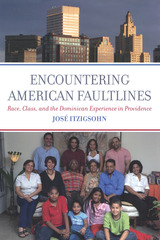 Encountering American Faultlines: Race, Class, and the Dominican Experience in Providence
Jose Itzigsohn
Russell Sage Foundation, 2009 The descendents of twentieth-century southern and central European immigrants successfully assimilated into mainstream American culture and generally achieved economic parity with other Americans within several generations. So far, that is not the case with recent immigrants from Latin America and the Caribbean. A compelling case study of first- and second-generation Dominicans in Providence, Rhode Island, Encountering American Faultlines suggests that even as immigrants and their children increasingly participate in American life and culture, racialization and social polarization remain key obstacles to further progress. Encountering American Faultlines uses occupational and socioeconomic data and in-depth interviews to address key questions about the challenges Dominicans encounter in American society. What is their position in the American socioeconomic structure? What occupations do first- and second-generation Dominicans hold as they enter the workforce? How do Dominican families fare economically? How do Dominicans identify themselves in the American racial and ethnic landscape? The first generation works largely in what is left of Providence's declining manufacturing industry. Second-generation Dominicans do better than their parents economically, but even as some are able to enter middle-class occupations, the majority remains in the service-sector working class. José Itzigsohn suggests that the third generation will likely continue this pattern of stratification, and he worries that the chances for further economic advancement in the next generation may be seriously in doubt. While transnational involvement is important to first-generation Dominicans, the second generation concentrates more on life in the United States and empowering their local communities. Itzigsohn ties this to the second generation's tendency to embrace panethnic identities. Panethnic identity provides Dominicans with choices that defy strict American racial categories and enables them to build political coalitions across multiple ethnicities. This intimate study of the Dominican immigrant experience proposes an innovative theoretical approach to look at the contemporary forms and meanings of becoming American. José Itzigsohn acknowledges the social exclusion and racialization encountered by the Dominican population, but he observes that, by developing their own group identities and engaging in collective action and institution building at the local level, Dominicans can distinguish themselves and make inroads into American society. But Encountering American Faultlines also finds that hard work and hope have less to do with their social mobility than the existing economic and racial structures of U.S. society.
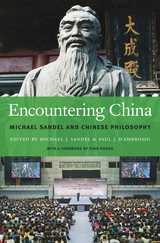 Encountering China: Michael Sandel and Chinese Philosophy
Michael J. Sandel
Harvard University Press, 2018 In the West, Harvard philosopher Michael Sandel is a thinker of unusual prominence. In China, he’s a phenomenon, greeted by vast crowds. China Daily reports that he has acquired a popularity “usually reserved for Hollywood movie stars.” China Newsweek declared him the “most influential foreign figure” of the year. In Sandel the Chinese have found a guide through the ethical dilemmas created by the nation’s swift embrace of a market economy—a guide whose communitarian ideas resonate with aspects of China’s own rich and ancient philosophical traditions.
Chinese citizens often describe a sense that, in sprinting ahead, they have bounded past whatever barriers once held back the forces of corruption and moral disregard. The market economy has lifted millions from poverty but done little to define ultimate goals for individuals or the nation. Is the market all there is? In this context, Sandel’s charismatic, interactive lecturing style, which roots moral philosophy in real-world scenarios, has found an audience struggling with questions of their responsibility to one another.
Encountering China brings together leading experts in Confucian and Daoist thought to explore the connections and tensions revealed in this unlikely episode of Chinese engagement with the West. The result is a profound examination of diverse ideas about the self, justice, community, gender, and public good. With a foreword by Evan Osnos that considers Sandel’s fame and the state of moral dialogue in China, the book will itself be a major contribution to the debates that Sandel sparks in East and West alike.
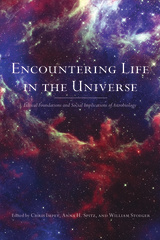 Encountering Life in the Universe: Ethical Foundations and Social Implications of Astrobiology
Edited by Chris Impey, Anna H. Spitz, and William Stoeger
University of Arizona Press, 2013 Are we alone in the universe? Are the planets our playground to treat as we will, or do we have a responsibility to other creatures who may inhabit or use them? Do we have a right to dump trash in space or leave vehicles on Mars or the moon? How should we interact with other life forms?
Encountering Life in the Universe examines the intersection of scientific research and society to further explore the ethics of how to behave in a universe where much is unknown. Taking contributions from notable experts in several fields, the editors skillfully introduce and develop a broad look at the moral questions facing humans on Earth and beyond.
Major advances in biology, biotechnology, and medicine create an urgency to ethical considerations in those fields. Astrobiology goes on to debate how we might behave as we explore new worlds, or create new life in the laboratory, or interact with extraterrestrial life forms. Stimulated by new technologies for scientific exploration on and off the Earth, astrobiology is establishing itself as a distinct scientific endeavor.
In what way can established philosophies provide guidance for the new frontiers opened by astrobiology research? Can the foundations of ethics and moral philosophy help answer questions about modifying other planets? Or about how to conduct experiments to create life in the lab or about? How to interact with organisms we might discover on another world?
While we wait for the first echo that might indicate life beyond Earth, astobiologists, along with philosophers, theologians, artists, and the general public, are exploring how we might behave—even before we know for sure they are there. Encountering Life in the Universe is a remarkable resource for such philosophical challenges.
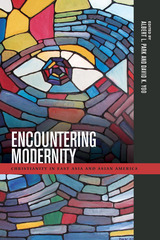 Encountering Modernity
edited by Albert L. Park and David K. Yoo
University of Hawaii Press, 2014 The story of Catholicism and Protestantism in China, Japan, and Korea has been told in great detail. The existing literature is especially rich in documenting church and missionary activities as well as how varied regions and cultures have translated Christian ideas and practices. Less evident, however, are studies that contextualize Christianity within the larger economic, political, social, and cultural developments in each of the three countries and its diasporas. The contributors to Encountering Modernity address such concerns and collectively provide insights into Christianity’s role in the development of East Asia and as it took shape among East Asians in the United States.
The work brings together studies of Christianity in China, Taiwan, Korea, and Japan and its diasporas to expand the field through new angles of vision and interpretation. Its mode of analysis not only results in a deeper understanding of Christianity, but also produces more informed and nuanced histories of East Asian countries that take seriously the structures and sensibilities of religion—broadly understood and within a national and transnational context. It critically investigates how Protestant Christianity was negotiated and interpreted by individuals in Korea, China (with a brief look at Taiwan), and Japan starting in the nineteenth century as all three countries became incorporated into the global economy and the international nation-state system anchored by the West. People in East Asia from various walks of life studied and, in some cases, embraced principles of Christianity as a way to frame and make meaningful the economic, political, and social changes they experienced because of modernity.
Encountering Modernity makes a significant contribution by moving beyond issues of missiology and church history to ask how Christianity represented an encounter with modernity that set into motion tremendous changes throughout East Asia and in transnational diasporic communities in the United States.
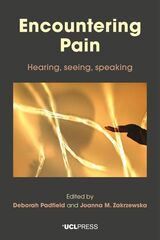 Encountering Pain: Hearing, Seeing, Speaking
Edited by Deborah Padfield and Joanna M. Zakrzewska
University College London, 2020 A unique compilation of voices that speak to the phenomenon of persistent pain and how it can be better communicated.
What is pain—and how do we communicate it? Persistent pain changes the brain and nervous system so that it can no longer warn of danger. However, despite being a major cause of disability globally, pain remains difficult to communicate. As language struggles to bridge the gap between those who suffer from pain and those who are trying to help, this book shares leading research into the potential value of visual images and non-verbal forms of communication as means of improving interactions between clinicians and their patients. Accompanied by vivid photographs co-created with those who live with pain, the volume integrates the voices of leading scientists, academics, and contemporary artists to provide a manual for understanding the meanings of pain for healthcare professionals, pain patients, students, academics, and artists.
 Encountering the Past in Nature: Essays in Environmental History
Timo Myllyntaus
Ohio University Press, 2000 A deeper understanding of contemporary environmental problems requires us to know where we come from, and the study of environmental history will help us in that quest. Environmental history, in short, may be described as an attempt to study the interaction between humans and nature in the past. How have human societies affected their environment and vice versa? What does history tell us about ecological change?
The essays in Encountering the Past in Nature provide various approaches to the new discipline. Experts with diverse educational backgrounds tackle important issues in environmental history, ranging from the intellectual formation of environmental concepts to case studies of forest history and animal extinction. Most essays in the collection focus on the issue of wilderness and the various uses of forest resources. Encountering the Past in Nature also offers introductory essays on the historiography and methodology of this field of historical study.
Encountering the Past in Nature is a useful addition to the introductory texts currently available in the United States.
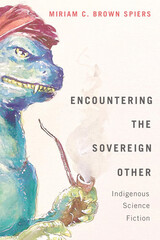 Encountering the Sovereign Other: Indigenous Science Fiction
Miriam C. Brown Spiers
Michigan State University Press, 2021 Science fiction often operates as either an extended metaphor for human relationships or as a genuine attempt to encounter the alien Other. Both types of stories tend to rehearse the processes of colonialism, in which a sympathetic protagonist encounters and tames the unknown. Despite this logic, Native American writers have claimed the genre as a productive space in which they can critique historical colonialism and reassert the value of Indigenous worldviews. Encountering the Sovereign Other proposes a new theoretical framework for understanding Indigenous science fiction, placing Native theorists like Vine Deloria Jr. and Gregory Cajete in conversation with science fiction theorists like Darko Suvin, David Higgins, and Michael Pinsky. In response to older colonial discourses, many contemporary Indigenous authors insist that readers acknowledge their humanity while recognizing them as distinct peoples who maintain their own cultures, beliefs, and nationhood. Here author Miriam C. Brown Spiers analyzes four novels: William Sanders’s The Ballad of Billy Badass and the Rose of Turkestan, Stephen Graham Jones’s It Came from Del Rio, D. L. Birchfield’s Field of Honor, and Blake M. Hausman’s Riding the Trail of Tears. Demonstrating how Indigenous science fiction expands the boundaries of the genre while reinforcing the relevance of Indigenous knowledge, Brown Spiers illustrates the use of science fiction as a critical compass for navigating and surviving the distinct challenges of the twenty-first century.
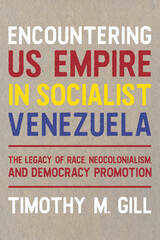 Encountering U.S. Empire in Socialist Venezuela: The Legacy of Race, Neo-Colonialism, and Democracy Promotion
Timothy M. Gill
University of Pittsburgh Press, 2022 Since the end of World War II, the United States has come to dominate the world economically and politically, leading many to describe the United States as an empire. Scholars have analyzed how the US government has worked through international financial institutions, its Central Intelligence Agency, and outright warfare to achieve its will. In this book, Timothy M. Gill spotlights how the US government also worked through democracy promotion to undermine governments abroad, including in Venezuela. President Hugo Chávez, who ruled from 1999 until his death in 2013, was among the democratically elected Latin American state leaders who embraced socialism and challenged the idea of US global power. Gill shows how US government agencies funded and trained opposition parties and activists, and how such intervention often was justified in neocolonial and racist terms. Through analysis of documents obtained through Freedom of Information Act requests, embassy cables, and interviews with US government and Venezuelan nonprofit members, Gill details such operations and the imperial thinking behind them.
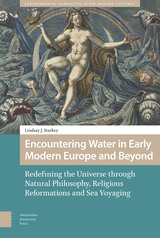 Encountering Water in Early Modern Europe and Beyond: Redefining the Universe through Natural Philosophy, Religious Reformations, and Sea Voyaging
Lindsay Starkey
Amsterdam University Press, 2020 Both the Christian Bible and Aristotle’s works suggest that water should entirely flood the earth. Though many ancient, medieval, and early modern Europeans relied on these works to understand and explore the relationships between water and earth, sixteenth-century Europeans particularly were especially concerned with why dry land existed. This book investigates why they were so interested in water’s failure to submerge the earth when their predecessors had not been. Analyzing biblical commentaries as well as natural philosophical, geographical, and cosmographical texts from these periods, Lindsay Starkey shows that European sea voyages to the southern hemisphere combined with the traditional methods of European scholarship and religious reformations led sixteenth-century Europeans to reinterpret water and earth’s ontological and spatial relationships. The manner in which they did so also sheds light on how we can respond to our current water crisis before it is too late.
 Encounters and Dialogues with Martin Heidegger, 1929-1976
Heinrich Wiegand Petzet
University of Chicago Press, 1993 Despite his predominance in twentieth-century philosophy, no intellectual biography of Martin Heidegger has yet appeared. This account of Heidegger's personal relations, originally published in German and extensively corrected by the author for this translation, enlarges our understanding of a complex figure.
A well-known art historian and an intimate friend of Heidegger's, Heinrich Wiegand Petzet provides a rich portrait of Heidegger that is part memoir, part biography, and part cultural history. By recounting chronologically a series of encounters between the two friends from their meeting in 1929 until the philosopher's death in 1976, as well as between Heidegger and other contemporaries, Petzet reveals not only new aspects of Heidegger's thought and attitudes toward the historical and intellectual events of his time but also the greater cultural and social context in which he articulated his thought.
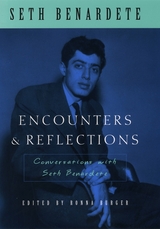 Encounters and Reflections: Conversations with Seth Benardete
Seth Benardete
University of Chicago Press, 2002 By turns wickedly funny and profoundly illuminating, Encounters and Reflections presents a captivating and unconventional portrait of the life and works of Seth Benardete. One of the leading scholars of ancient thought, Benardete here reflects on both the people he knew and the topics that fascinated him throughout his career in a series of candid, freewheeling conversations with Robert Berman, Ronna Burger, and Michael Davis.
The first part of the book discloses vignettes about fellow students, colleagues, and acquaintances of Benardete's who later became major figures in the academic and intellectual life of twentieth-century America. We glimpse the student days of Allan Bloom, Stanley Rosen, George Steiner, and we discover the life of the mind as lived by well-known scholars such as David Grene, Jacob Klein, and Benardete's mentor Leo Strauss. We also encounter a number of other learned, devoted, and sometimes eccentric luminaries, including T.S. Eliot, James Baldwin, Werner Jaeger, John Davidson Beazley, and Willard Quine. In the book's second part, Benardete reflects on his own intellectual growth and on his ever-evolving understanding of the texts and ideas he spent a lifetime studying. Revisiting some of his recurrent themes—among them eros and the beautiful, the city and the law, and the gods and the human soul—Benardete shares his views on thinkers such as Plato, Homer, and Heidegger, as well as the relations between philosophy and science and between Christianity and ancient Roman thought.
Engaging and informative, Encounters and Reflections brings Benardete's thought to life to enlighten and inspire a new generation of thinkers.
Encounters in Modern Hebrew: Level 1
Edna Amir Coffin
University of Michigan Press, 1992 Encounters in Modern Hebrew is designed to fulfill the needs of English-speaking students who want to gain a basic knowledge of modern Hebrew. Extensively classroom-tested at the University of Michigan, the text provides a comprehensive introduction to the reading, writing, and pronunciation of modern Hebrew through an array of interesting exercises and activities reflecting up-to-the-minute language-learning theory.
Encounters in Modern Hebrew: Level 2
Edna Amir Coffin
University of Michigan Press, 1993 Encounters in Modern Hebrew is designed to fulfill the needs of English-speaking students who want to gain a basic knowledge of modern Hebrew. Extensively classroom-tested at the University of Michigan, the text provides a comprehensive introduction to the reading, writing, and pronunciation of modern Hebrew through an array of interesting exercises and activities reflecting up-to-the-minute language-learning theory.
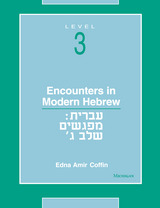 Encounters in Modern Hebrew: Level 3
Edna Amir Coffin
University of Michigan Press, 1997 Encounters in Modern Hebrew is designed to fulfill the needs of English-speaking students of Hebrew who seek oral and written communication and reading comprehension. Extensively classroom-tested at the University of Michigan, the text provides the means to acquire a meaningful command of the Hebrew language with an emphasis on an expansive vocabulary and a variety of language domains. Employing interesting exercises and activities, Encounters in Modern Hebrew, Level 3 incorporates many current communicative and culturally-based approaches to mastering a foreign language. Encounters in Modern Hebrew, Level 3 presents a study environment conducive to the speaking, reading, and writing of free and authentic Hebrew.
This volume shows students a wider range of Hebrew-speaking cultural activities in a larger human context, from materials about holidays, including a Jewish holiday celebrated only in North Africa, to discussions of the roles of women that raise the issue of gender equality. Other chapters examine ethnic jokes and their problematic qualities, geography, and the differences between popular and literary language registers. Encounters in Modern Hebrew, Level 3 ushers the Hebrew student through a wide domain of the human community.
Edna Amir Coffin is Arthur F. Thurnau Professor of Modern Hebrew Language and Literature and Senior Research Scientist, Center for Learning and Teaching, University of Michigan.
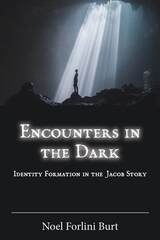 Encounters in the Dark: Identity Formation in the Jacob Story
Noel Forlini Burt
SBL Press, 2020 An interdisciplinary study of a familiar patriarchal narrative
Encounters in the Dark: Identity Formation in the Jacob Story traces the many moments of darkness in the life of Jacob. From the darkness of his mother's womb, to the darkness Jacob uses to deceive his father and his brother, to the night he sleeps on the ground with just a stone for a pillow at Bethel, and to the triumphant scene of wrestling God by the Jabbok River, the biblical story frequently situates Jacob in the darkness. Through an exploration of key moments in Jacob's story, Noel Forlini Burt follows Jacob's journey from home to exile and back home again. His story symbolizes the larger story of Israel's own wrestling with God in the darkness of exile and return.
Features
- An exploration of the poetics and rhetoric of the Jacob story
- An examination of characterization in its ancient and modern contexts
- An analysis of individual and collective identity
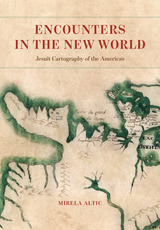 Encounters in the New World: Jesuit Cartography of the Americas
Mirela Altic
University of Chicago Press, 2022 Analyzing more than 150 historical maps, this book traces the Jesuits’ significant contributions to mapping and mapmaking from their arrival in the New World.
In 1540, in the wake of the tumult brought on by the Protestant Reformation, Saint Ignatius of Loyola founded the Society of Jesus, also known as the Jesuits. The Society’s goal was to revitalize the faith of Catholics and to evangelize to non-Catholics through charity, education, and missionary work. By the end of the century, Jesuit missionaries were sent all over the world, including to South America. In addition to performing missionary and humanitarian work, Jesuits also served as cartographers and explorers under the auspices of the Spanish, Portuguese, and French crowns as they ventured into remote areas to find and evangelize to native populations.
In Encounters in the New World, Mirela Altic analyzes more than 150 of their maps, most of which have never previously been published. She traces the Jesuit contribution to mapping and mapmaking from their arrival in the New World into the post-suppression period, placing it in the context of their worldwide undertakings in the fields of science and art. Altic’s analysis also shows the incorporation of indigenous knowledge into the Jesuit maps, effectively making them an expression of cross-cultural communication—even as they were tools of colonial expansion. This ambiguity, she reveals, reflects the complex relationship between missions, knowledge, and empire. Far more than just a physical survey of unknown space, Jesuit mapping of the New World was in fact the most important link to enable an exchange of ideas and cultural concepts between the Old World and the New.
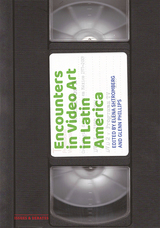 Encounters in Video Art in Latin America
Elena Shtromberg
J. Paul Getty Trust, The, 2023 With insightful essays and interviews, this volume examines how artists have experimented with the medium of video across different regions of Latin America since the 1960s.
The emergence of video art in Latin America is marked by multiple points of development, across more than a dozen artistic centers, over a period of more than twenty-five years. When it was first introduced during the 1960s, video was seen as empowering: the portability of early equipment and the possibility of instant playback allowed artists to challenge and at times subvert the mainstream media. Video art in Latin America was—and still is—closely related to the desire for social change. Themes related to gender, ethnic, and racial identity as well as the consequences of social inequality and ecological disasters have been fundamental to many artists’ practices.
This compendium explores the history and current state of artistic experimentation with video throughout Latin America. Departing from the relatively small body of existing scholarship in English, much of which focuses on individual countries, this volume approaches the topic thematically, positioning video artworks from different periods and regions throughout Latin America in dialogue with each other. Organized in four broad sections—Encounters, Networks and Archives, Memory and Crisis, and Indigenous Perspectives—the book’s essays and interviews encourage readers to examine the medium of video across varied chronologies and geographies.
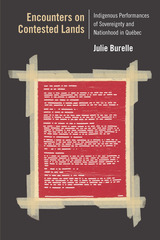 Encounters on Contested Lands: Indigenous Performances of Sovereignty and Nationhood in Québec
Julie Burelle
Northwestern University Press, 2019 Winner, 2019 John W. Frick Book Award
Winner, 2020 Ann Saddlemyer Award
Finalist, ATHE Outstanding Book Award for 2020
Mention Spéciale, Société québécoise d'études théâtrale
In Encounters on Contested Lands, Julie Burelle employs a performance studies lens to examine how instances of Indigenous self-representation in Québec challenge the national and identity discourses of the French Québécois de souche—the French-speaking descendants of white European settlers who understand themselves to be settlers no more but rather colonized and rightfully belonging to the territory of Québec.
Analyzing a wide variety of performances, Burelle brings together the theater of Alexis Martin and the film L'Empreinte, which repositions the French Québécois de souche as métis, with protest marches led by Innu activists; the Indigenous company Ondinnok's theater of repatriation; the films of Yves Sioui Durand, Alanis Obomsawin, and the Wapikoni Mobile project; and the visual work of Nadia Myre. These performances, Burelle argues, challenge received definitions of sovereignty and articulate new ones while proposing to the province and, more specifically, to the French Québécois de souche, that there are alternative ways to imagine Québec's future and remember its past.
The performances insist on Québec's contested nature and reframe it as animated by competing sovereignties. Together they reveal how the "colonial present tense" and "tense colonial present" operate in conjunction as they work to imagine an alternative future predicated on decolonization. Encounters on Contested Lands engages with theater and performance studies while making unique and needed contributions to Québec and Canadian studies, as well as to Indigenous and settler-colonial studies.
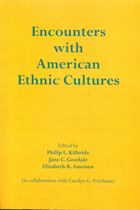 Encounters with American Ethnic Cultures
Edited by Philip L. Kilbride, Jane C. Goodale, and Elizabeth R. Ameisen
University of Alabama Press, 1990 Encounters with American Ethnic Cultures represents a cultural approach to understanding ethnic diversity in the Philadelphia metropolitan area. Thirteen chapters, each using an ethnographic field methodology, explore such ethnic experience as the "invisible" (WASPS and African-Americans); "self-chosen" (Welsh-American, Irish-American, and Ukrainian-American); "gender-related" (the Lubovitcher); "religious" (Jewish, Native American, Greek-American, and Puerto Rican); and "dislocated" (Cambodians and the homeless). Ethnographic fieldwork focuses an insider's view on the meaning of ethnic experience in the lives of participants in the research. This volume examines the role and function of various ethnic endeavors in the preservation and maintenance of ethnic identity by contemporary Americans. This five part volume includes:
Introduction: Ethnic Culture Analysis—A Course of Study, Jane C. Goodale and Philip L. Kilbride
Methodology, Elizabeth R. Ameisen and Carolyn G. Friedman
Part I. Black and WASP in American Cultural Experience: The Invisible Ones
Exclusivity in an Ethnic Elite: Racial Prejudice as Boundary Maintenance, Elizabeth R. Ameisen
Africans and African-Americans: An Ethnohistorical View and Symbolic Analysis of Food Habits, Carolyn G. Friedman
Part II. Self-Chosen Ethnicity
Unique Americans: The Welsh-American Ethnic Group in the Philadelphia Area, Lorraine Murray
Irish-Americans and Irish Dance: Self-Chosen Ethnicity, Erin McGauley Hebard
Art and Identity: Ukrainian-American Ethnicity, Jennifer Krier
Part III. Interpretations of Gender and Ethnicity: The Lubavitcher Experience
Equality Does Not Mean Sameness: The Role of Women within the Lubavitcher Marriage, Philip Baldinger
Strategies for Strength: Women and Personal Empowerment in Lubavitcher Hasidism, Gita Srinivasan
Part IV. Ethnicity and Religion: The Persistence of Collective Representations
Our Lives Revolve around the Holidays: Holidays in the Transmission of Jewish Ethnicity, Anna Dahlem
Fayetteville or Raleigh? An Analysis of an American Indian Baptist Church, Beth Batten
Issues in Greek Orthodoxy That Define and Maintain Greek-American Ethnicity, Karen L. Belsley
Es como si fuera la casa de uno: The Role of the Community Church in Maintaining Puerto Rican Ethnicity, Monica Schoch-Spana
Part V. Dislocation and Ethnicity
Cambodian Marriage: Marriage and How it is Changing among Cambodian Refugees in Philadelphia, Rebecca C. Popenoe
Ethnic Expression in a Jewish Street Person, Andrew Millstein
Conclusion, Philip L. Kilbride and Jane C. Goodale
Encounters with Kenneth Burke
William H. Rueckert
University of Illinois Press, 1994 William H. Rueckert's landmark
1963 study, Kenneth Burke and the Drama of Human Relations, is often
credited with bringing the field of Burke studies into existence. Here, Rueckert
has gathered his "encounters" with Burke over the past thirty years--brieft
talks, position papers, rethinking and reformation of earlier ideas, and detailed
analyses of individual texts--into one volume that offers readers the best of
Burkean criticism.
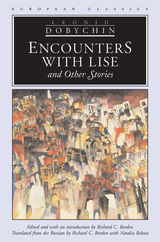 Encounters with Lise and Other Stories
Leonid Dobychin
Northwestern University Press, 2005 In 1994 Russian writer Victor Erofeyev proclaimed Leonid Dobychin "one of the main heroes of twentieth-century Russian literature." Obscure for many years, Dobychin is now celebrated as a modernist master. His short stories are hailed as a sort of Soviet version of Joyce's Dubliners-subtle and tightly constructed miniatures linked by recurring themes and full of ironic juxtaposition, context, allusion, and style.
For Dobychin early Soviet society was an absurdist wonderland. He was not anti-Soviet but trans-Soviet, practicing realism but looking at reality from jarring angles. A typical day for a Dobychin hero includes participation in character-building sports, witnessing a parade, attending a funeral, and memorial to fallen communists-and finally reflecting at the end of the day that he almost met a pretty young sick-nurse. Dobychin's stories reveal a Brave New World where idealism rubs shoulders with heartless ambition and political denunciation, and ubiquitous acronyms and revolutionary cliché maul the language. But he also describes the absurdities of a place where office girls pray for the arrest of disliked co-workers and prisoner work gangs are made to spell out beautiful but empty platitudes in beds of sand. This collection includes all of the stories published in Dobychin's lifetime, plus two stories that remained unpublished until the late 1980s.
 Encounters with Nature: Essays By Paul Shepard
Paul Shepard; Edited by Florence R. Shepard; Introduction by David Petersen
Island Press, 2000 While most scholars work within the safe, sturdy confines of conventional academics, Paul Shepard moved beyond convention, out under the open sky where he was free to turn and peer in every direction. Blending, sifting, and culling massive mounds of scientific, historical, and deductive data -- drawn from biology, ecology, ethology, anthropology, archaeology, psychology, sociology, philosophy, and even art -- he searched for shards of truth, then fit those pieces together to give logical and meaningful shape to our world. His interdisciplinary approach brought together diverse fields of research, embodying in a sense Edward O. Wilson's recently proposed idea of "consilience" -- the unity of knowledge needed in the fragmented world of academic specialization.Throughout the vast body of Shepard's literary legacy, certain themes appear repeatedly: the aesthetics and perception of landscape and nature; animals and their pervasive influence on our humanity; ontogeny, the development of the individual in complicity with nature and with culture; and "place" as the grounding of our being. Encounters with Nature brings together twenty-one essays written over a span of four decades that explore those themes and chronicle an interlocking progression of knowledge and insight that certifies Paul Shepard as one of the most brilliant thinkers of our time.The essays were selected and edited by Florence Shepard, who also provides a preface and substantial notes that introduce each section; her contributions offer illuminating biographical information that places the essays within the context of Shepard's life. In addition, the book features an introductory essay by writer David Petersen that discusses the meaning and importance of Shepard's guiding ideas.Encounters with Nature gives the reader a deeper understanding of Paul Shepard's thought, bringing his intellectual development into closer focus and providing a valuable overview of his life and vision. The book will bring a greater appreciation of the prescience and timelessness of Shepard's writings to his many followers and friends, and can also serve to introduce new readers to the remarkable breadth and depth of his work and insight.
 Encounters with Rauschenberg: (A Lavishly Illustrated Lecture)
Leo Steinberg
University of Chicago Press, 2000 In his insightful and engrossing lecture, Leo Steinberg surveys and critiques the work of Robert Rauschenberg, one of the great American post-war artists. He also discusses his own experience as a critic in the exciting and turbulent art world of New York in the 1950s and 1960s. The result is a rare glimpse not only into Rauschenberg, but also into Steinberg.
With the sharpness and confidence that can only come from a critic who has long been involved with Rauschenberg's work, Steinberg offers an in-depth discussion of such major pieces as the Erased DeKooning Drawing, Bed, and Monogram. He explains the subtle differences between his interpretations and those of other critics, such as Clement Greenberg and Hilton Kramer. He candidly reflects on how he has changed his mind over the years, and defends his new ideas about Rauschenberg's work with precise, fresh arguments. He critically evaluates Rauschenberg's more recent work and addresses how it falls short from the artist's earlier work.
From Rauschenberg's silk-screen prints of the 1960s to the vegetable dye transfer prints of the 1990s, Steinberg warns against the dangers of overinterpretation and iconographic enthusiasm. He argues that the unifying strand through this great artist's work is his drive to appropriate, to take objects and images from the world and make them his own by making them become a part of his art.
Provocative, intelligent, and beautifully articulated, Steinberg's words shed light on one remarkable artist and on the post-war New York art scene, on Steinberg's particular appreciation of Rauschenberg and on his life's work as an art critic.
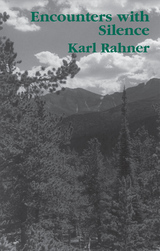 Encounters With Silence
Karl Rahner
St. Augustine's Press, 1999 One of the classics of modern spirituality, Encounters with Silence is one of Karl Rahner’s most lucid and powerful books. A book of meditations about man’s relation with God, it is not a work of dry theology, but rather a book of prayerful reflections on love, knowledge, and faith, obedience, everyday routines, life with our friends and neighbors, our work and vocation, and human goodness. The immense success of this moving work is a tribute to its practicality and the ability of the great theologian to speak simply and yet profoundly to ordinary men and women seeking an inspiring guide to the inner life, one that never forsakes the world of reality. The book is cast in the form of a dialogue with God that moves from humble but concerned inquiry to joyful contemplation. “You will come again because the fact that you have already come must continue to be revealed ever more clearly. It must become progressively manifest to the world that the heart of all things is already transformed, because you have taken them all to your heart. . . . The false appearance of our world, the shabby pretense that it has not been liberated . . . must be more and more thoroughly rooted out and destroyed. . . . And your coming is neither past nor future, but the present, which has only to reach its fulfillment. Now it is still the one single hour of your advent.” (from the book)
Encounters with the Americas
Rosemary A. Joyce and Susan A. M. ShumakerPhotographs by Hillel S. Burger
Harvard University Press, 1995 Historic black-and-white photographs and striking color images of archaeological and ethnographic objects enhance this introduction to one of the world’s most significant Central and South American anthropological collection. Encounters with the Americas also places the museum in a living context through first-person accounts of sixteenth-century contact between Europeans and Aztec and Maya peoples and post-Columbian encounters of Native peoples with explorers and anthropologists.
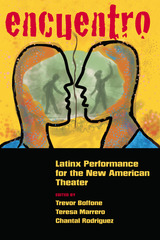 Encuentro: Latinx Performance for the New American Theater
Edited by Trevor Boffone, Teresa Marrero, and Chantal Rodriguez
Northwestern University Press, 2019 This anthology has its origins in the Encuentro theater festival, which was produced by the Latino Theater Company in association with the Latinx Theatre Commons in Los Angeles in 2014. Encuentro means “an encounter,” and meetings form a core theme in these six groundbreaking plays, each prefaced by a critical introduction from a leading Latinx theater scholar.
Playwrights Ruben C. Gonzalez, José Torres-Tama, Rickerby Hinds, Mariana Carreño King, Javier Antonio González, and Evelina Fernández exhibit a wide range of aesthetic approaches, dramatic structures, and themes, ranging from marriage, gentrification, racial and gendered violence, migration, and the ever-present politics of the U.S.–Mexico border. There is power in the communal experience of creating, witnessing, and participating in theater festivals. This anthology is a testament to that power and seeks to document the historic festival as well as to make these works available to a wider audience.
Encuentro: Latinx Performance for the New American Theater addresses interests of general audiences committed to the performing arts; scholars and students of Latinx, gender, and ethnic studies; university, college, and high school theater programs; and regional theaters looking to diversify their programming.
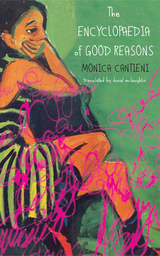 The Encyclopaedia of Good Reasons
Monica Cantieni
Seagull Books, 2014 “My father bought me from the council for 365 francs,” recalls the narrator in Monica Cantieni’s novel The Encyclopaedia of Good Reasons. She’s a young girl, an immigrant to Switzerland whose adoption is yet to be finalized. When she finally moves into her new home with her new family, she recounts her days in the orphanage and how starkly different her life is now. Her new community speaks German, a language foreign to her, and she collects words and phrases in matchboxes. Though her relationship with her adoptive parents is strained, she bonds with her adoptive grandfather Tat, and together they create the eponymous “Encyclopaedia of Good Reasons.”
Set in the time of the crucial 1970 Swiss referendum on immigration, Monica Cantieni introduces us to a host of colorful characters who struggle to make Switzerland their home: Eli, the Spanish bricklayer; Toni, the Italian factory worker with movie star looks; Madame Jelisaweta, the Yugoslav hairdresser; and Milena, the mysterious girl in the wardrobe. This is a book with a very warm heart, and rarely has a young girl’s narrative been at once so uproariously hilarious and so deeply moving.
 Encyclopaedia of Midrash: Biblical Interpretation in Formative Judaism
Jacob Neusner
SBL Press, 2016 Now in Paperback!
The Encyclopedia of Midrash provides readers with a deep, broad treatment of midrash unavailable in any other single source. Through the writings of top scholars in each of their fields, it sets out the current state of the question for the many topics discussed throughout the two-volume set. The encyclopedia treats interpretations of Scripture that came to closure prior to, or outside of, the framework of rabbinic midrash: Hellenistic Jewish midrash, Josephus, Pseudo-Philo, Jubilees, as well as to the New Testament, Karaite and Samaritan writings, and the Dead Sea Scrolls.
Features:
- Paperback format of an essential Brill hardcover reference set
- A general introduction to rabbinic midrash and its traits
- Discussion of rabbinic midrashic documents focused on specific books of Scripture, the theology expressed by rabbinic midrashic compilations, and the historical context in which rabbinic Midrash took shape
Encyclopedia of Arkansas Music
Ali Welky
Butler Center for Arkansas Studies, 2013 What do a rockabilly musician turned cinematic swamp monster, a composer of player-piano music, an avant-garde cellist, a musical instrument that lent its name to a weapon, a rock musician turned Catholic monk, some of the best audio speakers in the world, and the creator of Schoolhouse Rock! have in common? That’s right–they all come from Arkansas. Encyclopedia of Arkansas Music is a special project of the Encyclopedia of Arkansas History & Culture (EOA), an online encyclopedia launched in 2006 by the Butler Center for Arkansas Studies at the Central Arkansas Library System. This colorful, photo-filled reference work spanning all aspects of Arkansas’s musical past and present includes more than 150 entries on musicians, ensembles, musical works, and events.
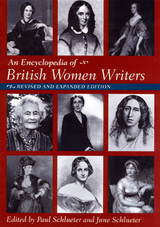 Encyclopedia of British Women Writers
Schlueter, Paul
Rutgers University Press, 1999 This far-reaching examination of women writers identified with Great Britain builds on its predecessor's strengths, with 50 percent new material and completely updated entries. Over six hundred writers are discussed in terms of their biographies--with precise details where these could be ascertained and in come cases correcting biographies in other reference works--as well as in terms of thematic issues and critical reception. Each entry includes a definitive bibliography of the writer and a thorough secondary bibliography (including book-length studies, reference works, major essays, and reviews) to lead readers to other sources. Available in paperback for the first time, this book is an ideal desk reference for scholar and student alike.
Paul Schlueter and June Schlueter have individually and jointly written and edited a number of critical and reference works, including The English Novel: Twentieth Century Criticism (Vol. 2: Twentieth Century Novelists) and Modern American Literature (Supplement 2). Paul Schlueter's books include The Novels of Doris Lessing and Shirley Ann Grau. June Schlueter, Provost, and Dana Professor of English at Lafayette College, has edited Feminist Readings of Modern American Drama and Modern American Drama: The Female Canon.
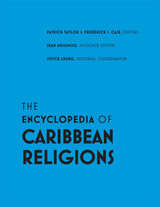 The Encyclopedia of Caribbean Religions: Volume 1: A - L; Volume 2: M - Z
Patrick Taylor
University of Illinois Press, 2012 The Encyclopedia of Caribbean Religions is the definitive reference for Caribbean religious phenomena from a Caribbean perspective. Generously illustrated, this landmark project combines the breadth of a comparative approach to religion with the depth of understanding of Caribbean spirituality as an ever-changing and varied historical phenomenon. Organized alphabetically, entries examine how Caribbean religious experiences have been shaped by and have responded to the processes of colonialism and the challenges of the postcolonial world. Systematically organized by theme and area, the encyclopedia considers religious traditions such as Vodou, Rastafari, Sunni Islam, Sanatan Dharma, Judaism, and the Roman Catholic and Seventh-day Adventist churches. Detailed subentries present topics such as religious rituals, beliefs, practices, specific historical developments, geographical differences, and gender roles within major traditions. Also included are entries that address the religious dimensions of geographical territories that make up the Caribbean. Representing the culmination of more than a decade of work by the associates of the Caribbean Religions Project, The Encyclopedia of Caribbean Religions will foster a greater understanding of the role of religion in Caribbean life and society, in the Caribbean diaspora, and in wider national and transnational spaces.
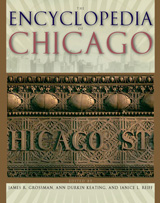 The Encyclopedia of Chicago
Edited by James R. Grossman, Ann Durkin Keating, and Janice L. Reiff
University of Chicago Press, 2004 One of the great American metropolises, Chicago rises out of the prairie in the heart of the country, buffeted by winds coming off the plains and cooled by the waters of the inland sea of Lake Michigan. Chicago is a city of size and mass, the cradle of modern architecture, the freight hub of the nation, a city built on slaughterhouses and cacophonous financial trading tempered by some of the finest cultural institutions in the world. While many histories have been written of the city, none can claim the scope and breadth of the long-awaited Encyclopedia of Chicago.
Developed by the Newberry Library with the cooperation of the Chicago Historical Society, The Encyclopedia of Chicago is the definitive historical reference on metropolitan Chicago. More than a decade in the making, the Encyclopedia brings together hundreds of historians, journalists, and experts on everything from airlines to Zoroastrians to explore all aspects of the rich world of Chicagoland, from its geological prehistory to the present.
The main alphabetical section of the Encyclopedia, comprising more than 1,400 entries, covers the full range of Chicago's neighborhoods, suburbs, and ethnic groups, as well as the city's cultural institutions, technology and science, architecture, religions, immigration, transportation, business history, labor, music, health and medicine, and hundreds of other topics. The Encyclopedia has the widest geographical reach of any city encyclopedia of its kind, encompassing eight of the region's counties, including suburbs. Nearly 400 thumbnail maps pinpoint Chicago neighborhoods and suburban municipalities; these maps are complemented by hundreds of black-and-white and color photographs and thematic maps that bring the history of metropolitan Chicago to life. Additionally, contributors have provided lengthy interpretive essays—woven into the alphabetical section but set off graphically—that take a long view of such topics as the built environment, literary images of Chicago, and the city's often legendary and passionate sports culture.
The Encyclopedia also offers a comprehensive biographical dictionary of more than 2,000 individuals important to Chicago history and a detailed listing of approximately 250 of the city's historically significant business enterprises. A color insert features a timeline of Chicago history and photo essays exploring nine pivotal years in this history.
The Encyclopedia of Chicago is one of the most significant historical projects undertaken in the last twenty years, and it has everything in it to engage the most curious historian as well as settle the most boisterous barroom dispute. If you think you know how Chicago got its name, if you have always wondered how the Chicago Fire actually started and how it spread, if you have ever marveled at the Sears Tower or the reversal of the Chicago River—if you have affection, admiration, and appreciation for this City of the Big Shoulders, this Wild Onion, this Urbs in Horto, then The Encyclopedia of Chicago is for you.
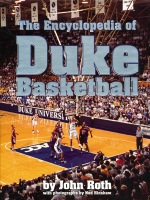 The Encyclopedia of Duke Basketball
John Roth
Duke University Press, 2006 Duke basketball is one of the most celebrated programs in intercollegiate athletics. With fourteen Final Four appearances and three national championships for the men’s teams and four Final Four appearances and five ACC championships for the women’s teams, the Blue Devils have established a worldwide reputation for excellence and have inspired the fierce devotion of generations of fans. The Encyclopedia of Duke Basketball is the ultimate reference source for true-blue fans, with profiles of great games, classic finishes (both wins and losses), and compelling personalities, including players, coaches, and opponents. While it is filled with a wealth of statistical information, the Encyclopedia goes well beyond the numerical record to deliver insights on people and performances and anecdotes that will surprise even the most seasoned Duke supporter. The Encyclopedia features:
— A timeline of key events in men’s and women’s basketball history.
— Capsules of the most important men’s and women’s games in the program’s history, including the men’s buzzer-beating overtime win against Kentucky in 1992 and the women’s stunning victory over Tennessee to reach the Final Four in 1999.
— An alphabetical encyclopedia with entries on players from Alaa Abdelnaby to Bill Zimmer and on coaches, customs, opponents, venues, and records.
— Exclusive interviews in which standout players, including Danny Ferry, Mike Gminski, Grant Hill, Christian Laettner, and Jason Williams, recount moments they’ll never forget.
— A statistical record book covering every season through 2005–06.
—130 photographs of Duke basketball history. A source of entertainment as well as information, this volume will be a great resource for fans hoping to settle arguments, relive favorite games, or simply enjoy hours of pleasurable reading.
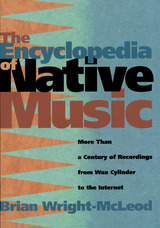 The Encyclopedia of Native Music: More Than a Century of Recordings from Wax Cylinder to the Internet
Brian Wright-McLeod
University of Arizona Press, 2005 Want the word on Buffy Sainte-Marie? Looking for the best powwow recordings? Wondering what else Jim Pepper cut besides “Witchi Tai To”? This book will answer those questions and more as it opens up the world of Native American music.
In addition to the widely heard sounds of Carlos Nakai’s flute, Native music embraces a wide range of forms: country and folk, jazz and swing, reggae and rap. Brian Wright-McLeod, producer/host of Canada’s longest-running Native radio program, has gathered the musicians and their music into this comprehensive reference, an authoritative source for biographies and discographies of hundreds of Native artists.
The Encyclopedia of Native Music recognizes the multifaceted contributions made by Native recording artists by tracing the history of their commercially released music. It provides an overview of the surprising abundance of recorded Native music while underlining its historical value.
With almost 1,800 entries spanning more than 100 years, this book leads readers from early performers of traditional songs like William Horncloud to artists of the new millennium such as Zotigh. Along the way, it includes entries for jazz and blues artists never widely acknowledged for their Native roots—Oscar Pettiford, Mildred Bailey, and Keely Smith—and traces the recording histories of contemporary performers like Rita Coolidge and Jimmy Carl Black, “the Indian of the group” in the original Mothers of Invention. It also includes film soundtracks and compilation albums that have been instrumental in bringing many artists to popular attention. In addition to music, it lists spoken-word recordings, including audio books, comedy, interviews, poetry, and more.
With this unprecedented breadth of coverage and extensively cross-referenced, The Encyclopedia of Native Music is an essential guide for enthusiasts and collectors. More than that, it is a gateway to the authentic music of North America—music of the people who have known this land from time immemorial and continue to celebrate it in sound.
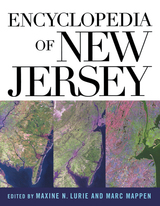 Encyclopedia of New Jersey
Lurie, Maxine
Rutgers University Press, 2004 Designated Best of Reference by The New York Public Library based on its usefulness in New York City's libraries
Named an Outstanding Reference Work by the New Jersey Studies Academic Alliance The Encyclopedia of New Jersey is the most extensive reference work ever published on the Garden State. The Encyclopedia contains nearly 3,000 original articles, along with 585 illustrations and 130 maps, collecting a wealth of information about the state in one volume. The Encyclopedia is filled with fascinating and interesting entries ranging from New Jersey's earliest history to the present. For example-Did you know that New Jersey was once divided into two parts-East Jersey and West Jersey? That streptomycin was first isolated at Rutgers University? Or that the first vote cast by an African American under the Fifteenth Amendment was in Perth Amboy? How about that New Jersey was the site of the first intercollegiate football game? These facts, and thousands more, can be found in the pages of the Encyclopedia of New Jersey. This volume will provide the answers to questions about New Jersey that you never even knew you had! Whether you are merely perusing the pages or are researching a particular subject, the Encyclopedia of New Jersey is your definitive source for information on the Garden State, covering a broad range of subject areas, including: * Architecture, decorative arts, painting, and sculpture
* Biographies
* Business and economics
* Communications and media
* Education
* Ethnicity
* Folklore, museums, and theater
* Geography
* History
* Government, law, politics, and public policy
* Literature
* Medicine and health
* Municipalities and counties
* Recreation and sports
* Religion
* Science and technology
* Transportation
* and many more subjects
Encyclopedia of Romantic Nationalism in Europe, Vol. 1 and 2
Edited by Joep Leerssen
Amsterdam University Press, 2016 This monumental encyclopedia documents the presence and effects of cultural consciousness-raising in the early decades of European nationalism. The volume tracks how intellectuals, historians, novelists, poets, painters, folklorists, and composers, in an intensely collaborative transnational network, articulated the national identities and aspirations that would go on to determine European history and politics with effects that are still felt today.
Encyclopedia of the Blues, 2nd Edition
Gerard Herzhaft
University of Arkansas Press, 1997 he popular Encyclopedia of the Blues, first published by the University of Arkansas Press in 1992 and reprinted six times, has become an indispensable reference source for all involved with or intrigued by the music. The work alphabetizes hundreds of biographical entries, presenting detailed examinations of the performers and of the instruments, trends, recordings, and producers who have created and popularized this truly American art form.
 The Encyclopedia of the Chinese Overseas
Lynn Pan
Harvard University Press, 1999 The first of its kind, this book offers a panoramic view of past and present overseas Chinese communities worldwide. From their arrival as laborers in the British colonies to their emergence as a force in Indonesia, Chinese emigrants have carried the experiences of China to other continents and civilizations, in the process modifying and enriching them. The Encyclopedia of the Chinese Overseas reflects the diverse histories and traditions that produced this diaspora, as well as the rich and various transmutations it has produced in turn.
Arranged geographically and thematically, with country-by-country profiles of individual Chinese communities, the book includes sections on the regional and cultural origins of emigrant communities; the history and patterns of migration; social, familial, and business institutions; and interethnic relations. An invaluable reference, it is as accessible as it is authoritative, highly readable from beginning to end. The engaging design employs boxed features, maps, graphs, tables, and a vast array of pictures to make complex material remarkably clear and vivid. A glossary identifies Chinese proper names and terms with their characters, while the bibliography gives full references to Chinese, English, French, and Spanish works.
Comprising signed articles by 50 noted scholars in Asia, North America, Europe (including Russia), Australia, and Africa, with a large advisory panel of eminent experts, the Encyclopedia is an unparalleled resource, providing an unprecedented view of one of the world's largest, oldest, and most varied cultures abroad.
Encyclopedia of the Dead
Danilo Kis
Northwestern University Press, 1997 The most famous collection of short fiction by acclaimed Yugoslavian writer Danilo Kis. In these nine stories Kis depicts human relationships, encounters, landscapes—the multitude of details that make up a human life. Kis combines fiction and history in postmodern style, and in a postscript provides fascinating historical backgrounds and other notes for the reader that add interest and context. An enduring classic of Slavic literary fiction.
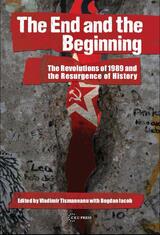 The End and the Beginning: The Revolutions of 1989 and the Resurgence of History
Vladimir Tismaneanu
Central European University Press, 2012 A fresh interpretation of the contexts, meanings, and consequences of the revolutions of 1989, coupled with state of the art reassessment of the significance and consequences of the events associated with the demise of communist regimes. The book provides an analysis that takes into account the complexities of the Soviet bloc, the events' impact upon Europe, and their re-interpretation within a larger global context. Departs from static ways of analysis (events and their significance) bringing forth approaches that deal with both pre-1989 developments and the 1989 context itself, while extensively discussing the ways of resituating 1989 in the larger context of the 20th century and of its lessons for the 21st.Emphasizes the possibility for re-thinking and re-visiting the filters and means that scholars use to interpret such turning point. The editors perceive the present project as a challenge to existing readings on the complex set of issues and topics presupposed by a re-evaluation of 1989 as a symbol of the change and transition from authoritarianism to democracy.
 The End Game: How Inequality Shapes Our Final Years
Corey M. Abramson
Harvard University Press, 2015 Winner of the Outstanding Publication Award, Section on Aging and the Life Course, American Sociological Association
Senior citizens from all walks of life face a gauntlet of physical, psychological, and social hurdles. But do the disadvantages some people accumulate over the course of their lives make their final years especially difficult? Or does the quality of life among poor and affluent seniors converge at some point? The End Game investigates whether persistent socioeconomic, racial, and gender divisions in America create inequalities that structure the lives of the elderly.
“Avoiding reductionist frameworks and showing the hugely varying lifestyles of Californian seniors, The End Game poses a profound question: how can provision of services for the elderly cater for individual circumstances and not merely treat the aged as one grey block? Abramson eloquently and comprehensively expounds this complex question.”
—Michael Warren, LSE Review of Books
“The author’s approach situates inequality experienced by older Americans in a real world context and links culture, social life, biological life, and structural disparities in ways that allow readers to understand the intersectionality of diversity imbued in the lives of older Americans…Abramson opens a window into the reality of old age, the importance of culture and the impact it has on shared/prior experiences, and the inequalities that structure them.”
—A. L. Lewis, Choice
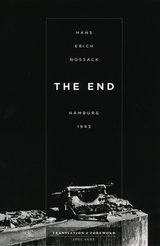 The End: Hamburg 1943
Hans Erich Nossack
University of Chicago Press, 2004 One didn't dare to inhale for fear of breathing it in. It was the sound of eighteen hundred airplanes approaching Hamburg from the south at an unimaginable height. We had already experienced two hundred or even more air raids, among them some very heavy ones, but this was something completely new. And yet there was an immediate recognition: this was what everyone had been waiting for, what had hung for months like a shadow over everything we did, making us weary. It was the end.
Novelist Hans Erich Nossack was forty-two when the Allied bombardments of German cities began, and he watched the destruction of Hamburg—the city where he was born and where he would later die—from across its Elbe River. He heard the whistle of the bombs and the singing of shrapnel; he watched his neighbors flee; he wondered if his home—and his manuscripts—would survive the devastation. The End is his terse, remarkable memoir of the annihilation of the city, written only three months after the bombing. A searing firsthand account of one of the most notorious events of World War II, The End is also a meditation on war and hope, history and its devastation. And it is the rare book, as W. G. Sebald noted, that describes the Allied bombing campaign from the German perspective.
In the first English-language edition of The End, Nossack's text has been crisply translated by Joel Agee and is accompanied by the photographs of Erich Andres. Poetic, evocative, and yet highly descriptive, The End will prove to be, as Sebald claimed, one of the most important German books on the firebombing of that country.
"A small but critical book, something to read in those quiet moments when we wonder what will happen next."—Susan Salter Reynolds, Los Angeles Times
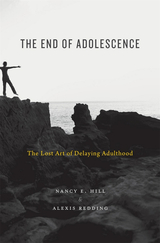 The End of Adolescence: The Lost Art of Delaying Adulthood
Nancy E. Hill and Alexis Redding
Harvard University Press, 2021 Is Gen Z resistant to growing up? A leading developmental psychologist and an expert in the college student experience debunk this stereotype and explain how we can better support young adults as they make the transition from adolescence to the rest of their lives.
Experts and the general public are convinced that young people today are trapped in an extended adolescence—coddled, unaccountable, and more reluctant to take on adult responsibilities than previous generations. Nancy Hill and Alexis Redding argue that what is perceived as stalled development is in fact typical. Those reprimanding today’s youth have forgotten that they once balked at the transition to adulthood themselves.
From an abandoned archive of recordings of college students from half a century ago, Hill and Redding discovered that there is nothing new about feeling insecure, questioning identities, and struggling to find purpose. Like many of today’s young adults, those of two generations ago also felt isolated and anxious that the path to success felt fearfully narrow. This earlier cohort, too, worried about whether they could make it on their own.
Yet, among today’s young adults, these developmentally appropriate struggles are seen as evidence of immaturity. If society adopts this jaundiced perspective, it will fail in its mission to prepare young adults for citizenship, family life, and work. Instead, Hill and Redding offer an alternative view of delaying adulthood and identify the benefits of taking additional time to construct a meaningful future. When adults set aside judgment, there is a lot they can do to ensure that young adults get the same developmental chances they had.
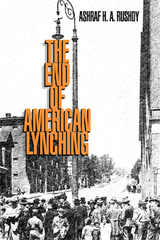 The End of American Lynching
Ashraf H. A. Rushdy
Rutgers University Press, 2012 The End of American Lynching questions how we think about the dynamics of lynching, what lynchings mean to the society in which they occur, how lynching is defined, and the circumstances that lead to lynching. Ashraf H. A. Rushdy looks at three lynchings over the course of the twentieth century—one in Coatesville, Pennsylvania, in 1911, one in Marion, Indiana, in 1930, and one in Jasper, Texas, in 1998—to see how Americans developed two distinct ways of thinking and talking about this act before and after the 1930s. One way takes seriously the legal and moral concept of complicity as a way to understand the dynamics of a lynching; this way of thinking can give us new perceptions into the meaning of mobs and the lynching photographs in which we find them. Another way, which developed in the 1940s and continues to influence us today, uses a strategy of denial to claim that lynchings have ended. Rushdy examines how the denial of lynching emerged and developed, providing insight into how and why we talk about lynching the way we do at the dawn of the twenty-first century. In doing so, he forces us to confront our responsibilities as American citizens and as human beings.
 The End of Area: Biopolitics, Geopolitics, History
Gavin Walker and Naoki Sakai, special issue editors
Duke University Press As technological innovation and cultural exchange challenge conventional borders, national identities, and notions of the nation-state, scholars have increasingly argued that the traditional concepts of “area” are ideological and political constructs tied to a schema of the world that no longer exists. This special issue of positions: asia critique posits that this “end of area” does not necessarily mean the end of area studies as a discipline. Rather, contributors suggest that “area” has detached itself from the realm of geopolitics and entered into the realm of biopolitics and biopower, which provides an opportunity to reevaluate and remap the goals of area studies. To address that change, this issue centers translation and the biopolitical as new theoretical mechanisms for area studies to order, combine, separate, and classify life. Topics include the concept of “area” itself; the philosophy of translation; reflections on Jean-François Lyotard, Jacques Derrida, and Edward Said; governmentality and biopower in the time of global capital; and biopolitical management of geocultural areas.
Contributors: Étienne Balibar, Ken C. Kawashima, Sandro Mezzadra, Tessa Morris-Suzuki, Naoki Sakai, Shu-Mei Shih, Jon Solomon, Tazaki Hideaki, Gavin Walker
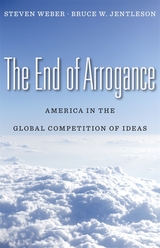 The End of Arrogance: America in the Global Competition of Ideas
Steven Weber and Bruce W. Jentleson
Harvard University Press, 2010 Free-market capitalism, hegemony, Western culture, peace, and democracy—the ideas that shaped world politics in the twentieth century and underpinned American foreign policy—have lost a good deal of their strength. Authority is now more contested and power more diffuse. Hegemony (benign or otherwise) is no longer a choice, not for the United States, for China, or for anyone else.
Steven Weber and Bruce Jentleson are not declinists, but they argue that the United States must take a different stance toward the rest of the world in this, the twenty-first century. Now that we can’t dominate others, we must rely on strategy, making trade-offs and focusing our efforts. And they do not mean military strategy, such as “the global war on terror.” Rather, we must compete in the global marketplace of ideas—with state-directed capitalism, with charismatic authoritarian leaders, with jihadism. In politics, ideas and influence are now critical currency.
At the core of our efforts must be a new conception of the world order based on mutuality, and of a just society that inspires and embraces people around the world.
 The End of Astronauts: Why Robots Are the Future of Exploration
Donald Goldsmith, Martin Rees
Harvard University Press, 2022 A History Today Book of the Year
A world-renowned astronomer and an esteemed science writer make the provocative argument for space exploration without astronauts.
Human journeys into space fill us with wonder. But the thrill of space travel for astronauts comes at enormous expense and is fraught with peril. As our robot explorers grow more competent, governments and corporations must ask, does our desire to send astronauts to the Moon and Mars justify the cost and danger? Donald Goldsmith and Martin Rees believe that beyond low-Earth orbit, space exploration should proceed without humans.
In The End of Astronauts, Goldsmith and Rees weigh the benefits and risks of human exploration across the solar system. In space humans require air, food, and water, along with protection from potentially deadly radiation and high-energy particles, at a cost of more than ten times that of robotic exploration. Meanwhile, automated explorers have demonstrated the ability to investigate planetary surfaces efficiently and effectively, operating autonomously or under direction from Earth. Although Goldsmith and Rees are alert to the limits of artificial intelligence, they know that our robots steadily improve, while our bodies do not. Today a robot cannot equal a geologist’s expertise, but by the time we land a geologist on Mars, this advantage will diminish significantly.
Decades of research and experience, together with interviews with scientific authorities and former astronauts, offer convincing arguments that robots represent the future of space exploration. The End of Astronauts also examines how spacefaring AI might be regulated as corporations race to privatize the stars. We may eventually decide that humans belong in space despite the dangers and expense, but their paths will follow routes set by robots.
 The End of Asylum
By Andrew I. Schoenholtz, Jaya Ramji-Nogales, and Philip G. Schrag
Georgetown University Press, 2021 The Trump administration's war on asylum and what Congress and the Biden administration can do about it Donald Trump’s 2016 campaign centered around immigration issues such as his promise to build a border wall separating the US and Mexico. While he never built a physical wall, he did erect a legal one. Over the past three years, the Trump administration has put forth regulations, policies, and practices all designed to end opportunities for asylum seekers. If left unchecked, these policies will effectually lead to the end of asylum, turning the United States—once a global leader in refugee aid—into a country with one of the most restrictive asylum systems. In The End of Asylum, three experts in immigration law offer a comprehensive examination of the rise and demise of the US asylum system. Beginning with the Refugee Act of 1980, they describe how Congress adopted a definition of refugee based on the UN Refugee Convention and prescribed equitable and transparent procedures for a uniform asylum process. The authors then chart the evolution of this process, showing how Republican and Democratic administrations and Congresses tweaked the asylum system but maintained it as a means of protecting victims of persecution—until the Trump administration. By expanding his executive reach, twisting obscure provisions in the law, undermining past precedents, and creating additional obstacles for asylum seekers, Trump’s policies have effectively ended asylum. The book concludes with a roadmap and a call to action for the Biden administration and Congress to repair and reform the US asylum system. This eye-opening work reveals the extent to which the Trump administration has dismantled fundamental American ideals of freedom from persecution and shows us what we can do about it.
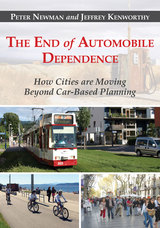 The End of Automobile Dependence: How Cities are Moving Beyond Car-Based Planning
Peter Newman and Jeffrey Kenworthy
Island Press, 2015 Cities will continue to accommodate the automobile, but when cities are built around them, the quality of human and natural life declines. Current trends show great promise for future urban mobility systems that enable freedom and connection, but not dependence. We are experiencing the phenomenon of peak car use in many global cities at the same time that urban rail is thriving, central cities are revitalizing, and suburban sprawl is reversing. Walking and cycling are growing in many cities, along with ubiquitous bike sharing schemes, which have contributed to new investment and vitality in central cities including Melbourne, Seattle, Chicago, and New York.
We are thus in a new era that has come much faster than global transportation experts Peter Newman and Jeffrey Kenworthy had predicted: the end of automobile dependence. In The End of Automobile Dependence, Newman and Kenworthy look at how we can accelerate a planning approach to designing urban environments that can function reliably and conveniently on alternative modes, with a refined and more civilized automobile playing a very much reduced and manageable role in urban transportation. The authors examine the rise and fall of automobile dependence using updated data on 44 global cities to better understand how to facilitate and guide cities to the most productive and sustainable outcomes.
This is the final volume in a trilogy by Newman and Kenworthy on automobile dependence (Cities and Automobile Dependence in 1989 and Sustainability and Cities: Overcoming Automobile Dependence in 1999). Like all good trilogies this one shows the rise of an empire, in this case that of the automobile, the peak of its power, and the decline of that empire.
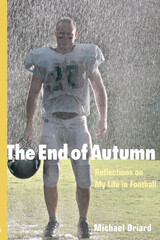 The End of Autumn: Reflections on My Life in Football
Michael Oriard
University of Illinois Press, 2009 Much of Michael Oriard's education took place outside the schoolroom of his native Spokane, Washington, during "slaughter practices" on high school football fields. He was taught to "punish" and "dominate," to rouse his school spirit with religion, and to "tough it" through injuries, even serious ones. At the age of eighteen he entered Notre Dame and walked onto the football team, where studying hard was never harder. By his senior year, playing for Ara Parseghian's Fighting Irish, he was the starting center and co-captain of the team. After graduating, he signed with the Kansas City Chiefs and head coach Hank Stram. There he learned what it meant to be "owned." He rediscovered the game as it was played by grown men with families who were still treated like children and who dreaded nothing more than the end of their football careers. And without their fully realizing the consequences, every hard tackle inflicted its injury, some gradually growing into chronic conditions, some suddenly cutting a player's career short and ushering him off the field to be soon forgotten. In this thoughtful narrative, Oriard describes the dreams of glory, the game day anxieties, the brutal training camps and harsh practices, his starry-eyed experience at Notre Dame, and the cold-blooded business of professional football. Told from the inside, the book leaves aside the hype and the pathos of the game to present a direct and honest account of the personal rewards but also the costs players paid to make others rich and entertained. Originally published in 1982, The End of Autumn recounts the experiences of an ordinary player in a bygone era--before ESPN, before the Bowl Championship Series, before free agency and million-dollar salaries for NFL players. In a new afterword, Oriard reflects on the process of writing the book and how the game has changed in the thirty years since his "retirement" from football at the age of twenty-six.
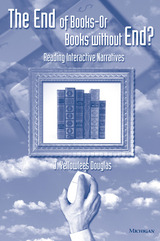 The End of Books--or Books Without End?: Reading Interactive Narratives
J. Yellowlees Douglas
University of Michigan Press, 2001 Of all developments surrounding hypermedia, none has been as hotly or frequently debated as the conjunction of fiction and digital technology. J. Yellowlees Douglas considers the implications of this union. She looks at the new light that interactive narratives may shed on theories of reading and interpretation and the possibilities for hypertext novels, World Wide Web-based short stories, and cinematic, interactive narratives on CD-ROM. She confronts questions that are at the center of the current debate: Does an interactive story demand too much from readers? Does the concept of readerly choice destroy the integrity of an author's vision? Does interactivity turn reading fiction from "play" into "work"--too much work? Will hypertext fiction overtake the novel as a form of art or entertainment? And what might future interactive books look like?
The book examines criticism on interactive fiction from both proponents and skeptics and examines similarities and differences between print and hypertext fiction. It looks closely at critically acclaimed interactive works, including Stuart Moulthrop's Victory Garden and Michael Joyce's Afternoon: A Story that illuminate how these hypertext narratives "work." While she sees this as a still-evolving technology and medium, the author identifies possible developments for the future of storytelling from outstanding examples of Web-based fiction and CD-ROM narratives, possibilities that will enable narratives to both portray the world with greater realism an to transcend the boundaries of novels and films, character and plot alike.
Written to be accessible to a wide range of readers, this lively and accessibly-written volume will appeal to those interested in technology and cyberculture, as well as to readers familiar with literary criticism and modern fiction.
J. Yellowlees Douglas is the Director of the William and Grace Dial Center for Written and Oral Communication, University of Florida. She is the author of numerous articles and essays on the subject of hypertext and interactive literature.
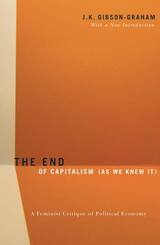 The End Of Capitalism (As We Knew It): A Feminist Critique of Political Economy
J. K. Gibson-Graham
University of Minnesota Press, 2006 In the mid-1990s, at the height of academic discussion about the inevitability of capitalist globalization, J. K. Gibson-Graham presented a groundbreaking and controversial argument for envisioning alternative economies. This new edition includes an introduction in which the authors address critical responses to The End of Capitalism and outline the economic research and activism they have been engaged in since the book was first published.
“Paralyzing problems are banished by this dazzlingly lucid, creative, and practical rethinking of class and economic transformation.” —Meaghan Morris, Lingnan University, Hong Kong
“Profoundly imaginative.” —Eve Kosofsky Sedgwick, City University of New York “Filled with insights, it is clearly written and well supported with good examples of actual, deconstructive practices.” —International Journal of Urban and Regional Research
J. K. Gibson-Graham is the pen name of Katherine Gibson and Julie Graham, feminist economic geographers who work, respectively, at the Australian National University in Canberra and the University of Massachusetts Amherst.
 The End of Catholic Mexico: Causes and Consequences of the Mexican Reforma (1855–1861)
David Gilbert
Vanderbilt University Press, 2024 In The End of Catholic Mexico, historian David Gilbert provides a new interpretation of one of the defining events of Mexican history: the Reforma. During this period, Mexico was transformed from a Catholic confessional state into a modern secular nation, sparking a three-year civil war in the process. While past accounts have portrayed the Reforma as a political contest, ending with a liberal triumph over conservative elites, Gilbert argues that it was a much broader culture war centered on religion. This dynamic, he contends, explains why the resulting conflict was more violent and the outcome more extreme than other similar contests during the nineteenth century.
Gilbert’s fresh account of this pivotal moment in Mexican history will be of interest to scholars of postindependence Mexico, Latin American religious history, nineteenth-century church history, and US historians of the antebellum republic.
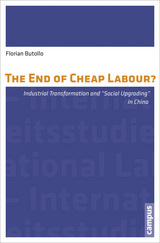 The End of Cheap Labour?: Industrial Transformation and "Social Upgrading" in China
Florian Butollo
Campus Verlag, 2014 The Chinese government and international observers argue that China’s economy must overcome its excessive dependence on exports if substantial growth in domestic consumption is to be achieved and sustained in the future. But this shift can only occur if China also lessens its reliance on cheap migrant labor and encourages investment in its own labor force.
In The End of Cheap Labour?, Florian Butollo investigates the recent transformation of the garment and LED lighting industries in the Pearl River Delta, China’s largest industrial hub. He reveals that industrial upgrading rarely supports improvements in working conditions and the basic employment pattern; and this failure of “social upgrading” threatens to undermine the desired rebalancing of the Chinese economy. Butollo demonstrates that the implementation of collective labor rights remains an important obstacle in the future of the Chinese growth model.
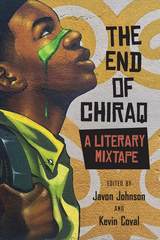 The End of Chiraq: A Literary Mixtape
Edited by Javon Johnson and Kevin Coval
Northwestern University Press, 2018 The End of Chiraq: A Literary Mixtape is a collection of poems, rap lyrics, short stories, essays, interviews, and artwork about Chicago, the city that came to be known as "Chiraq" ("Chicago" + "Iraq"), and the people who live in its vibrant and occasionally violent neighborhoods. Tuned to the work of Chicago’s youth, especially the emerging artists and activists surrounding Young Chicago Authors, this literary mixtape unpacks the meanings of “Chiraq” as both a vexed term and a space of possibility.
"Chiraq" has come to connote the violence—interpersonal and structural—that many Chicago youth regularly experience. But the contributors to The End of Chiraq show that Chicago is much more than Chiraq. Instead, they demonstrate how young people are thinking and mobilizing, engaged in a process of creating a new and safer world for themselves, their communities, and their city.
In true mixtape fashion, the book is an exercise in "low end theory" that does not just include so-called underground and marginal voices, but foregrounds them. Edited by award-winning poets, writers, and teachers Javon Johnson and Kevin Coval, The End of Chiraq addresses head-on the troublesome relationship between Chicago and Chiraq and envisions a future in which both might be transformed.
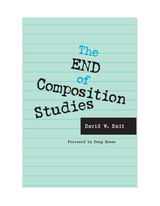 The End of Composition Studies
David W. Smit
Southern Illinois University Press, 2007 Setting forth an innovative new model for what it means to be a writing teacher in the era of writing across the curriculum, The End of Composition Studies urges a reconceptualization of graduate work in rhetoric and composition, systematically critiques the limitations of current pedagogical practices at the postsecondary level, and proposes a reorganization of all academic units.
David W. Smit calls into question two major assumptions of the field: that writing is a universal ability and that college-level writing is foundational to advanced learning. Instead, Smit holds, writing involves a wide range of knowledge and skill that cannot be learned solely in writing classes but must be acquired by immersion in various discourse communities in and out of academic settings.
The End of Composition Studies provides a compelling rhetoric and rationale for eliminating the field and reenvisioning the profession as truly interdisciplinary—a change that is necessary in order to fulfill the needs and demands of students, instructors, administrators, and our democratic society.
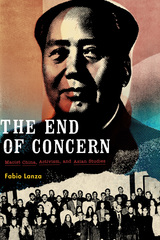 The End of Concern: Maoist China, Activism, and Asian Studies
Fabio Lanza
Duke University Press, 2017 In 1968 a cohort of politically engaged young academics established the Committee of Concerned Asian Scholars (CCAS). Critical of the field of Asian studies and its complicity with the United States' policies in Vietnam, the CCAS mounted a sweeping attack on the field's academic, political, and financial structures. While the CCAS included scholars of Japan, Korea, and South and Southeast Asia, the committee focused on Maoist China, as it offered the possibility of an alternative politics and the transformation of the meaning of labor and the production of knowledge. In The End of Concern Fabio Lanza traces the complete history of the CCAS, outlining how its members worked to merge their politics and activism with their scholarship. Lanza's story exceeds the intellectual history and legacy of the CCAS, however; he narrates a moment of transition in Cold War politics and how Maoist China influenced activists and intellectuals around the world, becoming a central element in the political upheaval of the long 1960s.
The End of Czechoslovakia
Jirí Musil
Central European University Press, 1995 Scholars and practitioners from both sides of the divide, Czech and Slovak, as well as international experts, take an in-depth look at the causes of Czechoslovakia's break-up, and explain why a seemingly successful country should disintegrate so quickly after the collapse of the communist regime. Besides exploring the political processes leading to the split, the authors analyse the underlying social, economic and cultural differences between the two nations and examine the historical roots of the problems. Particular attention is paid to changing Czech and Slovak attitudes towards the common state and towards each other, from the heyday of the First Republic to the disillusionment of the post-1989 period.
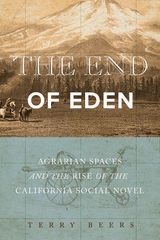 The End of Eden: Agrarian Spaces and the Rise of the California Social Novel
Terry Beers
University of Nevada Press, 2018 The story of the Joad family’s journey from their ravaged farm in dustbowl Oklahoma to the storied paradise of California helped inform a nation about the brutality, poverty, and vicious competition among fellow immigrants desperate for work. But Steinbeck is only one successor to a rich and esteemed literary tradition in California.
Drawing on history and cultural theory, The End of Eden traces the rise of the California social novel, its embrace of the agrarian dream, and its ambivalence about technology and the development it enables. It relies on various cultural conceptions of space, among them, the American Public Land Survey (the source of the “grid” allotments shaping homestead claims), Mexican-era diseños, and Native American traditions that defined a fluid relationship between human beings and the land.
This animation of four California social novels of the late eighteenth and early nineteenth centuries demonstrates how conflicts over space and place signify cultural conflict. It is deeply informed by the author’s understanding of historical land issues. The works include Joaquin Miller’s Unwritten History: Life Amongst the Modocs, Helen Hunt Jackson’s Ramona, Frank Norris’ The Octopus, and Mary Austin’s The Ford.
Miller’s Unwritten History: Life Amongst the Modocs and Jackson’s Ramona examine the tragic but inevitable consequences for native people of making space—inhabited already by Native American and Hispanic populations—safe for Americans who pursue the agrarian dream without regard to its effects upon those who claim prior tenure on the land. Norris’ The Octopus and Austin’s The Ford examine the murkier story of trying to preserve or to reclaim the agrarian dream when confronted by the unchecked materialist interests of American capitalism.
A wide-reaching interdisciplinary approach to various cultural conceptions of space, The End of Eden provides a crucial understanding of the conflicts depicted in social novels that lament the ways in which land is allocated and developed, the ways in which American agrarianism—and its promise of local, sustainable land use—is undermined, and how it applies to contemporary California. In an era where California confronts, yet again, the complicated patterns of land use: fracking, water use and water rights, coastal regulation and management, and agribusiness, this groundbreaking work provides an ever-relevant context.
The End of Empires: African Americans and India
Gerald Horne
Temple University Press, 2009 In the past fifty years, according to Christine So, the narratives of many popular Asian American books have been dominated by economic questions-what money can buy, how money is lost, how money is circulated, and what labor or objects are worth. Focusing on books that have achieved mainstream popularity, Economic Citizens unveils the logic of economic exchange that determined Asian Americans’ transnational migrations and national belonging. With penetrating insight, So examines literary works that have been successful in the U.S. marketplace but have been read previously by critics largely as narratives of alienation or assimilation, including Fifth Chinese Daughter, Flower Drum Song, Falling Leaves and Turning Japanese. In contrast to other studies that have focused on the marginalization of Asian Americans, Economic Citizens examines how Asian Americans have entered into the public sphere.
End of Equality
Beatrix Campbell
Seagull Books, 2013 Among liberal thinkers, there is an optimistic belief that men and women are on a cultural journey toward equality—in the workplace, on the street, and in the home. But observation and evidence both tell us that in many ways this progress has stopped and in some cases, even reversed.
In TheEnd of Equality, renowned feminist Beatrix Campbell argues that even as the patriarchy has lost some of its legitimacy, new inequalities are emerging in our culture. We are living, Campbell writes, in an era of neo-patriarchy in which violence has proliferated; body anxiety and self-hatred have flourished; rape is committed with impunity; sex trafficking thrives, and the struggle for equal pay is at an end. After four decades observing society, Campbell still speaks of the long-sought goal of gender equality. But now she calls for a new revolution.
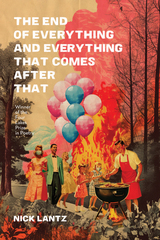 The End of Everything and Everything That Comes after That
Nick Lantz
University of Wisconsin Press, 2024 A chicken lives for eighteen months after its head is cut off. Tourists pose with an inflatable sex doll at the 9/11 memorial. A sex-reveal party starts a wildfire in a forest named for a conquistador. The author’s cancer treatments are intertwined with the rise of domestic fascism. “Is that something I should put in a poem?” asks Nick Lantz; the resounding answer is yes!
Mixing sincerity with irony, lyric with vernacular, Lantz’s collisions of style and subject are at their most vibrant in the long sequence at the center of the collection, a series of poems that brilliantly capture the disruption and disorder of our lives during the COVID-19 pandemic in breathless, unpunctuated verse. Depicting the uncanny dissonance of living during and beyond events that feel world ending, this volume reminds us of the ways in which we carry our own traumas and the traumas of history with us in our daily lives.
Life is all gilded frescoes
and Arnold Palmers
at the clubhouse until Titus and his men
pass through with torches,
until Cortés and his men
pass through with torches, until Sherman
and his men and so on,
until men forget
what their hands looked like without torches.
—Excerpt from “Ruin”
The End of Expressionism: Art and the November Revolution in Germany, 1918-1919
Joan Weinstein
University of Chicago Press, 1990 "Weinstein explores the attitudes and organizations of artists and architects in Berlin, Munich, and Dresden in response to the tumultuous events associated with the end of WWI and the (failed) Revolution. She traces the initial excitement and zeal and then the disillusionment as utopian dreams were dimmed by social, political, and military realities as well as by inherent contradiction within the arts movements itself. The accompanying b&w illustrations, fascinating in themselves, directly depict textual themes."—Booknews
 The End of Forgetting: Growing Up with Social Media
Kate Eichhorn
Harvard University Press, 2019 Thanks to Facebook and Instagram, our childhoods have been captured and preserved online, never to go away. But what happens when we can’t leave our most embarrassing moments behind?
Until recently, the awkward moments of growing up could be forgotten. But today we may be on the verge of losing the ability to leave our pasts behind. In The End of Forgetting, Kate Eichhorn explores what happens when images of our younger selves persist, often remaining just a click away.
For today’s teenagers, many of whom spend hours each day posting on social media platforms, efforts to move beyond moments they regret face new and seemingly insurmountable obstacles. Unlike a high school yearbook or a shoebox full of old photos, the information that accumulates on social media is here to stay. What was once fleeting is now documented and tagged, always ready to surface and interrupt our future lives. Moreover, new innovations such as automated facial recognition also mean that the reappearance of our past is increasingly out of our control.
Historically, growing up has been about moving on—achieving a safe distance from painful events that typically mark childhood and adolescence. But what happens when one remains tethered to the past? From the earliest days of the internet, critics have been concerned that it would endanger the innocence of childhood. The greater danger, Eichhorn warns, may ultimately be what happens when young adults find they are unable to distance themselves from their pasts. Rather than a childhood cut short by a premature loss of innocence, the real crisis of the digital age may be the specter of a childhood that can never be forgotten.
The End of Free Love
Susan Steinberg
University of Alabama Press, 2003 The End of Free Love evokes the schizophrenia of our times, a community of voices at the zero point. Like the voices that splinter from Marguerite Duras's work, these characters are neurotic, taking refuge in comics, food, music, sex, 'locking' and lies. Violence is everywhere: within, without, in every emotion, in every word. But often hidden emotions rise to the surface, where self-consciousness, shame, and rage, to name a few, are permitted, voiced, and, eventually, set free. Throughout The End of Free Love Steinberg creates a hybrid text, blending poetry and fiction in writing as much about its form as its content. This is fiction that offers itself up for our delight, while remaining as elusive and unpredictable as language itself.
 The End of Globalization: Lessons from the Great Depression
Harold James
Harvard University Press, 2002 "Globalization" is here. Signified by an increasingly close economic interconnection that has led to profound political and social change around the world, the process seems irreversible. In this book, however, Harold James provides a sobering historical perspective, exploring the circumstances in which the globally integrated world of an earlier era broke down under the pressure of unexpected events.
James examines one of the great historical nightmares of the twentieth century: the collapse of globalism in the Great Depression. Analyzing this collapse in terms of three main components of global economics--capital flows, trade, and international migration--James argues that it was not simply a consequence of the strains of World War I but resulted from the interplay of resentments against all these elements of mobility, as well as from the policies and institutions designed to assuage the threats of globalism. Could it happen again? There are significant parallels today: highly integrated systems are inherently vulnerable to collapse, and world financial markets are vulnerable and unstable. While James does not foresee another Great Depression, his book provides a cautionary tale in which institutions meant to save the world from the consequences of globalization--think WTO and IMF, in our own time--ended by destroying both prosperity and peace.
The End of Ideology: On the Exhaustion of Political Ideas in the Fifties, with "The Resumption of History in the New Century"
Daniel Bell
Harvard University Press, 2000 Named by the Times Literary Supplement as one of the 100 most influential books since the end of World War II, The End of Ideology has been a landmark in American social thought, regarded as a classic since its first publication in 1962.
Daniel Bell postulated that the older humanistic ideologies derived from the nineteenth and early twentieth centuries were exhausted, and that new parochial ideologies would arise. In a new introduction to the year 2000 edition, he argues that with the end of communism, we are seeing a resumption of history, a lifting of the heavy ideological blanket and the return of traditional ethnic and religious conflicts in the many regions of the former socialist states and elsewhere.
The End of Innocence?: Indonesian Islam and the Temptations of Radicalism
Andrée Feillard, Rémy Madinier
National University of Singapore Press, 2013 Long cited as a model of harmonious cohabitation between different religions, the most populous Muslim country in the world until recently occupied a special place in the Western imagination. Indonesia, home to a peaceful version of Islam, offered a reass
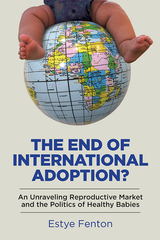 The End of International Adoption?: An Unraveling Reproductive Market and the Politics of Healthy Babies
Estye Fenton
Rutgers University Press, 2019 Since 2004, the number of international adoptions in the United States has declined by more than seventy percent. In The End of International Adoption? Estye Fenton studies parents in the United States who adopted internationally in the past decade during this shift. She investigates the experiences of a cohort of adoptive mothers who were forced to negotiate their desire to be parents in the context of a growing societal awareness of international adoption as a flawed reproductive marketplace. Many parents, activists, and scholars have questioned whether the inequality inherent in international adoption renders the entire system suspect. In the face of such concerns, international adoption has not only become more difficult, but also more politically and ethically fraught. The mothers interviewed for this book found themselves navigating contemporary American family life in an unexpected way, caught between the double-bind of work-family life and a new paradigm of thinking about the method—international adoption—that they used to create those families.
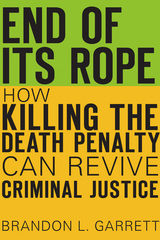 End of Its Rope: How Killing the Death Penalty Can Revive Criminal Justice
Brandon L. Garrett
Harvard University Press, 2017 It isn’t enough to celebrate the death penalty’s demise. We must learn from it.
When Henry McCollum was condemned to death in 1984 in rural North Carolina, death sentences were commonplace. In 2014, DNA tests set McCollum free. By then, death sentences were as rare as lethal lightning strikes. To most observers this national trend came as a surprise. What changed? Brandon Garrett hand-collected and analyzed national data, looking for causes and implications of this turnaround. End of Its Rope explains what he found, and why the story of who killed the death penalty, and how, can be the catalyst for criminal justice reform.
No single factor put the death penalty on the road to extinction, Garrett concludes. Death row exonerations fostered rising awareness of errors in death penalty cases, at the same time that a decline in murder rates eroded law-and-order arguments. Defense lawyers radically improved how they litigate death cases when given adequate resources. More troubling, many states replaced the death penalty with what amounts to a virtual death sentence—life without possibility of parole. Today, the death penalty hangs on in a few scattered counties where prosecutors cling to entrenched habits and patterns of racial bias.
The failed death penalty experiment teaches us how inept lawyering, overzealous prosecution, race discrimination, wrongful convictions, and excessive punishments undermine the pursuit of justice. Garrett makes a strong closing case for what a future criminal justice system might look like if these injustices were remedied.
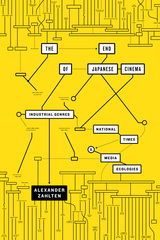 The End of Japanese Cinema: Industrial Genres, National Times, and Media Ecologies
Alexander Zahlten
Duke University Press, 2017 In The End of Japanese Cinema Alexander Zahlten moves film theory beyond the confines of film itself, attending to the emergence of new kinds of aesthetics, politics, temporalities, and understandings of film and media. He traces the evolution of a new media ecology through deep historical analyses of the Japanese film industry from the 1960s to the 2000s. Zahlten focuses on three popular industrial genres: Pink Film (independently distributed softcore pornographic films), Kadokawa (big-budget productions as part of a transmedia strategy), and V-Cinema (direct-to-video films). He examines the conditions of these films' production to demonstrate how the media industry itself becomes part of the politics of the media text and to highlight the complex negotiation between media and politics, culture, and identity in Japan. Zahlten points to a different history of film, one in which a once-powerful film industry transformed into becoming only one component within a complex media-mix ecology. In so doing, Zahlten opens new paths for uncovering similar broad processes in other large media societies.
A Study of the Weatherhead East Asian Institute, Columbia University
 The End of Jewish Modernity
Enzo Traverso
Pluto Press, 2016 Has Jewish modernity exhausted itself? Flourishing between the age of Enlightenment and the Second World War, the intellectual, literary, scientific and artistic legacy of Jewish modernity continues to dazzle us, however, in this provocative new book, esteemed historian Enzo Traverso argues powerfully that this cultural epoch has come to an end.
Previously a beacon for critical thinking in the Western world, the mainstream of Jewish thought has, since the end of the war, undergone a conservative turn. With great sensitivity and nuance, Traverso traces this development to the virtual destruction of European Jewry by the Nazis, and the establishment of the United States and Israel as the new poles of Jewish communal life. This is a compelling narrative, hinged upon a highly original discussion of Hannah Arendt's writings on Jewishness and politics.
With provocative chapters on the relationship between antisemitism and Islamophobia, the ascendance of Zionism, and the new 'civil religion of the Holocaust', The End of Jewish Modernity is both an elegy to a lost tradition and an intellectual history of the present.
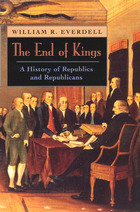 The End of Kings: A History of Republics and Republicans
William R. Everdell
University of Chicago Press, 2000 Written in clear, lively prose, The End of Kings traces the history of republican governments and the key figures that are united by the simple republican maxim: No man shall rule alone. Breathtaking in its scope, Everdell's book moves from the Hebrew Bible, Solon's Athens and Brutus's Rome to the impeachment trial of Andrew Johnson and the Watergate proceedings during which Nixon resigned. Along the way, he carefully builds a definition of "republic" which distinguishes democratic republics from aristocratic ones for both history and political science. In a new foreword, Everdell addresses the impeachment trial of President Clinton and argues that impeachment was never meant to punish private crimes. Ultimately, Everdell's brilliant analysis helps us understand how examining the past can shed light on the present.
"[An] energetic, aphoristic, wide-ranging book."—Marcus Cunliffe, Washington Post Book World
"Ambitious in conception and presented in a clear and sprightly prose. . . . [This] excellent study . . . is the best statement of the republican faith since Alphonse Aulard's essays almost a century ago." —Choice
"A book which ought to be in the hand of every American who agrees with Benjamin Franklin that the Founding Fathers gave us a Republic and hoped that we would be able to keep it."-Sam J. Ervin, Jr.
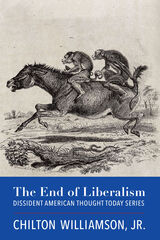 The End of Liberalism
Chilton Williamson
St. Augustine's Press, 2022 In the fourth title in the Dissident American Thought Today Series, Chilton Williamson takes on liberalism and reveals the 'faith' of the present Democratic Party as its own cultivated version of absurdity. This 'advanced liberalism' is not the liberalism of Mill, and it certainly no longer is the thinking man's party. If it were once true that conservatism is unimaginative and reactionary, the contrary is the picture of our times. Liberalism now asserts that human nature can and must be perfected, but without reference to nature. The age of the expert has been thrust upon the United States with the urgency of technique to be applied to coerce the vision of a perfect society and perfect human beings.
Williamson observes that this liberalism to nevertheless be collapsing, given the obvious opposition to the idea that it is essential to modernity. Liberalism is ironically a kind of unyielding control, "a relativist persuasion that discourages and resists fixed beliefs and certainties and the idea of truth itself." Williamson offers commentary on the present state of liberal ideas and their crimes against better judgment, and vindicates conservatism from being labeled reactionary. Liberalism is exposed as a faith we cannot accept, for it contains nothing to be believed and what it says about the order of things is pure fiction.
 The End of Man: A Feminist Counterapocalypse
Joanna Zylinska
University of Minnesota Press, 2018 Debugging the Anthropocene’s insistence on apocalyptic tropes
Where the Anthropocene has become linked to an apocalyptic narrative, and where this narrative carries a widespread escapist belief that salvation will come from a supernatural elsewhere, Joanna Zylinska has a different take. The End of Man rethinks the prophecy of the end of humans, interrogating the rise in populism around the world and offering an ethical vision of a “feminist counterapocalypse,” which challenges many of the masculinist and technicist solutions to our planetary crises. The book is accompanied by a short photo-film, Exit Man, which ultimately asks: If unbridled progress is no longer an option, what kinds of coexistences and collaborations do we create in its aftermath?
Forerunners: Ideas First is a thought-in-process series of breakthrough digital publications. Written between fresh ideas and finished books, Forerunners draws on scholarly work initiated in notable blogs, social media, conference plenaries, journal articles, and the synergy of academic exchange. This is gray literature publishing: where intense thinking, change, and speculation take place in scholarship.
The End of Middle East History and Other Conjectures
Richard W. Bulliet
Harvard University Press, 2020 The End of Middle East History and Other Conjectures is an unapologetic collection of imaginative essays from thought-provoking Middle East scholar Richard W. Bulliet. Not your ordinary think pieces, this volume collects for the first time Bulliet’s Big Bang–Big Crunch theory of Islamic history and his illuminating conception of the “Muslim South.” Speculations range from future political events to counterfactual histories of how reversal of the outcome of a 1529 battle might have profoundly altered history. After fifty years of posing and answering daring historical questions, Bulliet happily tackles an array of conjectures on subjects as diverse as the origin of civilization, the end of Middle East history, and future interpretations of the twentieth century.
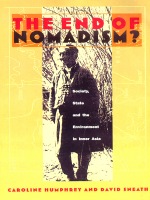 The End of Nomadism?: Society, State, and the Environment in Inner Asia
Caroline Humphrey and David Sneath
Duke University Press, 1999 Those who herd in the vast grassland region of Inner Asia face a precarious situation as they struggle to respond to the momentous political and economic changes of recent years. In The End of Nomadism? Caroline Humphrey and David Sneath confront the romantic, ahistorical myth of the wandering nomad by revealing the complex lives and the significant impact on Asian culture of these modern “mobile pastoralists.” In their examination of the present and future of pastoralism, the authors recount the extensive and quite sudden social, political, environmental, and economic changes of recent years that have forced these peoples to respond and evolve in order to maintain their centuries-old way of life. Using extensive and detailed case studies comparing pastoralism in Siberian Russia, Mongolia, and Northwest China, Humphrey and Sneath explore the different paths taken by nomads in these countries in reaction to a changing world. In examining how each culture is facing not only different prospects for sustainability but also different environmental problems, the authors come to the surprising conclusion that mobility can, in fact, be compatible with a modern and urbanized world. While placing emphasis on the social and cultural traditions of Inner Asia and their fate in the post-Socialist economies of the present, The End of Nomadism? investigates the changing nature of pastoralism by focusing on key areas under environmental threat and relating the ongoing problems to distinctive socioeconomic policies and practices in Russia and China. It also provides lively contemporary commentary on current economic dilemmas by revealing in telling detail, for instance, the struggle of one extended family to make a living. This book will interest Central Asian, Russian, and Chinese specialists, as well as those studying the environment, anthropology, sociology, peasant studies, and ecology.
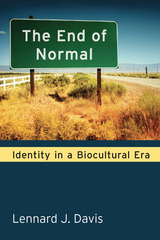 The End of Normal: Identity in a Biocultural Era
Lennard J. Davis
University of Michigan Press, 2014 In an era when human lives are increasingly measured and weighed in relation to the medical and scientific, notions of what is “normal” have changed drastically. While it is no longer useful to think of a person’s particular race, gender, sexual orientation, or choice as “normal,” the concept continues to haunt us in other ways. In The End of Normal, Lennard J. Davis explores changing perceptions of body and mind in social, cultural, and political life as the twenty-first century unfolds. The book’s provocative essays mine the worlds of advertising, film, literature, and the visual arts as they consider issues of disability, depression, physician-assisted suicide, medical diagnosis, transgender, and other identities. Using contemporary discussions of biopower and biopolitics, Davis focuses on social and cultural production—particularly on issues around the different body and mind. The End of Normal seeks an analysis that works comfortably in the intersection between science, medicine, technology, and culture, and will appeal to those interested in cultural studies, bodily practices, disability, science and medical studies, feminist materialism, psychiatry, and psychology.
 The End of Organized Capitalism
Scott Lash
University of Wisconsin Press, 1987
The End of Organized Capitalism argues that—despite Marx’s and Weber’s insistence that capitalist societies become increasingly more ordered—we now live in an era of “disorganized capitalism.” The book is devoted to a systematic examination of the shift to disorganized capitalism in five Western nations (Britain, the United States, France, West Germany, and Sweden). Through the analysis of space, class, and culture, Lash and Urry portray the restructuring of capitalist social relations that has resulted from this disorganization. They adduce evidence for the claims that in each of the nations there is a movement toward a deconcentration of capital within nation-states; toward the increased separation of banks, industry and the state; and toward the redistribution of productive relations and class-relevant residential patterns.
The authors also show that national disparities in contemporary, disorganized capitalism can be understood through close examination of the extent to which, and mode in which, capitalism became historically organized in each of the five countries under consideration.
The lucid arguments and judicious comparisons in this book will be of great interest to political scientists, sociologists, geographers, economists, and historians.
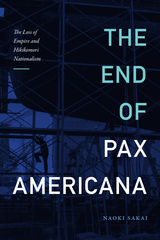 The End of Pax Americana: The Loss of Empire and Hikikomori Nationalism
Naoki Sakai
Duke University Press, 2022 In The End of Pax Americana, Naoki Sakai focuses on U.S. hegemony's long history in East Asia and the effects of its decline on contemporary conceptions of internationality. Engaging with themes of nationality in conjunction with internationality, the civilizational construction of differences between East and West, and empire and decolonization, Sakai focuses on the formation of a nationalism of hikikomori, or “reclusive withdrawal”—Japan’s increasingly inward-looking tendency since the late 1990s, named for the phenomenon of the nation’s young people sequestering themselves from public life. Sakai argues that the exhaustion of Pax Americana and the post--World War II international order—under which Taiwan, South Korea, Hong Kong, and China experienced rapid modernization through consumer capitalism and a media revolution—signals neither the “decline of the West” nor the rise of the East, but, rather a dislocation and decentering of European and North American political, economic, diplomatic, and intellectual influence. This decentering is symbolized by the sense of the loss of old colonial empires such as those of Japan, Britain, and the United States.
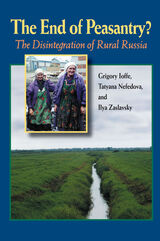 The End of Peasantry?: The Disintegration of Rural Russia
Grigory Ioffe
University of Pittsburgh Press, 2006
The End of Peasantry? examines the dramatic recent decline of agriculture in post-Soviet Russia. Historically, Russian farmers have encountered difficulties relating to the sheer abundance of land, the vast distances between population centers, and harsh environmental conditions. More recently, the drastic depopulation of rural spaces, decreases in sown acreage, and overall inefficiency of land usage have resulted in the disruption and spatial fragmentation of the countryside. For many decades, rural migration has been a selective process, resulting in the most enterprising and self-motivated people leaving the rural periphery. The new agricultural operators representing nascent but aggressive Russian agribusiness have difficulty co-opting traditional rural communities afflicted by profound social dysfunction. The contrast between agriculture in proximity to large cities and in their hinterlands is as sharp as ever, and some vacant niches are increasingly occupied by ethnically non-Russian migrants. All of these conditions existed to some degree in pre-Soviet times, but they have been exacerbated since Russia took steps toward a market economy.
Understudied and often underestimated in the West, the crisis facing Russian agriculture has profound implications for the political and economic stability of Russia. The authors see hope in the significant increase in land use intensity on vastly diminished farmland. The lessons gathered from this thoroughly researched study are far-reaching and relevant to the disciplines of Slavic and European studies, agriculture, political science, economics, and human geography.
The End of Philosophy
Martin Heidegger
University of Chicago Press, 2003 Joan Stambaugh's translations of the works of Heidegger, accomplished with his guidance, have made key aspects of his thought and philosophy accessible to readers of English for many years. This collection, writes Stambaugh, contains Heidegger's attempt "to show the history of Being as metaphysics," combining three chapters from the philosopher's Nietzsche ("Metaphysics as a History of Being," "Sketches for a History of Being as Metaphysics," and "Recollection in Metaphysics") with a selection from Vorträge und Aufsätze ("Overcoming Metaphysics").
The End of Prussia
Gordon A. Craig
University of Wisconsin Press, 1984 One of the livelier debates amongst historians concerns the dates of the beginning and, particularly, the end of Prussian history. Eminent historian Gordon A. Craig explores the slow death of Prussia by examining several key individuals and their actions at four distinct periods of Prussian history.
"Simply said, the book is a beautiful piece. Insightful and lucid. . . . The End of Prussia has the rare quality of being suitable for both the specialist and the more casual student of German history."—Wisconsin Academy Review
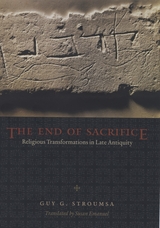 The End of Sacrifice: Religious Transformations in Late Antiquity
Guy G. Stroumsa
University of Chicago Press, 2009
The religious transformations that marked late antiquity represent an enigma that has challenged some of the West’s greatest thinkers. But, according to Guy Stroumsa, the oppositions between paganism and Christianity that characterize prevailing theories have endured for too long. Instead of describing this epochal change as an evolution within the Greco-Roman world from polytheism to monotheism, he argues that the cause for this shift can be found not so much around the Mediterranean as in the Near East.
The End of Sacrifice points to the role of Judaism, particularly its inventions of new religious life following the destruction of the Second Temple in 70 CE. The end of animal sacrifice gave rise to new forms of worship, with a concern for personal salvation, scriptural study, rituals like praying and fasting, and the rise of religious communities and monasticism. It is what Christianity learned from Judaism about texts, death, and, above all, sacrifice that allowed it to supersede Greco-Roman religions and, Stroumsa argues, transform religion itself.
A concise and original approach to a much-studied moment in religious history, The End of Sacrifice will be heralded by all scholars of late antiquity.
 The End of Sex and the Future of Human Reproduction
Henry T. Greely
Harvard University Press, 2016 “Will the future confront us with human GMOs? Greely provocatively declares yes, and, while clearly explaining the science, spells out the ethical, political, and practical ramifications.”—Paul Berg, Nobel Laureate and recipient of the National Medal of Science
Within twenty, maybe forty, years most people in developed countries will stop having sex for the purpose of reproduction. Instead, prospective parents will be told as much as they wish to know about the genetic makeup of dozens of embryos, and they will pick one or two for implantation, gestation, and birth. And it will be safe, lawful, and free. In this work of prophetic scholarship, Henry T. Greely explains the revolutionary biological technologies that make this future a seeming inevitability and sets out the deep ethical and legal challenges humanity faces as a result.
“Readers looking for a more in-depth analysis of human genome modifications and reproductive technologies and their legal and ethical implications should strongly consider picking up Greely’s The End of Sex and the Future of Human Reproduction… [It has] the potential to empower readers to make informed decisions about the implementation of advancements in genetics technologies.”
—Dov Greenbaum, Science
“[Greely] provides an extraordinarily sophisticated analysis of the practical, political, legal, and ethical implications of the new world of human reproduction. His book is a model of highly informed, rigorous, thought-provoking speculation about an immensely important topic.”
—Glenn C. Altschuler, Psychology Today
The End of Silence: Accounts of the 1965 Genocide in Indonesia
Soe Tjen Marching
Amsterdam University Press, 2017 In the late 1960s, between one and two million people were killed by Indonesian president Suharto's army in the name of suppressing communism-and more than fifty years later, the issue of stigmatisation is still relevant for many victims of the violence and their families. The End of Silence presents the stories of these individuals, revealing how many survivors from the period have been so strongly affected by the strategy used by Suharto and his Western allies that these survivors, still afraid to speak out, essentially serve to maintain the very ideology that led to their persecution.
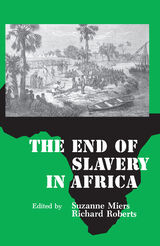 The End of Slavery in Africa
Suzanne Miers and Richard Roberts
University of Wisconsin Press, 1988 This is the first comprehensive assessment of the end of slavery in Africa. Editors Suzanne Miers and Richard Roberts, with the distinguished contributors to the volume, establish an agenda for the social history of the early colonial period—hen the end of slavery was one of the most significant historical and cultural processes. The End of Slavery in Africa is a sequel to Slavery in Africa, edited by Suzanne Miers and Igor Kopytoff and published by the University of Wisconsin Press in 1977. The contributors explore the historical experiences of slaves, masters, and colonials as they all confronted the end of slavery in fifteen sub-Saharan African societies. The essays demonstrate that it is impossible to generalize about whether the end of slavery was a relatively mild and nondisruptive process or whether it marked a significant change in the social and economic organization of a given society. There was no common pattern and no uniform consequence of the end of slavery. The results of this wide-ranging inquiry will be of lasting value to Africanists and a variety of social and economic historians.
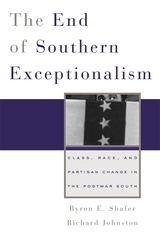 The End of Southern Exceptionalism: Class, Race, and Partisan Change in the Postwar South
Byron E. Shafer and Richard Johnston
Harvard University Press, 2009 The transformation of Southern politics after World War II changed the political life not just of this distinctive region, but of the entire nation. Until now, the critical shift in Southern political allegiance from Democratic to Republican has been explained, by scholars and journalists, as a white backlash to the civil rights revolution.
In this myth-shattering book, Byron Shafer and Richard Johnston refute that view, one stretching all the way back to V. O. Key in his classic book Southern Politics. The true story is instead one of dramatic class reversal, beginning in the 1950s and pulling everything else in its wake. Where once the poor voted Republican and the rich Democrat, that pattern reversed, as economic development became the engine of Republican gains. Racial desegregation, never far from the heart of the story, often applied the brakes to these gains rather than fueling them.
A book that is bound to shake up the study of Southern politics, this will also become required reading for pundits and political strategists, for all those who argue over what it takes to carry the South.
 The End of Strategic Stability?: Nuclear Weapons and the Challenge of Regional Rivalries
Lawrence Rubin and Adam N. Stulberg, Editors
Georgetown University Press, 2018 During the Cold War, many believed that the superpowers shared a conception of strategic stability, a coexistence where both sides would compete for global influence but would be deterred from using nuclear weapons. In actuality, both sides understood strategic stability and deterrence quite differently. Today’s international system is further complicated by more nuclear powers, regional rivalries, and nonstate actors who punch above their weight, but the United States and other nuclear powers still cling to old conceptions of strategic stability. The purpose of this book is to unpack and examine how different states in different regions view strategic stability, the use or non-use of nuclear weapons, and whether or not strategic stability is still a prevailing concept. The contributors to this volume explore policies of current and potential nuclear powers including the United States, Russia, China, India, Iran, Israel, Pakistan, and Saudi Arabia. This volume makes an important contribution toward understanding how nuclear weapons will impact the international system in the twenty-first century and will be useful to students, scholars, and practitioners of nuclear weapons policy.
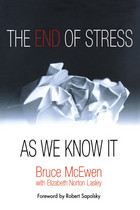 The End of Stress As We Know It
Bruce S. McEwen, Ph.D.
Dana Press, 2002 The End of Stress as We Know It provides readers with the "gold standard" in understanding how their bodies work under stress and why they have the power to avoid its debilitating effects. Bruce McEwen, Ph.D., one of the world's authorities on the subject of stress, here provides unshakable evidence of how mind and body work together either for good or for ill when we are challenged by life's events.
Describing the subtle damage that comes from failing to turn off the body's danger alert system, Dr. McEwen shows how chemicals activated during stressful situations can protect the body under acute conditions, and how, when chronically activated, they can cause long-lasting harm. He counsels that many stress management programs can help us, if we understand the powerful mind-body forces activated by stress.
The premise of this book is that knowledge is power. By learning how the body reacts to large and small challenges in our lives, by understanding how we put ourselves in situations that cause upheaval in our minds and bodies, we can make the best choices--backed up by the latest scientific knowledge.
The End of the Clockwork Universe
Fleda Brown
Carnegie Mellon University Press, 2025 A luminous new perspective on aging, science, and the tender strangeness of being alive.
What does it mean to exist in a universe that refuses to stay still? In The End of the Clockwork Universe, Fleda Brown weaves together the vastness of cosmic discovery with the intimate textures of daily life. Ranging from quarks to catalytic converters, snapping turtles to black holes, these poems trace the mysteries of time and perception, offering a voice both unsentimental and deeply compassionate.
With wry humor and unending curiosity, Brown walks the fine line between knowing and not knowing, between order and entropy. Her poems wander through scientific revelation and personal reflection and capture the quiet astonishment of existence. The End of the Clockwork Universe does not seek to solve life’s uncertainties, but sings to them, leaving behind echoes of resilience and the sheer joy of paying attention.
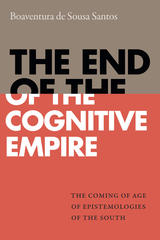 The End of the Cognitive Empire: The Coming of Age of Epistemologies of the South
Boaventura de Sousa Santos
Duke University Press, 2018 In The End of the Cognitive Empire Boaventura de Sousa Santos further develops his concept of the "epistemologies of the South," in which he outlines a theoretical, methodological, and pedagogical framework for challenging the dominance of Eurocentric thought. As a collection of knowledges born of and anchored in the experiences of marginalized peoples who actively resist capitalism, colonialism, and patriarchy, epistemologies of the South represent those forms of knowledge that are generally discredited, erased, and ignored by dominant cultures of the global North. Noting the declining efficacy of established social and political solutions to combat inequality and discrimination, Santos suggests that global justice can only come about through an epistemological shift that guarantees cognitive justice. Such a shift would create new, alternative strategies for political mobilization and activism and give oppressed social groups the means through which to represent the world as their own and in their own terms.
The End of the Cold War: European Unity, Socialism, and the Shift in Global Power
Bogdan Denitch
University of Minnesota Press, 1990
The End of the Cold War was first published in 1990. Minnesota Archive Editions uses digital technology to make long-unavailable books once again accessible, and are published unaltered from the original University of Minnesota Press editions.
Against the backdrop of unprecedented change in the world political and social order, Bogdan Denitch charts the unique opportunities and potential pitfalls that accompany the increased economic and political integration of the European Community. Historically, any move toward unification has had broad ramifications. This, coming as it does in the wake of recent democratic upheavals in Europe, will bring to a close an entire era -- an era of a world dominated by superpowers and the cold war that defined there confrontations.
 The End of the Future: Trauma, Memory, and Reconciliation in Peruvian Amazonia
Bartholomew Dean
Vanderbilt University Press, 2023 In The End of the Future, author Bartholomew Dean broadens the theoretical framework for understanding memory's role in reconciliation following a violent conflict. This book explores the complicated and confusing linkages between memory and trauma for individuals caught up in civil war and post-conflict reconciliation in the Peruvian Amazon's Huallaga Valley—an epicenter for leftist rebels and a booming shadow economy based on the extraction and circulation of cocaine. The End of the Future tells the story of violent attempts by the Túpac Amaru Revolutionary Movement (Movimiento Revolucionario Túpac Amaru, MRTA) to overthrow the state in the late 1980s and early 1990s from the perspective of the poorest residents of the lower Huallaga's Caynarachi Basin.
To give context to the causes and consequences of the MRTA's presence in the lower and central Huallaga, this book relies on the written works and testimony of Sístero García Torres, an MRTA rebel commander; the government's Truth and Reconciliation Commission; MRTA propaganda; media accounts; and critical historical texts. Besides exposing Huallaga Valley human rights abuses, the book's contribution to political anthropology is consequential for its insistence that reconciliation is by no means equivalent to local, Indigenous notions of "justice" or customary forms of dispute resolution. Without deliberately addressing the diverse socio-cultural contours defining overlapping epistemologies of justice, freedom, and communal well-being, enduring reconciliation will likely remain elusive.
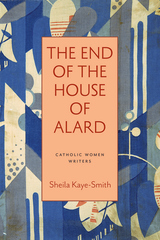 The End of the House of Alard
Sheila Kaye-Smith
Catholic University of America Press, 2022 The Catholic University of America Press is pleased to present the second volume in our Catholic Women Writers series, which will attempt to bring new attention to prose work of Catholic women writers from the 19th and 20th centuries. Sheila Kaye-Smith was a best selling author who had published over 50 books in her lifetime, few of which remain in print since her death in 1956.
The End of the House of Alard (1922) documents the choices made by the final generation of the aristocratic Alard family and the ways in which they, both willingly and reluctantly, bring the long line of their ancestral blood to a complete and sudden end. For some of them, the end of the Alard line is as painful to enact as it is for others to witness; for others it is welcomed as a necessary modernization or a true realignment toward religious integity and universal human truth. Some of the family's children yearn for individual liberty; others have it forced upon them. But none of them can find it under the burden of the Alard name and its crumbling estate. The End of the House of Alard is a novel about the human need for purpose, for a truth by which to live and for which to die. It is a novel about faith and idolatry, love and death, freedom and bondage, nature and grace. Put another way, it is about how human beings cannot escape the great challenge of salvation, of breaking free from false, man made gods in order to unite instead with the divine love of Christ. The novel's characters span a breadth of options on this spectrum and their various outlooks on life continue to reflect those available to us today.
End of the Line: Autoworkers and the American Dream
Edited by Richard Feldman and Michael Betzold
University of Illinois Press, 1988 "This marvelous book captures in a most poignant and accurate way what life is like for the millions who still make up the 'blue collar' backbone of American industry."--Barry Bluestone, author of The Deindustrialization of America
"A richly detailed, well-crafted portrait of a cross section of autoworkers in the midst of an identity crisis and a crisis gripping the U.S. auto industry."--Frank Hammer, President, United Auto Workers Local 909
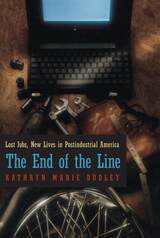 The End of the Line: Lost Jobs, New Lives in Postindustrial America
Kathryn Marie Dudley
University of Chicago Press, 1994 The End of the Line tells the story of the 1988 closing of the Chrysler assembly plant in Kenosha, Wisconsin. Kathryn Marie Dudley uses interviews with residents to chart the often confusing process of change that deindustrialization forced on every corner of the community. This honest, moving portrait of one town's radical shift from a manufacturing to a postindustrial economy will redefine the way Americans think about our families, communities, and future.
"An excellent study not only of the cultural disruptions caused by the shutdown of Chrysler's operations in Kenosha, Wisconsin, but also of the ideology of progress that abetted the shutdown."—Stephen Amberg, Industrial and Labor Relations Review
"With the eye of an anthropologist, [Dudley] examines the tensions between the 'culture of hands' and the 'culture of mind.' Her account is especially instructive because, by many measures, Kenosha has successfully recovered, yet for many the pain still remains."—Booklist
"Exceptional. . . . Should be widely read."—Douglas Harper, Contemporary Sociology
"Make[s] clear what a tenuous concept economic security is, especially when the rules for achieving security are in flux."—Barbara Presley Noble, New York Times
End Of The Modern World
Romano Guardini
Intercollegiate Studies Institute, 2001
An extended inquiry into the nature of the modern age, as well as a historical, philosophical, and theological analysis of modernity's prospects in the next millennium. This expanded edition includes the original text of The End of the Modern World, as well as the entirety of its explicit sequel, Power and Responsibility. Guardini analyzes modern man's conception of himself in the world, and examines the nature and use of power. It is the principle of individual responsibility that weaves both works into a seamless, comprehensive, and compelling moral statement. Guardini tirelessly argues that human beings are responsible moral agents, possessed of free will and answerable to God and their fellow man.
 The End of the Past: Ancient Rome and the Modern West
Aldo Schiavone
Harvard University Press, 2000 This searching interpretation of past and present addresses fundamental questions about the fall of the Roman Empire. Why did ancient culture, once so strong and rich, come to an end? Was it destroyed by weaknesses inherent in its nature? Or were mistakes made that could have been avoided—was there a point at which Greco-Roman society took a wrong turn? And in what ways is modern society different?Western history is split into two discontinuous eras, Aldo Schiavone tells us: the ancient world was fundamentally different from the modern one. He locates the essential difference in a series of economic factors: a slave-based economy, relative lack of mechanization and technology, the dominance of agriculture over urban industry. Also crucial are aspects of the ancient mentality: disdain for manual work, a preference for transcending (rather than transforming) nature, a basic belief in the permanence of limits.Schiavone’s lively and provocative examination of the ancient world, “the eternal theater of history and power,” offers a stimulating opportunity to view modern society in light of the experience of antiquity.
The End Of The Peasantry: The Rural Labor Movement in Northeast Brazil, 1961–1988
Anthony W. Pereira
University of Pittsburgh Press, 1997
The rural labor movement played a surprisingly active role in Brazil’s transition to democracy in the 1980s. While in most Latin American countries rural labor was conspicuously marginal, in Brazil, an expanded, secularized, and centralized movement organized strikes, staged demonstrations for land reform, demanded political liberalization, and criticized the government’s environmental policies.
In this ground-breaking book, Anthony W. Pereira explains this transition as the result of two intertwined processes - the modernization of agricultural production and the expansion of the welfare state into the countryside - and explores the political consequences of these processes, occurring not only in Latin America but in much of the Third World.
 The End of the Schism: Catholics, Protestants, and the Remaking of Christian Life in Europe, 1880s–1970s
Udi Greenberg
Harvard University Press, 2025 The dramatic story behind an extraordinary transformation: the reconciliation between Europe’s Protestants and Catholics, and the emergence of a new era of Christian collaboration.
For centuries, Europe’s Catholics and Protestants were bitter rivals, each group blaming the other for violence and alleged moral decline. Yet starting in the 1930s, they swiftly made peace, abandoning old stereotypes and even forming joint political parties and social organizations. Why did these erstwhile adversaries suddenly start cooperating, and what were the consequences?
A groundbreaking study, The End of the Schism overturns conventional wisdom about this revolutionary change. Udi Greenberg shows that ecumenism did not grow out of mutual tolerance. Rather, Christian thinkers and politicians on both sides of the Catholic-Protestant divide came together to contain what they considered growing threats to Christian life: socialism, feminism, and Afro-Asian liberation movements. This project of interconfessional peacemaking accelerated with the rise of the Nazis, whose call for religious unity sparked intense debates among Christian denominations about their relationships with one another. Their rapprochement culminated in the unfolding of the Cold War and decolonization, when Catholic and Protestant authorities formally declared each other “brethren in faith.”
The End of the Schism makes clear the enormous consequences of the ecumenical revolution. By working together, Catholics and Protestants were able to design Europe’s economic policies, regulate its sexual practices, and deeply shape its postwar relationship with the Global South. As confessional attachments in Europe have weakened, this coalition of Christians has only grown more cohesive, leveraging their alliance to maintain influence across a politically fractured continent.
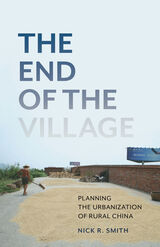 The End of the Village: Planning the Urbanization of Rural China
Nick R. Smith
University of Minnesota Press, 2021 How China’s expansive new era of urbanization threatens to undermine the foundations of rural life Since the beginning of the twenty-first century, China has vastly expanded its urbanization processes in an effort to reduce the inequalities between urban and rural areas. Centered on the mountainous region of Chongqing, which serves as an experimental site for the country’s new urban development policies, The End of the Village analyzes the radical expansion of urbanization and its consequences for China’s villagers. It reveals a fundamental rewriting of the nation’s social contract, as villages that once organized rural life and guaranteed rural livelihoods are replaced by an increasingly urbanized landscape dominated by state institutions. Throughout this comprehensive study of China’s “urban–rural coordination” policy, Nick R. Smith traces the diminishing autonomy of the country’s rural populations and their subordination to larger urban networks and shared administrative structures. Outside Chongqing’s urban centers, competing forces are at work in reshaping the social, political, and spatial organization of its villages. While municipal planners and policy makers seek to extend state power structures beyond the boundaries of the city, village leaders and inhabitants try to maintain control over their communities’ uncertain futures through strategies such as collectivization, shareholding, real estate development, and migration. As China seeks to rectify the development crises of previous decades through rapid urban growth, such drastic transformations threaten to displace existing ways of life for more than 600 million residents. Offering an unprecedented look at the country’s contentious shift in urban planning and policy, The End of the Village exposes the precarious future of rural life in China and suggests a critical reappraisal of how we think about urbanization.
The End of the World
Eric S Rabkin
Southern Illinois University Press, 1983
The essays selected by the editors to explore these apocalyptic visions are: “The Remaking of Zero: Beginning at the End,” by Gary K. Wolfe; “The Lone Survivor,” by Robert Plank; “Ambiguous Apocalypse: Transcendental Versions of the End,” by Robert Galbreath; “World’s End: The Imagination of Catastrophe,” by W. Warren Wagar; “Man-Made Catastrophes,” by Brian Stableford; and “The Rebellion of Nature,” by W. Warren Wagar.
Wolfe sees in these postholocaust narratives a central attraction—“the mythic power inherent in the very conception of a remade world.” This power derives from three sources: the emergence of a new order from the ashes of the old system, and thus a kind of denial of death; the reinforcement of one set of values as opposed to another; and as something always replaces whatever was destroyed, a promise that nothing can annihilate humanity.
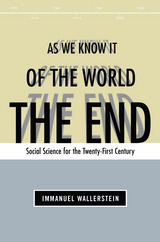 End of the World as We Know It: Social Science for the Twenty-First Century
Immanuel Wallerstein
University of Minnesota Press, 2001 A respected thinker points the way ahead.
"Immanuel Wallerstein has long conceived of social science grandly. He was an innovator of world systems analysis, which portrays societies, sectors within societies, and the very disciplines of the social science as linked, bound, and analytically inseparable: To parse them is to misconceive them. As recent president of the International Sociological Association (1994 to 1998), Wallerstein continued to develop such grand thinking through numerous addresses on the state of the social sciences, capitalism, political justice, and the world. Here, he offers these collectively. He divides them into two topics-the world of capitalism and the world of knowledge. Toward both grand worlds, his thesis is similar: they are in crisis. . . . The scope of his career's thought is remarkable, his expertise impressively broad." Political Science Quarterly
This book is nothing short of a state-of-the-world address, delivered by a scholar uniquely suited to the task. Immanuel Wallerstein, one of the most prominent social scientists of our time, documents the profound transformations our world is undergoing. With these transformations, he argues, come equally profound changes in how we understand the world.
Wallerstein divides his work between an appraisal of significant recent events and a study of the shifts in thought influenced by those events. The book's first half reviews the major happenings of recent decades--the collapse of the Leninist states, the exhaustion of national liberation movements, the rise of East Asia, the challenges to national sovereignty, the dangers to the environment, the debates about national identity, and the marginalization of migrant populations. Wallerstein places these events and trends in the context of the changing modern world-system as a whole and identifies the historical choices they put before us.
The second half of the book takes up current issues in the world of knowledge--the vanishing faith in rationality, the scattering of knowledge activities, the denunciation of Eurocentrism, the questioning of the division of knowledge into science and humanities, and the relation of the search for the true and the search for the good. Wallerstein explores how these questions have arisen from larger social transformations, and why the traditional ways of framing such debates have become obstacles to resolving them. The End of the World As We Know It concludes with a crucial analysis of the momentous intellectual challenges to social science as we know it and suggests possible responses to them.
Immanuel Wallerstein is Distinguished Professor of Sociology and director of the Fernand Braudel Center at Binghamton University. Among his numerous books are The Modern World-System (1974, 1980, 1989), Unthinking Social Science (1991), and After Liberalism (1995).
The End of the World Book: A Novel
Alistair McCartney
University of Wisconsin Press, 2008 This is no ordinary novel. An encyclopedia of memory—from A to Z—The End of the World Book deftly intertwines fiction, memoir, and cultural history, reimagining the story of the world and one man’s life as they both hurtle toward a frightening future. Alistair McCartney’s alphabetical guide to the apocalypse layers images like a prose poem, building from Aristotle to da Vinci, hip-hop to lederhosen, plagues to zippers, while barreling from antiquity to the present.
In this profound book about mortality, McCartney composes an irreverent archive of philosophical obsessions and homoerotic fixations, demonstrating the difficulty of separating what is real from what is imagined.
Finalist, Edmund White Award for Debut Fiction, The Publishing Triangle Finalist, PEN USA Literary Award for Fiction
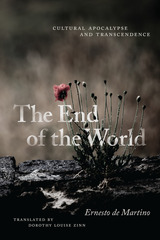 The End of the World: Cultural Apocalypse and Transcendence
Ernesto de Martino
University of Chicago Press, 2023 The first English translation of a classic work of twentieth-century anthropology and philosophy.
A philosopher, historian of religions, and anthropologist, Ernesto de Martino (1908–1965) produced a body of work that prefigured many ideas and concerns that would later come to animate anthropology. In his writing, we can see the roots of ethnopsychiatry and medical anthropology, discussions of reflexivity and the role of the ethnographer, considerations of social inequality and hegemony from a Gramscian perspective, and an anticipation of the discipline’s “existential turn.” We also find an attentiveness to hope and possibility, despite the gloomy title of his posthumously published book La fine del mondo, or The End of the World. Examining apocalypse as an individual as well as a cultural phenomenon, treating subjects both classic and contemporary and both European and non-Western, ranging across ethnography, history, literature, psychiatry, and philosophy, de Martino probes how we relate to our world and how we might be better subjects and thinkers within it. This new translation offers English-language readers their first chance to engage with de Martino’s masterwork, which continues to appear prescient in the face of the frictions of globalization and environmental devastation.
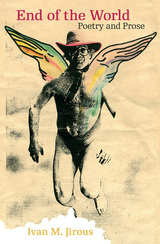 End of the World: Poetry and Prose
Ivan M. Jirous
Karolinum Press, 2020 Sometimes called the Czech Bukowski, and more widely known by the epithet “Magor” (which translates roughly to “fool” or “madman”), Ivan Jirous was one of the most significant figures in the Czechoslovak cultural underground of the 1960s through the '80s. Although trained as an art historian and famed for his poetry, Jirous was convinced that it was actually rock and roll music that held the greatest potential to enact change under the repressive regime of communist Czechoslovakia. He designated himself as the artistic director of the dissident rock band The Plastic People of the Universe, legendary for psychedelic music that was heavily influenced by nonconformist Western acts like Frank Zappa and The Velvet Underground. Alongside other figures from the musical underground, Jirous was arrested in 1976—the second of five prison sentences he would serve for his dissent—which helped bring about the landmark civil rights initiative known as Charter 77. In the wake of 1989’s Velvet Revolution, Váсlav Havel—the first president of the Czech Republic—was to say that Jirous and his unwavering commitment to liberation played “no small part” in casting off the yoke of Soviet oppression.
End of the World is the first major collection in English of the works of this legendary Czech “madman.” Although nicknamed for his aggressive and rebellious behavior, Jirous’s writing reveal a refined, sophisticated, and even tender sensibility. Translated in part by Paul Wilson, an original member of the Plastic People, the book gathers his poems and letters from prison, as well as his book-length prose work, The True Story of the Plastic People, alongside critical essays on Jirous’s life and work. End of the World is an ideal introduction to the raucous writer who playwright Tom Stoppard referred to as one of the most interesting personalities in modern Czech history.
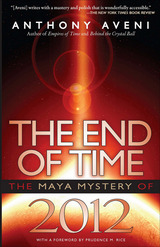 End of Time: The Maya Mystery of 2012
Anthony Aveni
University Press of Colorado, 2009 December 21, 2012. The Internet, bookshelves, and movie theaters are full of prophecies, theories, and predictions that this date marks the end of the world, or at least the end of the world as we know it. Whether the end will result from the magnentic realignment of the north and south poles, bringing floods, earthquakes, death, and destruction; or from the return of alien caretakers to enlighten or enslave us; or from a global awakening, a sudden evolution of Homo sapiens into non-corporeal beings—theories of great, impending changes abound. In The End of Time, award-winning astronomer and Maya researcher Anthony Aveni explores these theories, explains their origins, and measures them objectively against evidence unearthed by Maya archaeologists, iconographers, and epigraphers. He probes the latest information astronomers and earth scientists have gathered on the likelihood of Armageddon and the oft-proposed link between the Maya Long Count cycle and the precession of the equinoxes. He then expands on these prophecies to include the broader context of how other cultures, ancient and modern, thought about the “end of things” and speculates on why cataclysmic events in human history have such a strong appeal within American pop culture.
 The End of Tolerance: Racism in 21st Century Britain
Arun Kundnani
Pluto Press, 2007 Is Britain becoming a more racist society? Arun Kundnani looks behind the media hysteria to show how multicultural Britain is under attack by government policies and vitriolic press campaigns that play upon fear and encourage racism.
Exacerbated by the attacks of 9/11 and 7/7, Kundnani argues that a new form of racism is emerging that is based on a systematic failure to understand the causes of forced migration, global terrorism and social segregation. The result is a climate of hatred, especially against Muslims and asylum seekers, and the erosion of the human rights of those whose cultures and values are perceived as 'alien'.
Communities are more divided than ever. Yet the government presses ahead with flawed immigration and 'integration' policies and anti-terrorist legislation that creates further resentment, alienation and criminalisation. Behind it all lies a refusal to grasp the ways in which the world has been changed by neoliberal globalisation.
What can be done? This timely and precise analysis is a useful account of why racism is now thriving -- and what can be done to stop it. It will be of interest to anyone who is appalled by the current state of race relations in Britain and it should be required reading for all policy-makers.
The End of Victory Culture: Cold War America and the Disillusioning of a Generation
Thomas M. Engelhardt
University of Massachusetts Press, 2007 In a substantial new afterword to his classic account of the collapse of American triumphalism in the wake of World War II, Tom Engelhardt carries that story into the twenty-first century. He explores how, in the aftermath of September 11, 2001, the younger George Bush headed for the Wild West (Osama bin Laden, "Wanted, Dead or Alive"); how his administration brought "victory culture" roaring back as part of its Global War on Terror and its rush to invade Saddam Husseins's Iraq; and how, from its "Mission Accomplished" moment on, its various stories of triumph crashed and burned in that land.
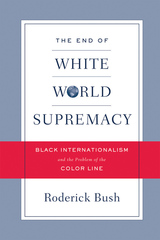 The End of White World Supremacy: Black Internationalism and the Problem of the Color Line
Roderick Bush
Temple University Press, 2009 The End of White World Supremacy explores a complex issue— integration of Blacks into White America—from multiple perspectives: within the United States, globally, and in the context of movements for social justice. Roderick Bush locates himself within a tradition of African American activism that goes back at least to W.E.B. Du Bois. In so doing, he communicates between two literatures—worldsystems analysis and radical Black social movement history—and sustains the dialogue throughout the book. Bush explains how racial troubles in the U.S. are symptomatic of the troubled relationship between the white and dark worlds globally. Beginning with an account of white European dominance leading to capitalist dominance by White America, The End of White World Supremacy ultimately wonders whether, as Myrdal argued in the 1940s, the American creed can provide a pathway to break this historical conundrum and give birth to international social justice.
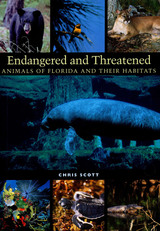 Endangered and Threatened Animals of Florida and Their Habitats
By Chris Scott
University of Texas Press, 2004 A biological crossroads where temperate gives way to tropical and east blends into west, Florida has over twenty-five primary habitat types, several of which are unique to the state. Within these richly varied natural communities lives an astonishing abundance of animals and plants, making Florida one of the United States' most biologically diverse regions. At the same time, sadly, Florida is also one of the country's most ecologically imperiled regions, second only to California in the number of its animals and plants that have been federally designated as endangered or threatened. This fully illustrated book is a comprehensive, yet convenient and easy-to-understand guide to Florida's endangered and threatened animals and the habitats that support them. Chris Scott covers all 71 species, subspecies, or populations of mammals, birds, reptiles, fish, crustaceans, insects, corals, and mollusks. His species accounts describe each animal's listed status, identifying characteristics, historical and current distribution, biology, current threats, and conservation efforts. To make the crucial link between animals and their habitats, Scott also includes extensive discussions of Florida's natural regions; human impacts on the environment, including habitat destruction, pollution, and the introduction of invasive, nonnative species; and ongoing efforts to conserve and restore native plant and animal communities. With this wealth of information available in no other single volume, everyone who cares about the natural environment can help preserve one of America's biological treasurehouses.
 Endangered and Threatened Wildlife of New Jersey
Edited by Bruce E. Beans and Larry Niles
Rutgers University Press, 2003 Every corner of New Jersey harbors natural wildlife of such value that it attracts birders and other naturalists from around the world. From the barrier beaches and coastal marshes at the ocean’s edge, through the flood plain forests and pine barrens, across the fertile rolling hills of the piedmont, to the highlands, ridges, and valleys of northwestern New Jersey, the state is a cornucopia of wildlife. With over 500 species calling the state home, New Jersey ranks as one of the most diverse wildlife habitats in the country. The state’s importance doesn’t end at the borders¾ New Jersey provides critical food and shelter to hundreds of species that use the state as a stop along their migratory route. Yet, in the nation’s most densely populated state, the loss of habitat continues at a relentless pace. The race is on to save natural areas and the species dependent upon them for survival. Endangered and Threatened Wildlife of New Jersey is a richly illustrated color guide to the state’s fifty-four most imperiled species, from bobcats to bobolinks, shortnosed sturgeons to loggerhead turtles, frosted elfins to triangle floaters, blue whales to American burying beetles. Here, the authors detail each animal’s natural history, reasons for its decline, what’s been done so far¾and what must be done¾to keep New Jersey’s wildlife flourishing. Written primarily by the people who know these species best, the biologists of the New Jersey’s Endangered and Nongame Species program, the book is divided into seven sections¾ mammals, birds, reptiles, amphibians, fish, insects, and bivalves. A chapter on individual species details animal identification, distribution, habitat, diet, life cycle, status and conservation, and limiting factors and threats, as well as recommendations for preservation. The authors also explore the particular characteristics of the species within New Jersey, including the species’ distribution, population status, and breeding and migration behaviors. Sixty-three detailed maps and more than one hundred spectacular color photos provide readers with a rare glimpse of these seldom-seen species. Wildlife serves as a harbinger for our own environment: If the air, water, and earth aren’t healthy for animals, they surely can’t be healthy for humans. Endangered and Threatened Wildlife of New Jersey¾ an extraordinary resource and educational tool for anyone interested in preserving the state’s natural heritage¾provides a valuable wake-up call for us all.
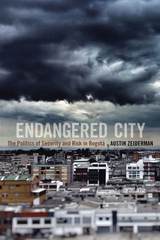 Endangered City: The Politics of Security and Risk in Bogotá
Austin Zeiderman
Duke University Press, 2016 Security and risk have become central to how cities are planned, built, governed, and inhabited in the twenty-first century. In Endangered City, Austin Zeiderman focuses on this new political imperative to govern the present in anticipation of future harm. Through ethnographic fieldwork and archival research in Bogotá, Colombia, he examines how state actors work to protect the lives of poor and vulnerable citizens from a range of threats, including environmental hazards and urban violence. By following both the governmental agencies charged with this mandate and the subjects governed by it, Endangered City reveals what happens when logics of endangerment shape the terrain of political engagement between citizens and the state. The self-built settlements of Bogotá’s urban periphery prove a critical site from which to examine the rising effect of security and risk on contemporary cities and urban life.
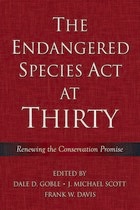 The Endangered Species Act at Thirty: Vol. 1: Renewing the Conservation Promise
Edited by Dale D. Goble, J. Michael Scott, and Frank W. Davis
Island Press, 2006 The Endangered Species Act at Thirty is a comprehensive, multidisciplinary review of issues surrounding the Endangered Species Act, with a specific focus on the act's actual implementation record over the past thirty years. The result of a unique, multi-year collaboration among stakeholder groups from across the political spectrum, the two volumes offer a dispassionate consideration of a highly polarized topic. Renewing the Conservation Promise, Volume 1, puts the reader in a better position to make informed decisions about future directions in biodiversity conservation by elevating the policy debate from its current state of divisive polemics to a more-constructive analysis. It helps the reader understand how the Endangered Species Act has been implemented, the consequences of that implementation, and how the act could be changed to better serve the needs of both the species it is designed to protect and the people who must live within its mandates. Volume 2, which examines philosophical, biological, and economic dimensions of the act in greater detail, will be published in 2006. As debate over reforming the Endangered Species Act heats up in the coming months, these two books will be essential references for policy analysts and lawmakers; professionals involved with environmental law, science, or management; and academic researchers and students concerned with environmental law, policy, management, or science.
The Endangered Species Act at Thirty: Vol. 2: Conserving Biodiversity in Human-Dominated Landscapes
Edited by J. Michael Scott, Dale D. Goble, and Frank W. Davis
Island Press, 2006 A companion volume to The Endangered Species Act at Thirty: Renewing the Conservation Promise, this book examines the key policy tools available for protecting biodiversity in the United States by revisiting some basic questions in conservation: What are we trying to protect and why? What are the limits of species-based conservation? Can we develop new conservation strategies that are more ecologically and economically viable than past approaches?
Endangered Species Recovery: Finding the Lessons, Improving the Process
Edited by Tim W. Clark, Richard P. Reading, and Alice L. Clarke
Island Press, 1994 Endangered Species Recovery presents case studies of prominent species recovery programs in an attempt to explore and analyze their successes, failures, and problems, and to begin to find ways of improving the process. It is the first effort to engage social scientists as well as biologists in a wide-ranging analysis and discussion of endangered species conservation, and provides valuable insight into the policy and implementation framework of species recovery programs. The book features a unique integration of case studies with theory, and provides sound, practical ideas for improving endangered species policy implementation.
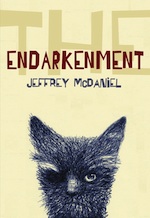 The Endarkenment
Jeffrey McDaniel
University of Pittsburgh Press, 2008 "Known for his commanding stage presence as a reader, McDaniel trades hard in his fourth book on his rough-and-tumble persona--a recovering addict from the working class streets--while also showing softer sides. McDaniel's sometimes awkward, if earnest searching might just be what allows him to find moments of great beauty, humor and stillness."
--Publishers Weekly
“McDaniel is known for his talent performing his poems, however his voice doesn’t lose its impact in written form. It may be more powerful because the reader can view the poet’s unique ideas and phrases over and over until their various meanings sink in.”
—Gently Read Literature
"McDaniel zings metaphors across the page like he's the Robin Williams of poetry. This collection in frequently moving and inventive with enough lightheartedness and whimsy to balance the heaviness of the darker moments."
--hipbooksterclub.com
Jeffrey McDaniel is the author of Alibi School, The Forgiveness Parade, and The Splinter Factory. His work has appeared in a number of anthologies, including Best American Poetry 1994, The Outlaw Bible of American Poetry, and New (American) Poets. He has won several awards, including an NEA Fellowship. He teaches creative writing at Sarah Lawrence College.
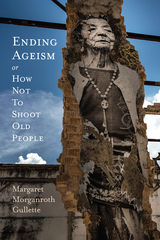 Ending Ageism, or How Not to Shoot Old People
Gullette, Margaret Morganroth
Rutgers University Press, 2017 Winner of the MLA Prize for Independent Scholars and the APA's Florence L. Denmark Award for Contributions to Women and Aging
When the term “ageism” was coined in 1969, many problems of exclusion seemed resolved by government programs like Social Security and Medicare. As people live longer lives, today’s great demotions of older people cut deeper into their self-worth and human relations, beyond the reach of law or public policy. In Ending Ageism, or How Not to Shoot Old People, award-winning writer and cultural critic Margaret Morganroth Gullette confronts the offenders: the ways people aging past midlife are portrayed in the media, by adult offspring; the esthetics and politics of representation in photography, film, and theater; and the incitement to commit suicide for those with early signs of “dementia.”
In this original and important book, Gullette presents evidence of pervasive age-related assaults in contemporary societies and their chronic affects. The sudden onset of age-related shaming can occur anywhere—the shove in the street, the cold shoulder at the party, the deaf ear at the meeting, the shut-out by the personnel office or the obtuseness of a government. Turning intimate suffering into public grievances, Ending Ageism, Or How Not to Shoot Old People effectively and beautifully argues that overcoming ageism is the next imperative social movement of our time. About the cover image: This elegant, dignified figure--Leda Machado, a Cuban old enough to have seen the Revolution--once the center of a vast photo mural, is now a fragment on a ruined wall. Ageism tears down the structures that all humans need to age well; to end it, a symbol of resilience offers us all brisk blue-sky energy.
“Leda Antonia Machado” from “Wrinkles of the City, 2012.”
Piotr Trybalski / Trybalski.com. Courtesy of the artist.
A Declaration of Grievances "A Declaration of Grievances" was written by Margaret Morganroth Gullette and is excerpted from her book Ending Ageism, or How Not to Shoot Old People (2017, Rutgers University Press). The poster was designed by Carolyn Kerchof. Print the PDF (make sure to click "fit to page") and hang the Declaration up in your home or place of work. Please share this link with other people you know who care about the rights of older persons. Share on social media with the hashtags #ADeclarationOfGrievances and #EndingAgeismGullette.
For more information, an excerpt, links to reviews, and special offers on this book, go to: https://www.rutgersuniversitypress.org/ending-ageism
Related website: (https://www.brandeis.edu/wsrc/scholars/profiles/gullette.html)
Ending Famine in India: A Transnational History of Food Aid and Development, c. 1890-1950
Joanna Simonow
Leiden University Press, 2023 The task of ending famine in India was taken up by many at the beginning of the twentieth century. Only decades earlier, famine in India had been believed to be a necessary evil. Now it was the reason for the increasing activities of doctors, nutritionists, social reformers, agricultural experts, missionaries, anti-colonial activists and colonial administrators, all involved in temporary relief and finding permanent solutions to famine.
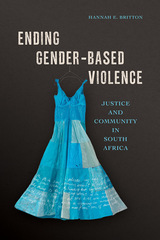 Ending Gender-Based Violence: Justice and Community in South Africa
Hannah E. Britton
University of Illinois Press, 2020 South African women's still-increasing presence in local, provincial, and national institutions has inspired sweeping legislation aimed at advancing women's rights and opportunity. Yet the country remains plagued by sexual assault, rape, and intimate partner violence. Hannah E. Britton examines the reasons gendered violence persists in relationship to social inequalities even after women assume political power. Venturing into South African communities, Britton invites service providers, religious and traditional leaders, police officers, and medical professionals to address gender-based violence in their own words. Britton finds the recent turn toward carceral solutions—with a focus on arrests and prosecutions—fails to address the complexities of the problem and looks at how changing specific community dynamics can defuse interpersonal violence. She also examines how place and space affect the implementation of policy and suggests practical ways policymakers can support street level workers. Clear-eyed and revealing, Ending Gender-Based Violence offers needed tools for breaking cycles of brutality and inequality around the world.
Ending Poverty As We Know It: Guaranteeing A Right To A Job
William P. Quigley
Temple University Press, 2003 Across the United States tens of millions of people are working forty or more hours a week...and living in poverty. This is surprising in a country where politicians promise that anyone who does their share, and works hard, will get ahead. In Ending Poverty As We Know It, William Quigley argues that it is time to make good on that promise by adding to the Constitution language that insures those who want to work can do so—and at a wage that enables them to afford reasonable shelter, clothing, and food.
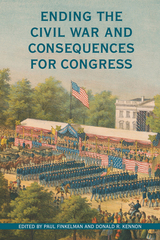 Ending the Civil War and Consequences for Congress
Paul Finkelman
Ohio University Press, 2019 The social changes and human and economic costs of the Civil War led to profound legal and constitutional developments after it ended, not least of which were the Fourteenth and Fifteenth Amendments and the many laws devised to protect the civil rights of newly freed African Americans. These amendments and laws worked for a while, but they were ineffective or ineffectively enforced for more than a century. In Ending the Civil War and the Consequences for Congress, contributors explore how the end of the war both continued the trauma of the conflict and enhanced the potential for the new birth of freedom that Lincoln promised in the Gettysburg Address. Collectively, they bring their multidisciplinary expertise to bear on the legal, economic, social, and political aspects of the aftermath of the war and Reconstruction era. The book concludes with the reminder of how the meaning of the war has changed over time. The Civil War is no longer the “felt” history it once was, Clay Risen reminds us, and despite the work of many fine scholars it remains contested. Contributors: Jenny Bourne, Carole Emberton, Paul Finkelman, Lorien Foote, William E. Nelson, Clay Risen, Anne Sarah Rubin, and Peter Wallenstein
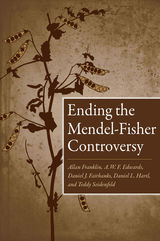 Ending the Mendel-Fisher Controversy
Allan Franklin
University of Pittsburgh Press, 2008 In 1865, Gregor Mendel presented “Experiments in Plant-Hybridization,” the results of his eight-year study of the principles of inheritance through experimentation with pea plants. Overlooked in its day, Mendel's work would later become the foundation of modern genetics. Did his pioneering research follow the rigors of real scientific inquiry, or was Mendel's data too good to be true-the product of doctored statistics?
In Ending the Mendel-Fisher Controversy, leading experts present their conclusions on the legendary controversy surrounding the challenge to Mendel's findings by British statistician and biologist R. A. Fisher. In his 1936 paper “Has Mendel's Work Been Rediscovered?” Fisher suggested that Mendel's data could have been falsified in order to support his expectations. Fisher attributed the falsification to an unknown assistant of Mendel's. At the time, Fisher's criticism did not receive wide attention. Yet beginning in 1964, about the time of the centenary of Mendel's paper, scholars began to publicly discuss whether Fisher had successfully proven that Mendel's data was falsified. Since that time, numerous articles, letters, and comments have been published on the controversy.
This self-contained volume includes everything the reader will need to know about the subject: an overview of the controversy; the original papers of Mendel and Fisher; four of the most important papers on the debate; and new updates, by the authors, of the latter four papers. Taken together, the authors contend, these voices argue for an end to the controversy-making this book the definitive last word on the subject.
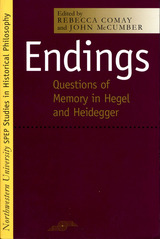 Endings: Questions of Memory in Hegel and Heidegger
Edited by Rebecca Comay and John McCumber
Northwestern University Press, 1999 In this collection of essays, leading scholars provide a variety of models from which to view the unique relationship between the bodies of thought of Heidegger and Hegel, revealing how these philosophers offer ways of thinking historically that understand such thinking not merely as extensions and elaborations of a given paradigm but as actively engaged in the critical and transformative revisioning of the world.
Beginning at the point where Heidegger encountered Hegel, this volume of provocative essays addresses the respective philosophies of the two men. Leading scholars provide a variety of models from which to view the unique relationship between the bodies of thought of Heidegger and Hegel: bodies of thought that cannot be taken as two objects to be compared, contrasted, and finally evaluated but that must be viewed in dynamic terms, as a relationship in which self-transformations lead to mutual transformations and vice versa.
 Endless Empire: Spain's Retreat, Europe's Eclipse, America's Decline
Edited by Alfred W. McCoy, Josep M. Fradera, and Stephen Jacobson
University of Wisconsin Press, 2012 Throughout four millennia of recorded history there has been no end to empire, but instead an endless succession of empires. After five centuries of sustained expansion, the half-dozen European powers that ruled half of humanity collapsed with stunning speed after World War II, creating a hundred emerging nations in Asia and Africa. Amid this imperial transition, the United States became the new global hegemon, dominating this world order with an array of power that closely resembled that of its European predecessors.
As Brazil, Russia, India, China, and the European Union now rise in global influence, twenty leading historians from four continents take a timely look backward and forward to discover patterns of eclipse in past empires that are already shaping a decline in U.S. global power, including:
• erosion of economic and fiscal strength needed for military power on a global scale
• misuse of military power through micro-military misadventures
• breakdown of alliances among major powers
• weakened controls over the subordinate elites critical for any empire’s exercise of global power
• insufficient technological innovation to sustain global force projection.
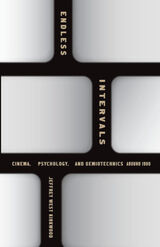 Endless Intervals: Cinema, Psychology, and Semiotechnics around 1900
Jeffrey West Kirkwood
University of Minnesota Press, 2022 Revealing cinema’s place in the coevolution of media technology and the human Cinema did not die with the digital, it gave rise to it. According to Jeffrey West Kirkwood, the notion that digital technologies replaced analog obscures how the earliest cinema laid the technological and philosophical groundwork for the digital world. In Endless Intervals, he introduces a theory of semiotechnics that explains how discrete intervals of machines came to represent something like a mind—and why they were feared for their challenge to the uniqueness of human intelligence. Examining histories of early cinematic machines, Kirkwood locates the foundations for a scientific vision of the psyche as well as the information age. He theorizes an epochal shift in the understanding of mechanical stops, breaks, and pauses that demonstrates how cinema engineered an entirely new model of the psyche—a model that was at once mechanical and semiotic, discrete and continuous, physiological and psychological, analog and digital. Recovering largely forgotten and untranslated texts, Endless Intervals makes the case that cinema, rather than being a technology assaulting the psyche, is in fact the technology that produced the modern psyche. Kirkwood considers the ways machines can create meaning, offering a fascinating theory of how the discontinuous intervals of soulless mechanisms ultimately produced a rich continuous experience of inner life.
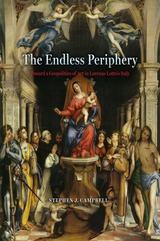 The Endless Periphery: Toward a Geopolitics of Art in Lorenzo Lotto's Italy
Stephen J. Campbell
University of Chicago Press, 2019 While the masterpieces of the Italian Renaissance are usually associated with Italy’s historical seats of power, some of the era’s most characteristic works are to be found in places other than Florence, Rome, and Venice. They are the product of the diversity of regions and cultures that makes up the country. In Endless Periphery, Stephen J. Campbell examines a range of iconic works in order to unlock a rich series of local references in Renaissance art that include regional rulers, patron saints, and miracles, demonstrating, for example, that the works of Titian spoke to beholders differently in Naples, Brescia, or Milan than in his native Venice. More than a series of regional microhistories, Endless Periphery tracks the geographic mobility of Italian Renaissance art and artists, revealing a series of exchanges between artists and their patrons, as well as the power dynamics that fueled these exchanges. A counter history of one of the greatest epochs of art production, this richly illustrated book will bring new insight to our understanding of classic works of Italian art.
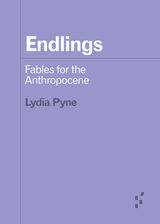 Endlings: Fables for the Anthropocene
Lydia Pyne
University of Minnesota Press, 2022 Amid the historical decimation of species around the globe, a new way into the language of loss
An endling is the last known individual of a species; when that individual dies, the species becomes extinct. These “last individuals” are poignant characters in the stories that humans tell themselves about today’s Anthropocene. In this evocative work, Lydia Pyne explores how discussion about endlings—how we tell their histories—draws on deep traditions of storytelling across a variety of narrative types that go well beyond the science of these species’ biology or their evolutionary history. Endlings provides a useful and thoughtful discussion of species concepts: how species start and how (and why) they end, what it means to be a “charismatic” species, the effects of rewilding, and what makes species extinction different in this era. From Benjamin the thylacine to Celia the ibex to Lonesome George the Galápagos tortoise, endlings, Pyne shows, have the power to shape how we think about grief, mourning, and loss amid the world’s sixth mass extinction.
 Endocrinology of Social Relationships
Peter T. Ellison
Harvard University Press, 2012 In social relationships—whether between mates, parents and offspring, or friends—we find much of life’s meaning. But in these relationships, so critical to our well-being, might we also detect the workings, even directives, of biology? This book, a rare melding of human and animal research and theoretical and empirical science, ventures into the most interesting realms of behavioral biology to examine the intimate role of endocrinology in social relationships.
The importance of hormones to reproductive behavior—from breeding cycles to male sexual display—is well known. What this book considers is the increasing evidence that hormones are just as important to social behavior. Peter Ellison and Peter Gray include the latest findings—both practical and theoretical—on the hormonal component of both casual interactions and fundamental bonds. The contributors, senior scholars and rising scientists whose work is shaping the field, go beyond the proximate mechanics of neuroendocrine physiology to integrate behavioral endocrinology with areas such as reproductive ecology and life history theory. Ranging broadly across taxa, from birds and rodents to primates, the volume pays particular attention to human endocrinology and social relationships, a focus largely missing from most works of behavioral endocrinology.
Endquote: Sots-Art Literature and Soviet Grand Style
Marina Balina, Nancy Condee, and Evgeny Dobrenko
Northwestern University Press, 1999 Sots-art, the mock use of the Soviet ideological clichés of mass culture, originated in Soviet nonconformist art of the early 1970s. An original and provocative guide, Endquote: Sots-Art Literature and Soviet Grand Style examines the conceptual aspect of sots-art, sots-art poetry, and sots-art prose, and discusses where these still-vital intellectual currents may lead.
Ends in Sight: Marx/Fukuyama/Hobsbawm/Anderson
Gregory Elliott
Pluto Press, 2008 Following the disappearance of the Soviet Union, scholars across the political spectrum tackled the world-historical significance of the end of communism. This book addresses the balance-sheets of modern political history offered by three writers---Francis Fukuyama, Eric Hobsbawm and Perry Anderson---comparing them with the future projected by Marx in The Communist Manifesto.
Gregory Elliott argues that Marx is central to all three accounts and that, along with the Manifesto, they form a quartet of analyses of the results and prospects of capitalism and socialism, which are of enduring significance for the Left.
Senses of an Ending provides a readable survey of key historical and political thinkers that will appeal to anyone interested in modern political thought.
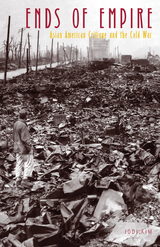 Ends of Empire: Asian American Critique and the Cold War
Jodi Kim
University of Minnesota Press, 2010 Ends of Empire examines Asian American cultural production and its challenge to the dominant understanding of American imperialism, Cold War dynamics, and race and gender formation. Jodi Kim demonstrates the degree to which Asian American literature and film critique the record of U.S. imperial violence in Asia and provides a glimpse into the imperial and gendered racial logic of the Cold War. She unfolds this particularly entangled and enduring episode in the history of U.S. global hegemony—one that, contrary to leading interpretations of the Cold War as a simple bipolar rivalry, was significantly triangulated in Asia. The Asian American works analyzed here constitute a crucial body of what Kim reveals as transnational “Cold War compositions,” which are at once a geopolitical structuring, an ideological writing, and a cultural imagining. Arguing that these works reframe the U.S. Cold War as a project of gendered racial formation and imperialism as well as a production of knowledge, Ends of Empire offers an interdisciplinary investigation into the transnational dimensions of Asian America and its critical relationship to Cold War history.
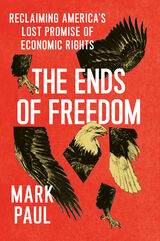 The Ends of Freedom: Reclaiming America's Lost Promise of Economic Rights
Mark Paul
University of Chicago Press, 2023 An urgent and galvanizing argument for an Economic Bill of Rights—and its potential to confer true freedom on all Americans.
Since the Founding, Americans have debated the true meaning of freedom. For some, freedom meant the provision of life’s necessities, those basic conditions for the “pursuit of happiness.” For others, freedom meant the civil and political rights enumerated in the Bill of Rights and unfettered access to the marketplace—nothing more. As Mark Paul explains, the latter interpretation—thanks in large part to a particularly influential cadre of economists—has all but won out among policymakers, with dire repercussions for American society: rampant inequality, endemic poverty, and an economy built to benefit the few at the expense of the many.
In this book, Paul shows how economic rights—rights to necessities like housing, employment, and health care—have been a part of the American conversation since the Revolutionary War and were a cornerstone of both the New Deal and the Civil Rights Movement. Their recuperation, he argues, would at long last make good on the promise of America’s founding documents. By drawing on FDR’s proposed Economic Bill of Rights, Paul outlines a comprehensive policy program to achieve a more capacious and enduring version of American freedom. Among the rights he enumerates are the right to a good job, the right to an education, the right to banking and financial services, and the right to a healthy environment.
Replete with discussions of some of today’s most influential policy ideas—from Medicare for All to a federal job guarantee to the Green New Deal—The Ends of Freedom is a timely and urgent call to reclaim the idea of freedom from its captors on the political right—to ground America’s next era in the country’s progressive history and carve a path toward a more economically dynamic and equitable nation.
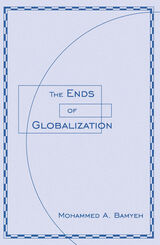 Ends Of Globalization
Mohammed A. Bamyeh
University of Minnesota Press, 2000 A uniquely broad perspective that challenges current ideas about worldwide cultural and political change. Political and Social Theory/Cultural Studies A uniquely broad perspective that challenges current ideas about worldwide cultural and political change. An intervention into current debates about globalization, nationalism, imperialism, and culture, this book offers a cogent critique of much of what is being said about globalization, by both the Right and the Left. In doing so, it charts the complex processes of globalization, drawing out their historical and philosophical roots and outlining the connections between cultural, political, and economic life that globalization has made, historically and in our day.The author’s orientation toward political theory and comparative civilizations-a rarity in globalization studies-allows him to detect in specific terms what is most dangerous and opportune in what is happening in the world today. Mohammed A. Bamyeh makes a compelling argument that we are witnessing a process typified by massive disjunctions between political, cultural, and economic logics on a world scale. Bamyeh demonstrates how the disruptions caused by globalization, while they blur our vision and block our rational approaches, also possess the potential to liberate the autonomous and convivial human possibilities and capabilities long shackled by such modernist institutions of governance as the nation-state.Translation Inquiries: University of Minnesota Press
The Ends of Human Life: Medical Ethics in a Liberal Polity
Ezekiel J. Emanuel
Harvard University Press, 1991 Ezekiel Emanuel, trained as both a physician and a political theorist, rejects the claim that most of today’s dilemmas of medical ethics are created by advances in medical technology. He maintains that the seemingly endless debates are the inevitable consequence of liberal political values. He proposes an alternative ideology, a liberal communitarianism that imagines a federation of political communities dedicated to democratic deliberations to guide the formulation of laws and policies.
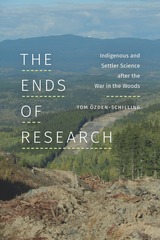 The Ends of Research: Indigenous and Settler Science after the War in the Woods
Tom Özden-Schilling
Duke University Press, 2023 In The Ends of Research Tom Özden-Schilling explores the afterlives of several research initiatives that emerged in the wake of the “War in the Woods,” a period of anti-logging blockades in Canada in the late twentieth century. Drawing on ethnographic fieldwork among neighboring communities of White environmental scientists and First Nations mapmakers in northwest British Columbia, Özden-Schilling examines these researchers’ lasting investments and the ways they struggle to continue their work long after the loss of government funding. He charts their use of planning documents, Indigenous territory maps, land use plots, reports, and other documents that help them not only to survive institutional restructuring but to hold on to the practices that they hope will enable future researchers to continue their work. He also shows how their lives and aspirations shape and are shaped by decades-long battles over resource extraction and Indigenous land claims. By focusing on researchers’ experiences and personal attachments, Özden-Schilling illustrates the complex relationships between researchers and rural histories of conservation, environmental conflict, resource extraction, and the long-term legacies of scientific research.
The Ends of the Earth
Roger Willemsen
Haus Publishing, 2010 An author, foreign correspondent, academic, and television personality, Roger Willemsen is a familiar figure in Germany, and The Ends of the Earth offers English-language readers a chance to engage with his uniquely astute take on the world. Consisting of twenty-two essays recounting and reflecting on a lifetime of travel to the far and forgotten corners of our planet, the book offers remarkable encounters and mysterious entanglements in locations as diverse as a Kamchatkan volcano, a Burmese railway station, an Arctic icebreaker, and a Minsk hospital ward. Willemsen is the perfect companion, reveling in the strange and unlovely, and tracing unexpected connections among places, times, and peoples.
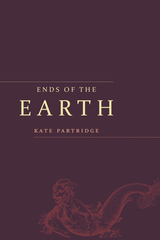 Ends of the Earth: Poems
Kate Partridge
University of Alaska Press, 2017 Ends of the Earth uses the landscape of Alaska as a testing ground for love and elegy. It is a poetry collection that contains both lyric responses to the urban Alaska environment and extended sequences that cycle between autobiography, mythic allusion, and the literary archive. In her work, Kate Partridge combines the fresh perspective of a newcomer with explorations of the landscape and lifestyles through allusions to classic literature.
While the poems turn an inquisitive, contemporary lens to the subject of Alaska, elements throughout the book are influenced by twentieth-century writers like Elizabeth Bishop and Marianne Moore. The manuscript also combines personal experience with collaged material from the Epic of Gilgamesh, Walt Whitman's notebooks, and other classic sources, to investigate the ideas of love, isolation, and location. Through humor and observation, Partridge takes a new look at what it means to live in urban Alaska and the world at large.
|
|

